Paul van Yperen's Blog, page 94
March 7, 2023
Lois Wilson
Lois Wilson (1894-1988) was an American screen and stage actress who played in about 150 silent films. She was directed by Lois Weber, William C. de Mille and James Cruze. She was often cast as the romantic woman and 'the marrying kind', though she didn't marry in real life.

Danish postcard by J. Chr. Olsens Kunstforlag. Eneret, no. 454.
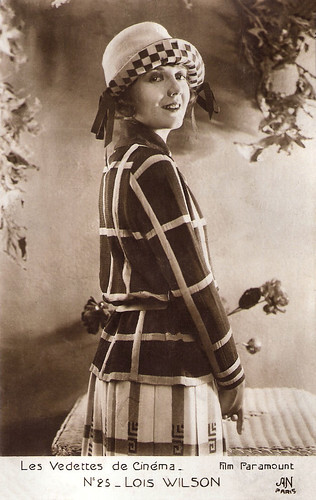
French postcard in the Les vedettes de cinéma series by A.N., Paris, no. 25. Photo: Paramount.
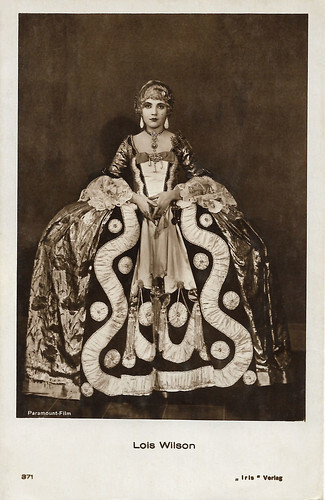
Austrian postcard by Iris Verlag, no. 371. Photo: Paramount-Film. Lois Wilson in Monsieur Beaucaire (Sidney Olcott, 1924).
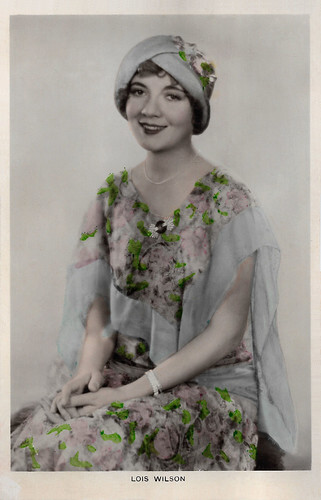
British postcard in the Colourgraph Series, London, no. C 45.
WAMPAS Baby Star of 1922
Lois Wilson was born in 1894 in Pittsburgh, Penn., and grew up in Alabama. In 1915, she won a beauty contest, set up by Universal Studios.
She came into contact with acting and got small roles in films such as The Dumb Girl Of Portici (Lois Weber, 1916). Under the guidance of Weber, she grew as an actress and moved to Los Angeles.
Wilson acted in films from different studios, before getting a contract with Paramount Pictures in 1919. Her contract did not expire until 1927. In 1922 she was named one of the WAMPAS Baby Stars and all in all she played in about 150 films, but many of her films got lost, especially the ones from before the mid-1920s.
Wilson played the title role in two remarkable still-existing films by William C. de Mille. The first was Midsummer Madness (William C. De Mille, 1920), with Jack Holt and Conrad Nagel.
The other film was the silent comedy-drama Miss Lulu Bett (William C. de Mille, 1921), about a once-timid young woman who gains newfound confidence after a failed marriage, much to the chagrin of her miserable family. The latter film co-starred Milton Sills , Theodore Roberts and Mabel van Buren.

Spanish collectors card in the series 'Los artistas cinematograficos en la intimidad' by Amatller, Barcelona, Series A. Left to right: Thomas Meighan , Jeanie MacPherson, Lois Wilson, Cecil B. DeMille , Conrad Nagel , and Gloria Swanson . The photo was made during a visit to Nagel's villa, part of one of the biggest acacia plantations in California.
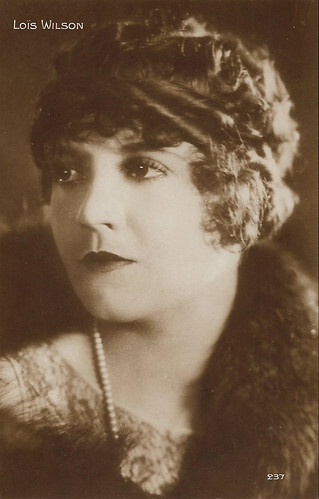
French postcard by Editions Cinémagazine, no. 237.
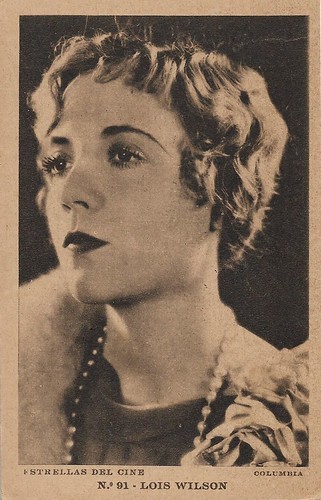
Spanish postcard in the Estrellas del cine series by Editorial Grafica, Barcelona, no. 91. Photo: Columbia Pictures.
An apocalyptic Science-Fiction film
Lois Wilson appeared as Molly Wingate opposite J. Warren Kerrigan in the epic Western The Covered Wagon (James Cruze, 1923) and as Daisy Buchanan in The Great Gatsby (Herbert Brenon, 1926), the latter is a lost film.
Wilson played against big names, including Richard Dix in three silent films: To the Last Man (Victor Fleming, 1923), The Call of the Canyon (Victor, Fleming 1923), and The Vanishing American (George B. Seitz, 1925). Of the latter, film historian Kevin Brownlow wrote: "The problem of the Indian and his betrayal by the government was more clearly etched in this picture than in any other silent film."
Wilson also co-acted with silent stars Rudolph Valentino in Monsieur Beaucaire (Sidney Olcott, 1924), and John Gilbert in One Dollar Bid (Ernest C. Warde, 1918). She was often cast as the romantic woman and 'the marrying kind', though she didn't marry in real life.
The transition to the sound film seemed promising for Wilson. She starred in films such as Lovin' the Ladies (Melville Brown, 1930) with Richard Dix , Seed (John Stahl, 1931) with John Boles and Genevieve Tobin and was the co-star in the apocalyptic Science-Fiction film Deluge (Felix Feist, 1933).
Wilson's parts became smaller after the early 1930s, working for Universal and B-movie companies like Republic. She became disappointed and eventually retired in 1941. After this, she did mainly theatre work, including Broadway, and television. From 1954 to 1955 she was seen in the soap opera Guiding Light. In 1988 Lois Wilson died of pneumonia at the Riverside Hospital for Skilled Care in Reno, Nevada at the age of 93.
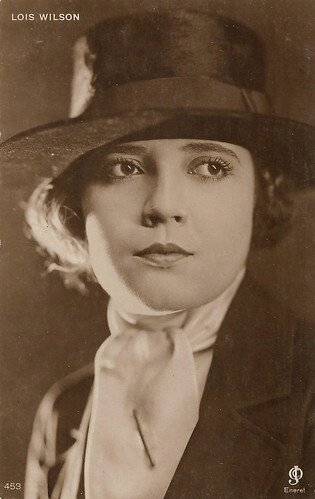
Danish postcard by J.Chr. Olsens Kunstforlag, Eneret, no. 453.
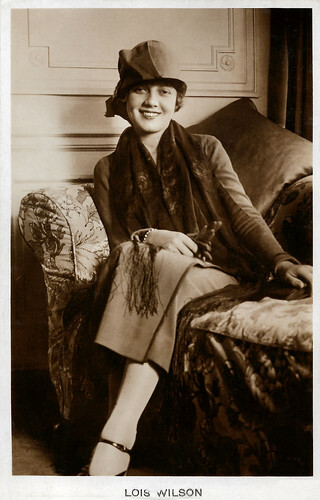
British Real Photograph postcard.
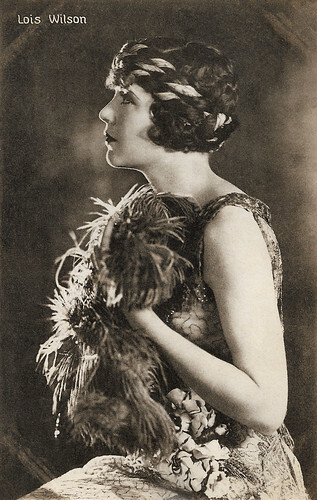
Danish postcard by Stenders Kunstforlag, no. 32. Photo: Famous Players-Lasky Corporation.
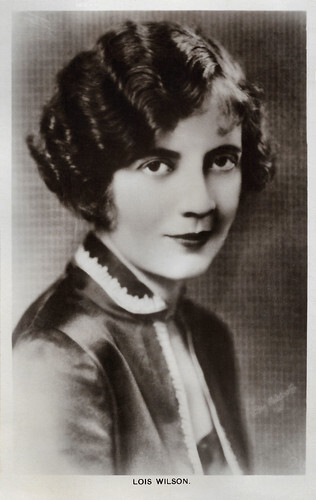
British postcard in the Picturegoer Series, London, no. 91b.
Sources: Wikipedia (English, German and Dutch) and .

Danish postcard by J. Chr. Olsens Kunstforlag. Eneret, no. 454.

French postcard in the Les vedettes de cinéma series by A.N., Paris, no. 25. Photo: Paramount.

Austrian postcard by Iris Verlag, no. 371. Photo: Paramount-Film. Lois Wilson in Monsieur Beaucaire (Sidney Olcott, 1924).

British postcard in the Colourgraph Series, London, no. C 45.
WAMPAS Baby Star of 1922
Lois Wilson was born in 1894 in Pittsburgh, Penn., and grew up in Alabama. In 1915, she won a beauty contest, set up by Universal Studios.
She came into contact with acting and got small roles in films such as The Dumb Girl Of Portici (Lois Weber, 1916). Under the guidance of Weber, she grew as an actress and moved to Los Angeles.
Wilson acted in films from different studios, before getting a contract with Paramount Pictures in 1919. Her contract did not expire until 1927. In 1922 she was named one of the WAMPAS Baby Stars and all in all she played in about 150 films, but many of her films got lost, especially the ones from before the mid-1920s.
Wilson played the title role in two remarkable still-existing films by William C. de Mille. The first was Midsummer Madness (William C. De Mille, 1920), with Jack Holt and Conrad Nagel.
The other film was the silent comedy-drama Miss Lulu Bett (William C. de Mille, 1921), about a once-timid young woman who gains newfound confidence after a failed marriage, much to the chagrin of her miserable family. The latter film co-starred Milton Sills , Theodore Roberts and Mabel van Buren.

Spanish collectors card in the series 'Los artistas cinematograficos en la intimidad' by Amatller, Barcelona, Series A. Left to right: Thomas Meighan , Jeanie MacPherson, Lois Wilson, Cecil B. DeMille , Conrad Nagel , and Gloria Swanson . The photo was made during a visit to Nagel's villa, part of one of the biggest acacia plantations in California.

French postcard by Editions Cinémagazine, no. 237.

Spanish postcard in the Estrellas del cine series by Editorial Grafica, Barcelona, no. 91. Photo: Columbia Pictures.
An apocalyptic Science-Fiction film
Lois Wilson appeared as Molly Wingate opposite J. Warren Kerrigan in the epic Western The Covered Wagon (James Cruze, 1923) and as Daisy Buchanan in The Great Gatsby (Herbert Brenon, 1926), the latter is a lost film.
Wilson played against big names, including Richard Dix in three silent films: To the Last Man (Victor Fleming, 1923), The Call of the Canyon (Victor, Fleming 1923), and The Vanishing American (George B. Seitz, 1925). Of the latter, film historian Kevin Brownlow wrote: "The problem of the Indian and his betrayal by the government was more clearly etched in this picture than in any other silent film."
Wilson also co-acted with silent stars Rudolph Valentino in Monsieur Beaucaire (Sidney Olcott, 1924), and John Gilbert in One Dollar Bid (Ernest C. Warde, 1918). She was often cast as the romantic woman and 'the marrying kind', though she didn't marry in real life.
The transition to the sound film seemed promising for Wilson. She starred in films such as Lovin' the Ladies (Melville Brown, 1930) with Richard Dix , Seed (John Stahl, 1931) with John Boles and Genevieve Tobin and was the co-star in the apocalyptic Science-Fiction film Deluge (Felix Feist, 1933).
Wilson's parts became smaller after the early 1930s, working for Universal and B-movie companies like Republic. She became disappointed and eventually retired in 1941. After this, she did mainly theatre work, including Broadway, and television. From 1954 to 1955 she was seen in the soap opera Guiding Light. In 1988 Lois Wilson died of pneumonia at the Riverside Hospital for Skilled Care in Reno, Nevada at the age of 93.

Danish postcard by J.Chr. Olsens Kunstforlag, Eneret, no. 453.

British Real Photograph postcard.

Danish postcard by Stenders Kunstforlag, no. 32. Photo: Famous Players-Lasky Corporation.

British postcard in the Picturegoer Series, London, no. 91b.
Sources: Wikipedia (English, German and Dutch) and .
Published on March 07, 2023 22:00
March 6, 2023
Anita Berber
Expressionistic dancer and film actress Anita Berber (1899–1928) challenged many taboos during the Weimar period. With her drugs and alcohol addictions, her scandalous hotel orgies and her bisexual affairs, she epitomised the decadence of 1920s Berlin. Her charcoaled eyes, her black lipstick and her bright red, bobbed hair were featured in a famous portrait of her by Otto Dix and in silent films by Richard Oswald and Fritz Lang.
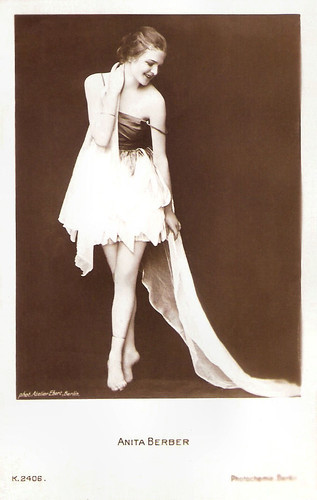
German postcard by Photochemie, Berlin, no. K. 2406. Photo: Atelier Ebert, Berlin.
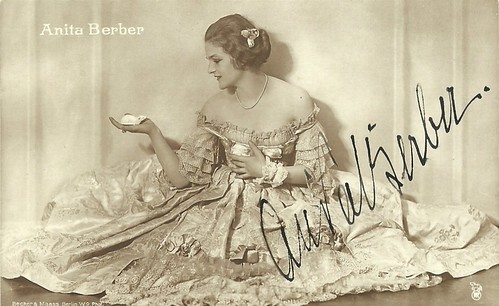
German postcard by Rotophot in the Film Sterne series. Photo: Becker & Maass. Collection: Didier Hanson.
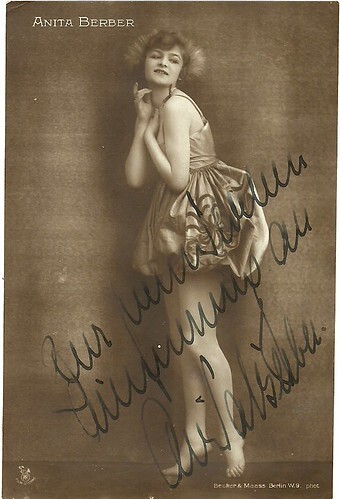
German postcard by Rotophot in the Film Sterne series. Photo: Becker & Maass. Collection: Didier Hanson.
Sex Education Films
Anita Berber was born in Leipzig (some sources say Dresden), Imperial Germany in 1899. She was the daughter of Felix Berber, a classical violinist and his wife Lucie Berber, a cabaret singer. Her parents divorced two years later and Anita was raised mainly by her grandmother in Dresden. In her teens, she studied dance under founder of rhythmic gymnastics Emile Jacques-Dalcroze and ballet teacher and film actress Rita Sacchetto . By the age of 16, she made her debut as a cabaret dancer in Berlin, and began modelling for the women's magazines Die Dame and Elegante Welte.
Between 1918 and 1925, she appeared in more than 20 silent films. She often worked for director Richard Oswald. Their films included the Aufklärungsfilm (sex education film) Die Prostitution, 1. Teil - Das gelbe Haus/Prostitution (Richard Oswald, 1919), the adventure comedy Die Reise um die Erde in 80 Tagen/Around the World in Eighty Days (Richard Oswald, 1919) with rising-star Conrad Veidt as Phileas Fogg, and the fantasy thriller Unheimliche Geschichten/Sinister Tales (Richard Oswald, 1919).
She also played in the horror film Nachtgestalten/Figures of the Night (Richard Oswald, 1920) starring Paul Wegener , and the drama Lucrezia Borgia/Lucretia Borgia (Richard Oswald, 1922) starring Liane Haid .
Alongside Conrad Veidt , Anita Berber also appeared as Else in the ground-breaking, gay-themed film Anders als die Anderen/Different From The Others (Richard Oswald, 1919), co-written by Dr. Magnus Hirschfeld. Berber had a minor but significant role in Fritz Lang's Dr. Mabuse, der Spieler - Ein Bild der Zeit/Dr. Mabuse – The Gambler (Fritz Lang, 1922) featuring Rudolph Klein-Rogge as the arch-criminal.
Berber also appeared in the horror film Der Graf von Cagliostro/The Count of Cagliostro ( Reinhold Schünzel , 1920), Wien, du Stadt der Lieder/Vienna, City of Song (Alfred Deutsch-German, 1923) and finally in Ein Walzer von Strauß/A Strauss Waltz (Max Neufeld, 1925).
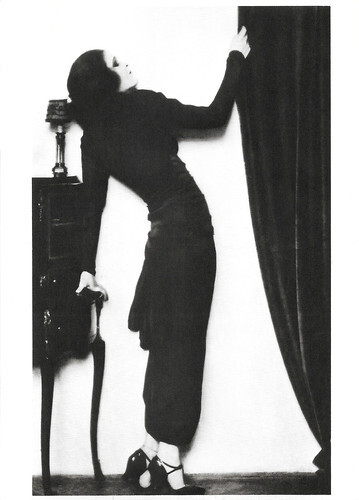
West German postcard by Gebr. König Postkartenverlag, Köln (Cologne), Serie 103, no. 1 of 10. Photo: collection: L. Fischer.
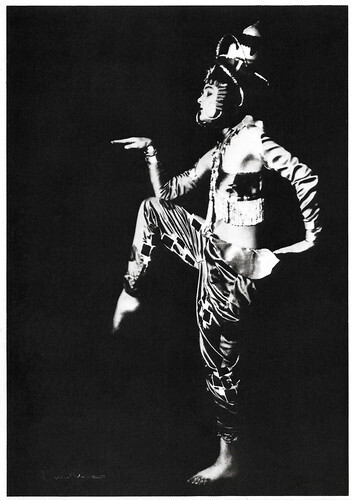
West German postcard by Gebr. König Postkartenverlag, Köln (Cologne), Serie 103, no. 2 of 10. Photo: Alex Binder. Anita Berber in 'Koreanischer Tanz' (Korean Dance).
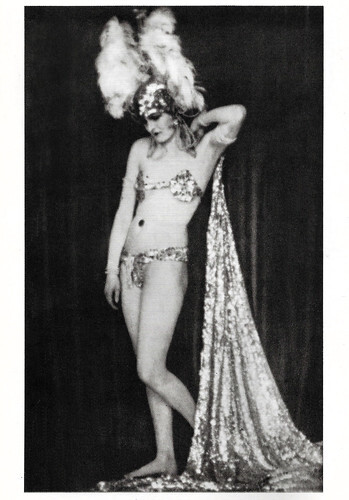
West German postcard by Gebr. König Postkartenverlag, Köln (Cologne), Serie 103, no. 3 of 10. Photo: Dora Kalmus. Anita Berber in dance costume 'Hellogabal', 1922.
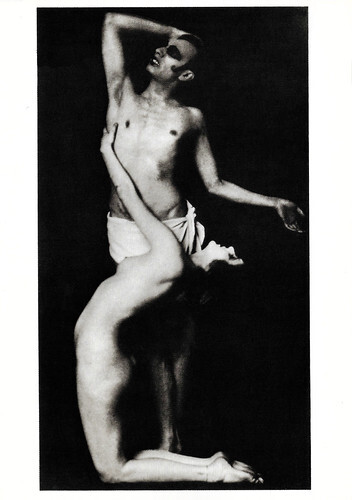
West German postcard by Gebr. König Postkartenverlag, Köln (Cologne), Serie 103, no. 5 of 10. Photo: Dora Kalmus. Anita Berber and Sebastian Droste in a scene from the dance production 'Martyren' (1922).
Scandalously Androgynous
Anita Berber began dancing nude in 1919. Scandalously androgynous, she quickly made a name for herself. She wore heavy dancer's make-up, which on the black-and-white photos and films of the time came across as jet black lipstick painted across the heart-shaped part of her skinny lips, and charcoaled eyes. She had cut her auburn hair fashionably into a short bob as can be seen in Otto Dix’ iconic painting 'Die Tänzerin Anita Berber' (The Dancer Anita Berber) (1925).
Her dance partner was the expressionist poet Sebastian Droste, who also became her second husband. He was skinny and had black hair with gelled-up curls much like sideburns. During their dances, neither of them wore much more than low-slung loincloths and Anita occasionally a corsage worn well below her small breasts. They performed fantasias with titles such as 'Suicide', 'Morphium', and 'Mad House'.
In 1923, they published a book of poetry, photographs, and drawings called 'Die Tänze des Lasters, des Grauens und der Ekstase' (Dances of Vice, Horror, and Ecstasy), based on their performance of the same name. Full of Expressionist imagery, the book offers a glimpse into the angst and cynicism shadowing their artistic and personal existences.
Ruth M. Perris at lghbtq.com : “She brought flamboyant eroticism, exotic costuming, and grotesque imagery to performances danced to the music of composers such as Debussy, Strauss, Delibes, and Saint-Säens.
A pioneer of modern expressive dance, Berber was at first taken seriously as an artist, but soon she became better known for her scandalous personal and professional life.”
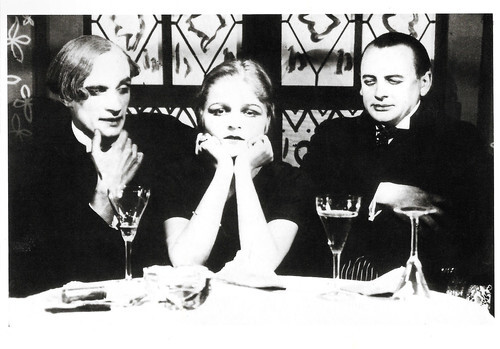
West German postcard by Gebr. König Postkartenverlag, Köln (Cologne), Serie 103, no. 7 of 10. Photo: Collection L. Fischer. Anita Berber, Conrad Veidt and Reinhold Schünzel in Unheimliche Geschichten/Sinister Tales (Richard Oswald, 1919).
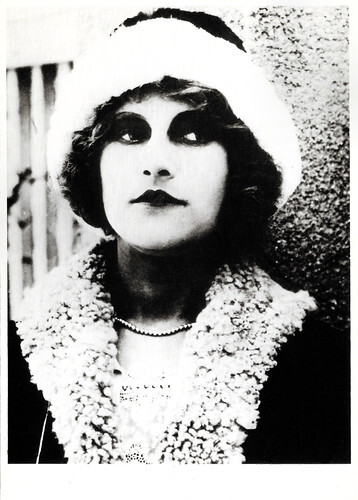
West German postcard by Gebr. König Postkartenverlag, Köln (Cologne), Serie 103, no. 8 of 10. Anita Berber in Die vom Zirkus/Those from the circus (William Kahn, 1922).

West German postcard by Gebr. König Postkartenverlag, Köln (Cologne), Serie 103, no. 9 of 10. Photo: Collection L. Fischer. Anita Berber in Irrlichte der Tiefe/Lights of the abyss (Fritz Freisler, 1923).
Tabloid Reports Of Lesbianism, Drug Use, And Hotel Orgies
Anita Berber married three times. Her first husband was the wealthy young screenwriter Eberhard von Nathusius. After their divorce, she dated a string of beautiful women, including, allegedly, the young Marlene Dietrich . Stylish bar owner Susi Wanowski became her lover, manager and secretary. Her second marriage to Sebastian Droste ended in 1923. The following year, she married American dancer Henri Chatin-Hoffman, rumoured to be gay. She toured Europe with him, continually generating tabloid reports of lesbianism, drug use, and hotel orgies.
After a tour of The Netherlands in 1926, Berber collapsed physically and sought refuge with Dr. Magnus Hirschfeld. She was addicted to cocaine, opium and morphine. According to Wikipedia , “one of Berber's favourites was chloroform and ether mixed in a bowl. This would be stirred with a white rose, the petals of which she would then eat.” Aside from her addiction to narcotic drugs, she was also a heavy alcoholic. In early 1928, Anita Berber suddenly gave up alcohol completely.
According to Mel Gordon, in The Seven Addictions and Five Professions of Anita Berber: Weimar Berlin's Priestess of Debauchery , she was diagnosed with severe tuberculosis while performing in nightclubs in Greece and the Middle East. After collapsing during a performance in Damascus, she returned to Germany.
Anita Berber died in a Kreuzberg hospital in November 1928, just 29. She was said to be surrounded by empty morphine syringes and was buried in a pauper's grave in St. Thomas Cemetery in Neukölln.
Although her gravestone vanished, Anita Berber has not been forgotten. Rosa von Praunheim’s wonderful film Anita - Tänze des Lasters/Anita - Dances of Vice (1987) centres around the life of Anita Berber. In 1991, the Deutsche Post used the Otto Dix painting of Anita on one of its stamps.
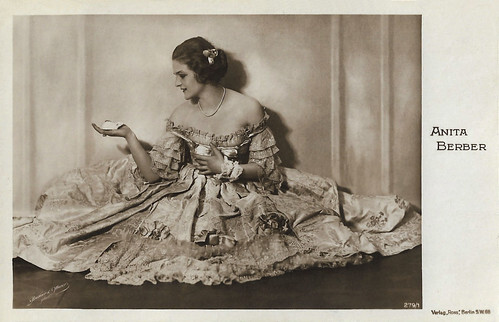
German postcard by Verlag Ross, Berlin, no. 279/1. Photo: Becker & Maass.
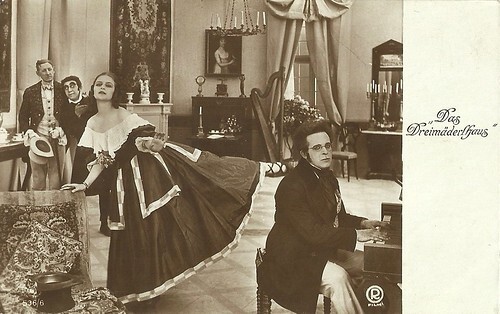
German postcard in the Film Sterne series by Rotophot, no. 563/6. Photo: Richard-Oswald-Film. Anita Berber and Julius Spielmann in the German silent film Das Dreimäderlhaus/The House of Three Girls (Richard Oswald, 1918), considered a lost film and dealing with the life of composer Franz Schubert (Julius Spielmann, the man with spectacles at the right).
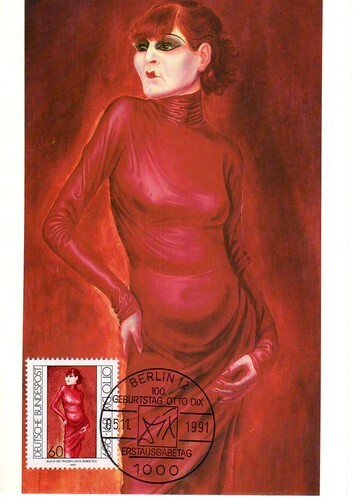
Postcard and stamp of ‘Die Tänzerin Anita Berber' by Otto Dix. Collection: Sidolix@Flickr.
Sources: Mel Gordon (The Seven Addictions and Five Professions of Anita Berber: Weimar Berlin's Priestess of Debauchery), Ruth M. Pettis (glbtq.com - now defunct), James Conway (Strange Flowers), Cabaret Berlin, Wikipedia and .

German postcard by Photochemie, Berlin, no. K. 2406. Photo: Atelier Ebert, Berlin.

German postcard by Rotophot in the Film Sterne series. Photo: Becker & Maass. Collection: Didier Hanson.

German postcard by Rotophot in the Film Sterne series. Photo: Becker & Maass. Collection: Didier Hanson.
Sex Education Films
Anita Berber was born in Leipzig (some sources say Dresden), Imperial Germany in 1899. She was the daughter of Felix Berber, a classical violinist and his wife Lucie Berber, a cabaret singer. Her parents divorced two years later and Anita was raised mainly by her grandmother in Dresden. In her teens, she studied dance under founder of rhythmic gymnastics Emile Jacques-Dalcroze and ballet teacher and film actress Rita Sacchetto . By the age of 16, she made her debut as a cabaret dancer in Berlin, and began modelling for the women's magazines Die Dame and Elegante Welte.
Between 1918 and 1925, she appeared in more than 20 silent films. She often worked for director Richard Oswald. Their films included the Aufklärungsfilm (sex education film) Die Prostitution, 1. Teil - Das gelbe Haus/Prostitution (Richard Oswald, 1919), the adventure comedy Die Reise um die Erde in 80 Tagen/Around the World in Eighty Days (Richard Oswald, 1919) with rising-star Conrad Veidt as Phileas Fogg, and the fantasy thriller Unheimliche Geschichten/Sinister Tales (Richard Oswald, 1919).
She also played in the horror film Nachtgestalten/Figures of the Night (Richard Oswald, 1920) starring Paul Wegener , and the drama Lucrezia Borgia/Lucretia Borgia (Richard Oswald, 1922) starring Liane Haid .
Alongside Conrad Veidt , Anita Berber also appeared as Else in the ground-breaking, gay-themed film Anders als die Anderen/Different From The Others (Richard Oswald, 1919), co-written by Dr. Magnus Hirschfeld. Berber had a minor but significant role in Fritz Lang's Dr. Mabuse, der Spieler - Ein Bild der Zeit/Dr. Mabuse – The Gambler (Fritz Lang, 1922) featuring Rudolph Klein-Rogge as the arch-criminal.
Berber also appeared in the horror film Der Graf von Cagliostro/The Count of Cagliostro ( Reinhold Schünzel , 1920), Wien, du Stadt der Lieder/Vienna, City of Song (Alfred Deutsch-German, 1923) and finally in Ein Walzer von Strauß/A Strauss Waltz (Max Neufeld, 1925).

West German postcard by Gebr. König Postkartenverlag, Köln (Cologne), Serie 103, no. 1 of 10. Photo: collection: L. Fischer.

West German postcard by Gebr. König Postkartenverlag, Köln (Cologne), Serie 103, no. 2 of 10. Photo: Alex Binder. Anita Berber in 'Koreanischer Tanz' (Korean Dance).

West German postcard by Gebr. König Postkartenverlag, Köln (Cologne), Serie 103, no. 3 of 10. Photo: Dora Kalmus. Anita Berber in dance costume 'Hellogabal', 1922.

West German postcard by Gebr. König Postkartenverlag, Köln (Cologne), Serie 103, no. 5 of 10. Photo: Dora Kalmus. Anita Berber and Sebastian Droste in a scene from the dance production 'Martyren' (1922).
Scandalously Androgynous
Anita Berber began dancing nude in 1919. Scandalously androgynous, she quickly made a name for herself. She wore heavy dancer's make-up, which on the black-and-white photos and films of the time came across as jet black lipstick painted across the heart-shaped part of her skinny lips, and charcoaled eyes. She had cut her auburn hair fashionably into a short bob as can be seen in Otto Dix’ iconic painting 'Die Tänzerin Anita Berber' (The Dancer Anita Berber) (1925).
Her dance partner was the expressionist poet Sebastian Droste, who also became her second husband. He was skinny and had black hair with gelled-up curls much like sideburns. During their dances, neither of them wore much more than low-slung loincloths and Anita occasionally a corsage worn well below her small breasts. They performed fantasias with titles such as 'Suicide', 'Morphium', and 'Mad House'.
In 1923, they published a book of poetry, photographs, and drawings called 'Die Tänze des Lasters, des Grauens und der Ekstase' (Dances of Vice, Horror, and Ecstasy), based on their performance of the same name. Full of Expressionist imagery, the book offers a glimpse into the angst and cynicism shadowing their artistic and personal existences.
Ruth M. Perris at lghbtq.com : “She brought flamboyant eroticism, exotic costuming, and grotesque imagery to performances danced to the music of composers such as Debussy, Strauss, Delibes, and Saint-Säens.
A pioneer of modern expressive dance, Berber was at first taken seriously as an artist, but soon she became better known for her scandalous personal and professional life.”

West German postcard by Gebr. König Postkartenverlag, Köln (Cologne), Serie 103, no. 7 of 10. Photo: Collection L. Fischer. Anita Berber, Conrad Veidt and Reinhold Schünzel in Unheimliche Geschichten/Sinister Tales (Richard Oswald, 1919).

West German postcard by Gebr. König Postkartenverlag, Köln (Cologne), Serie 103, no. 8 of 10. Anita Berber in Die vom Zirkus/Those from the circus (William Kahn, 1922).

West German postcard by Gebr. König Postkartenverlag, Köln (Cologne), Serie 103, no. 9 of 10. Photo: Collection L. Fischer. Anita Berber in Irrlichte der Tiefe/Lights of the abyss (Fritz Freisler, 1923).
Tabloid Reports Of Lesbianism, Drug Use, And Hotel Orgies
Anita Berber married three times. Her first husband was the wealthy young screenwriter Eberhard von Nathusius. After their divorce, she dated a string of beautiful women, including, allegedly, the young Marlene Dietrich . Stylish bar owner Susi Wanowski became her lover, manager and secretary. Her second marriage to Sebastian Droste ended in 1923. The following year, she married American dancer Henri Chatin-Hoffman, rumoured to be gay. She toured Europe with him, continually generating tabloid reports of lesbianism, drug use, and hotel orgies.
After a tour of The Netherlands in 1926, Berber collapsed physically and sought refuge with Dr. Magnus Hirschfeld. She was addicted to cocaine, opium and morphine. According to Wikipedia , “one of Berber's favourites was chloroform and ether mixed in a bowl. This would be stirred with a white rose, the petals of which she would then eat.” Aside from her addiction to narcotic drugs, she was also a heavy alcoholic. In early 1928, Anita Berber suddenly gave up alcohol completely.
According to Mel Gordon, in The Seven Addictions and Five Professions of Anita Berber: Weimar Berlin's Priestess of Debauchery , she was diagnosed with severe tuberculosis while performing in nightclubs in Greece and the Middle East. After collapsing during a performance in Damascus, she returned to Germany.
Anita Berber died in a Kreuzberg hospital in November 1928, just 29. She was said to be surrounded by empty morphine syringes and was buried in a pauper's grave in St. Thomas Cemetery in Neukölln.
Although her gravestone vanished, Anita Berber has not been forgotten. Rosa von Praunheim’s wonderful film Anita - Tänze des Lasters/Anita - Dances of Vice (1987) centres around the life of Anita Berber. In 1991, the Deutsche Post used the Otto Dix painting of Anita on one of its stamps.

German postcard by Verlag Ross, Berlin, no. 279/1. Photo: Becker & Maass.

German postcard in the Film Sterne series by Rotophot, no. 563/6. Photo: Richard-Oswald-Film. Anita Berber and Julius Spielmann in the German silent film Das Dreimäderlhaus/The House of Three Girls (Richard Oswald, 1918), considered a lost film and dealing with the life of composer Franz Schubert (Julius Spielmann, the man with spectacles at the right).

Postcard and stamp of ‘Die Tänzerin Anita Berber' by Otto Dix. Collection: Sidolix@Flickr.
Sources: Mel Gordon (The Seven Addictions and Five Professions of Anita Berber: Weimar Berlin's Priestess of Debauchery), Ruth M. Pettis (glbtq.com - now defunct), James Conway (Strange Flowers), Cabaret Berlin, Wikipedia and .
Published on March 06, 2023 22:00
March 5, 2023
Collection Felix Potin, Part 1
Ivo Blom acquired a large series of vintage collectors mini-cards produced for Félix Potin chocolate bars. There were three series, which we will present in three posts. The first series focused on photographic portraits of stage actors and famous painters of the late 19th century. Series 1 was issued around 1900 and contained 500 personalities, also including artists, writers, sportsmen, scientists, politicians, and other famous people. The photos were made by star photographers such as Félix and Paul Nadar, Reutlinger, Meurisse, Paul Boyer, etc. The series was highly successful and also knew imitators. For this first post, we selected 30 cards of series 1.
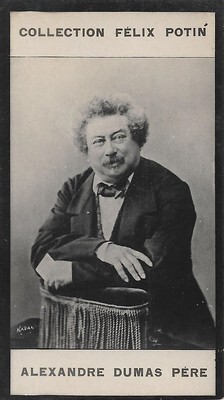
French minicard in the first series of Collection Felix Potin. Photo: Nadar. Portrait of the writer Alexandre Dumas père . The image is much older than the collector's card.
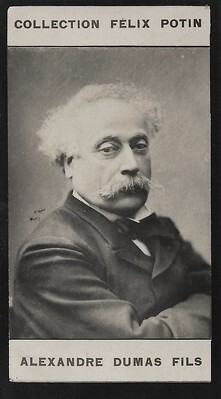
French minicard in the first series of Collection Felix Potin. Photo: Eugène Pirou, Paris. Portrait of the writer Alexandre Dumas fils .
French minicard in the first series of Collection Felix Potin. Eleonora Duse .
Eleonora Duse (1858-1924), named 'La Duse', is one of the greatest stage actresses of the 19th century and early 20th century. Her performances have been considered innovative for the Italian theatre.
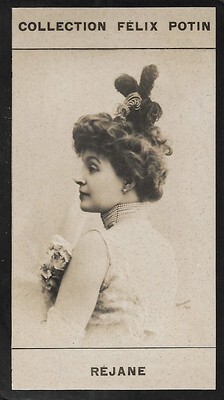
French minicard in the first series of Collection Felix Potin. Gabrielle Réjane .
Gabrielle Réjane (1856-1920) was a successful French stage actress and early silent film actress. She is most famous for her role of Catherine, in Sardou's play Madame Sans-Gene (1893), which she filmed twice.
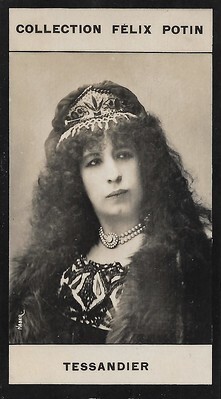
French minicard in the first series of Collection Felix Potin. Aimée Tessandier.
Aimée Tessandier (1853-1923) was a French actress. It was in Reims that Jacques Offenbach, who came specially from Paris, offered Aimée Tessandier an engagement. In 1885 she performed 'L'Arlésienne', which had no less than 500 performances.
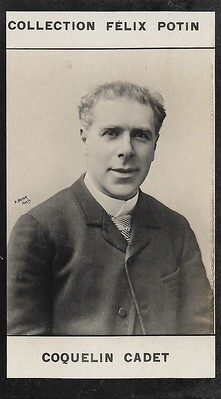
French minicard in the first series of Collection Felix Potin. Jean Coquelin .
Jean Coquelin (1865-1944) was the son of the famous stage actor Benoit Constant Coquelin. He started at the Theatre Francois, debuting in 1890, then moving on to the Renaissance and finally the Porte Saint-Martin which was run by his father but taken over by him in 1901. There he created the character of Raigoné in Edmond Rostand's 'Cyrano de Bergerac', the major play in which his father had performed. Coquelin and his father played together in the stage play 'La Dame de Monsoreau', after a novel of Alexandre Dumas, turned into a stage play in 1860.
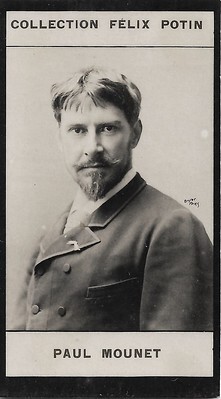
French minicard in the first series of Collection Felix Potin. Paul Mounet
Paul Mounet (1847–1922)was a French actor of the Comédie Française, who also acted in various Film d’Art films around 1910. He was the younger brother of actor Jean Mounet-Sully .
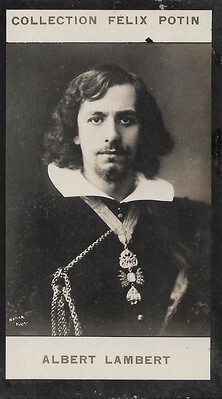
French minicard in the first series of Collection Felix Potin. Albert Lambert.
French stage and screen actor Albert Lambert (1865-1941) was for a long time part of the Comédie-Française, but he also played in several early French Film d’Art films, first of all, L'Assassinat du Duc de Guise (1908).
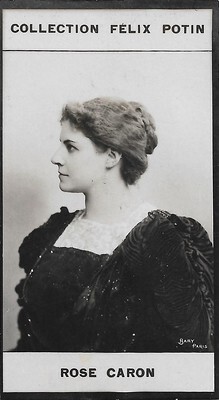
French minicard in the first series of Collection Felix Potin. Rose Caron.
Rose Caron (1857-1930), was a classical singer with a beautiful soprano voice and a good physique. The French singer was famous in particular for her performances of the Wagnerian repertoire.S he joined the Paris Opéra from 1885 to 1887 and took part in many premieres, such as 'Salammbô'.
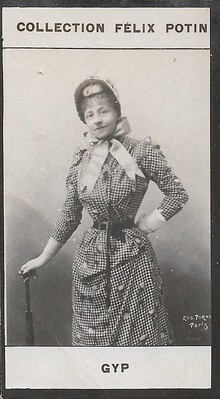
French minicard in the first series of Collection Felix Potin. Gyp.
Sibylle Aimée Marie-Antoinette Gabrielle de Riquetti de Mirabeau, Countess de Martel de Janville (1849-1932) was a French writer who published her works under the pseudonym Gyp.
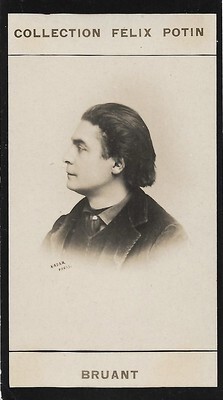
French minicard in the first series of Collection Felix Potin. Aristide Bruant.
Aristide Bruant (1851-1925) was a French cabaret singer, writer, comedian and nightclub owner who became very well known through the posters of Henri de Toulouse-Lautrec, in which he can be seen as a man in a red scarf and black coat.
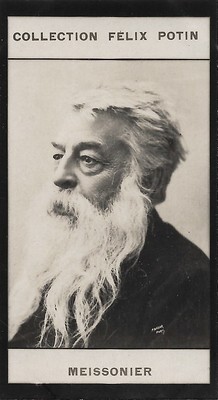
French minicard in the first series of Collection Felix Potin. Photo: Paul Nadar. Jean Louis Ernest Meissonier.
Jean Louis Ernest Meissonier (1815-1891) was one of the most famous French painters in the 1850s and 1860s.
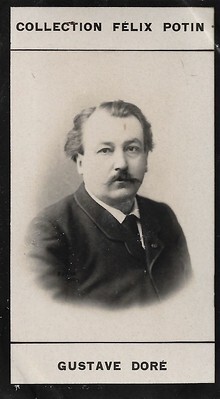
French minicard in the first series of Collection Felix Potin. Gustave Doré.
Gustave Doré (1832-1883) was a French illustrator, caricaturist, painter, lithographer and sculptor. Doré published his first illustrated story at the age of 15. He became a book illustrator in Paris, where he drew the works of Rabelais, Balzac and Dante, among others. In 1853, he was asked to illustrate the works of Lord Byron. This was followed by other work for British publishers, including a newly illustrated English Bible. He also illustrated a large edition of 'The Raven' by Edgar Allan Poe. Doré's English Bible (1865) was a great success, and in 1867 he held a major exhibition of his work in London.
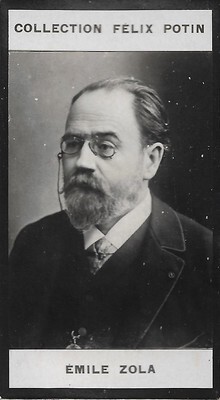
French minicard in the first series of Collection Felix Potin. Émile Zola .
Émile Zola (1840-1902) was a French writer and journalist. Considered the leader of naturalism, he is one of the most popular French novelists, the most published, translated and commented on worldwide. He has left a lasting mark on the French literary world. His novels have been adapted into numerous films and television shows. His life and work have been the subject of numerous historical studies.
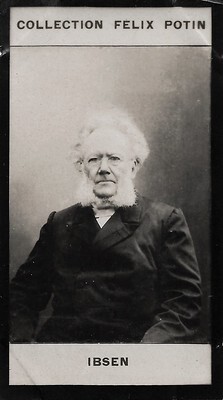
French minicard in the first series of Collection Felix Potin. Henrik Ibsen.
Henrik Johan Ibsen (1828-1906) was a Norwegian playwright and theatre director. As one of the founders of modernism in theatre, Ibsen is often referred to as "the father of realism" and he was one of the most influential playwrights of his time. His major works include 'Brand', 'Peer Gynt', 'An Enemy of the People', 'A Doll's House', 'Hedda Gabler', 'Ghosts', 'The Wild Duck', and 'Rosmersholm'. Ibsen is the most frequently performed dramatist in the world after Shakespeare.
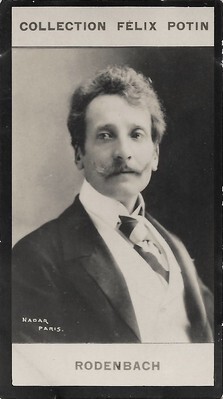
French minicard in the first series of Collection Felix Potin. Photo: Nadar. Georges Rodenbach.
Georges Rodenbach (1855-1898) was a French-speaking Belgian writer and poet. Rodenbach was one of the first prominent Belgian men of letters to embrace French symbolist poetry. Although he died at the age of forty-three, Georges Rodenbach occupies a prominent place in the history of international symbolism, with his poetry collections 'Le Règne du Silence' (1891), 'Les Vies encloses' (1896), 'Le Miroir du ciel natal' (1898), and his well-known novel 'Bruges-la-Morte' (1892).
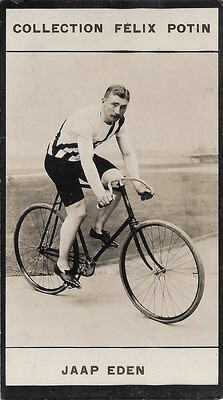
French minicard in the first series of Collection Felix Potin. Jaap Eden.
Jaap Eden (1873-1925) was a Dutch athlete. He is the only male athlete to win gold at the world championships in both speed skating (three times: 1893, 1895, 1896) and bicycle racing (two times: 1894, 1895).
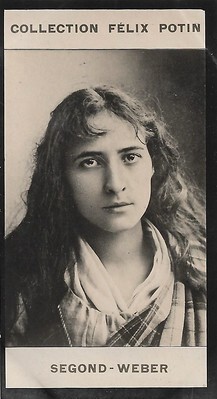
French minicard in the first series of Collection Felix Potin. Segond-Weber.
Caroline-Eugénie Weber, known as Mme Segond-Weber (1867-1945,) entered the Comédie Française in 1887, became sociétaire in 1902, and sociétaire honoraire in 1927. She was one of the 'monstres sacrés' of the French stage.
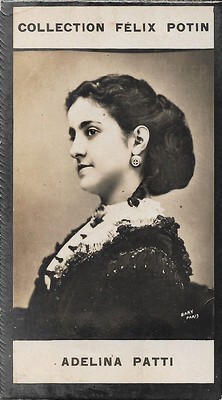
French minicard in the first series of Collection Felix Potin. Photo: Bary, Paris. Adelina Patti.
Adelina Patti (1843-1919) was an Italian 19th-century opera singer, who earned huge fees at the height of her career in the music capitals of Europe and America. She first sang in public as a child in 1851 and gave her last performance before an audience in 1914. Patti remains one of the most famous sopranos in history, owing to the purity and beauty of her lyrical voice and the unmatched quality of her bel canto technique. The composer Giuseppe Verdi, writing in 1877, described her as being perhaps the finest singer who had ever lived and a "stupendous artist". Verdi's admiration for Patti's talent was shared by numerous music critics and social commentators of her era.
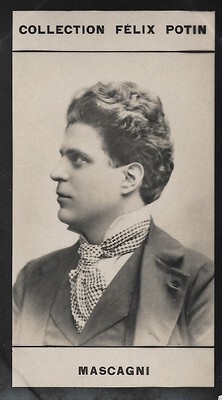
French minicard in the first series of Collection Felix Potin. Pietro Mascagni.
Pietro Mascagni (1863-1945) was an Italian composer primarily known for his operas. His 1890 masterpiece 'Cavalleria Rusticana' caused one of the greatest sensations in opera history and single-handedly ushered in the Verismo movement in Italian dramatic music. While it was often held that Mascagni, like Ruggero Leoncavallo, was a "one-opera man" who could never repeat his first success, 'L'amico Fritz' and 'Iris' have remained in the repertoire in Europe (especially in Italy) since their premieres. In 1915 Mascagni wrote the music for Nino Oxilia's film Rapsodia Satanica, starring Lyda Borelli.
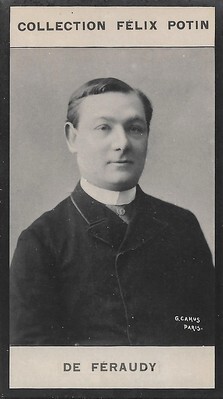
French minicard in the first series of Collection Felix Potin. Photo: G. Camus, Paris. Maurice de Féraudy .
Maurice de Féraudy (1859-1932) was an actor of the Comédie-Française and a French director. He was also a notable actor and director in French silent cinema.
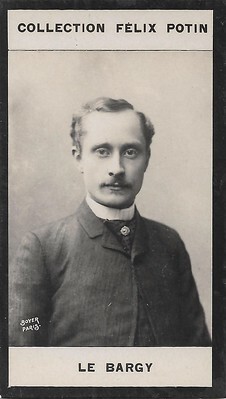
French minicard in the first series of Collection Felix Potin. Photo: Boyer, Paris. Charles Le Bargy .
Charles Le Bargy (1858-1936) was already a famous stage actor in his time, performing at the Comedie Française when he debuted in cinema as the perfidious king Henry III in L'Assassinat du Duc de Guise (1908).
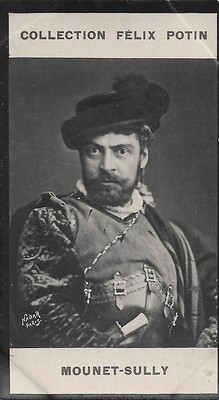
French minicard in the first series of Collection Felix Potin. Photo: Nadar, Paris. Jean Mounet-Sully.
Jean Mounet-Sully (1841-1916) was one of the biggest French theatre actors in the late 19th and early 20th centuries. At the end of his life, he played in several French Film d'Art films, some based on previous stage successes of Mounet-Sully. He was the brother of the actor Paul Mounet .
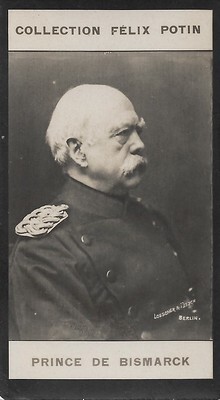
French minicard in the first series of Collection Felix Potin. Photo: Loescher & Petsch, Berlin. Otto von Bismarck.
Otto, Prince of Bismarck, Count of Bismarck-Schönhausen, Duke of Lauenburg (1815-1898), was a conservative German statesman and diplomat. From his origins in the upper class of Junker landowners, Bismarck rose rapidly in Prussian politics, and from 1862 to 1890 he was the minister-president and foreign minister of Prussia. Before his rise to the executive, he was the Prussian ambassador to Russia and France and served in both houses of the Prussian Parliament. He masterminded the unification of Germany in 1871 and served as the first Chancellor of the German Empire until 1890, in which capacity he dominated European affairs. He was nicknamed The Iron Chancellor.
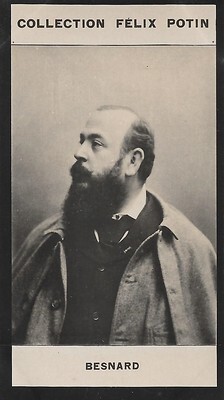
French minicard in the first series of Collection Felix Potin. Famous painters of the late 19th century. Albert Besnard.
Paul-Albert Besnard (1849-1934) was a French painter and printmaker. Besnard made his name mainly as a painter of female portraits, in an unconventional, sometimes dreamy style, a kind of mixture between classicism and impressionism, typical of the belle époque, but also with influences of Thomas Gainsborough and Joshua Reynolds. He exhibited his portraits with great regularity and success in the Paris Salon.
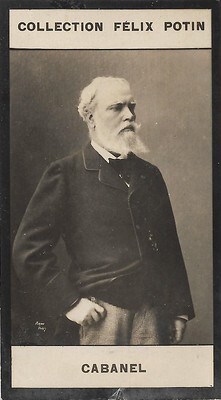
French minicard in the first series of Collection Felix Potin. Famous painters of the late 19th century. Photo: Pirou, Paris. Alexandre Cabanel.
Alexandre Cabanel (1823-1889) was a French painter. He painted historical, classical and religious scenes in the academic style, and was also a well-known portrait painter. Cabanel is one of the most important representatives of the so-called "art pompier". He was also the favourite painter of Emperor Napoleon III, whose portrait he painted in 1865. His 1863 painting 'The Birth of Venus' is one of the best-known examples of 19th-century academic painting and was bought by Napoleon III. Other famous works are his 'The Death of Francesca da Rimini and Paolo Malatesta' (1870), 'Phaedra' (1880) and 'Cleopatra Testing Poisons on Condemned Prisoners' (1887). According to the Dictionary of Art (1996), "he was elected regularly to the Salon jury and his pupils could be counted by the hundred at the Salons. Through them, Cabanel did more than any other artist of his generation to form the character of belle époque French painting."
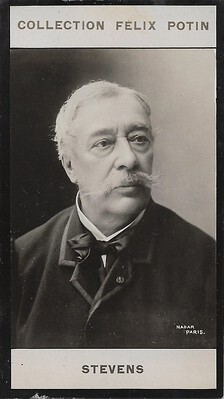
French minicard in the first series of Collection Felix Potin. Famous painters of the late 19th century. Photo: Nadar, Paris. Alfred Stevens.
Alfred Émile Léopold Stevens (1823-1906) was a Belgian painter, known for his paintings of elegant modern women. After gaining attention early in his career with a social realist painting depicting the plight of poor vagrants, he achieved great critical and popular success with his scenes of upper-middle-class Parisian life. In their realistic style and careful finish, his works reveal the influence of 17th-century Dutch genre painting. In 2009, a large overview of his work was exhibited in Brussels (Royal Museum of Fine Arts) and Amsterdam (Van Gogh Museum). Examples are e.g. 'Will You Go Out With Me Fido?' (1859), 'The Lady in Pink' (1866), 'The Parisian Sphinx' (1875–1877), and 'Maria Magdalena' (1887).
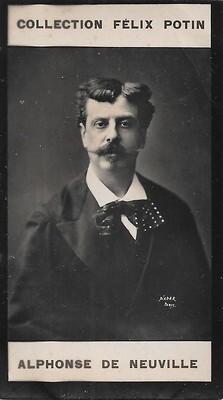
French minicard in the first series of Collection Felix Potin. Famous painters of the late 19th century. Photo: Nadar, Paris. Alphonse de Neuville.
Alphonse-Marie-Adolphe de Neuville (1835-1885) was a French academic painter who studied under Eugène Delacroix. His dramatic and intensely patriotic subjects illustrated episodes from the Franco-Prussian War, the Crimean War, the Zulu War, and portraits of soldiers. His fame spread rapidly and was increased by 'Les dernières cartouches/The Last Cartridges' (1873), memorializing an episode involving the Blue Division of the French marines, in which it is easy to discern the vast difference between the conventional treatment of military subjects, as practised by Horace Vernet, and that of a man who had lived the life that he painted. Between 1897 and the early 1900s several film adaptations of 'The Last Cartridges' were made by e.g. Lumière, Pathé, and Méliès. From 1881 to 1883, De Neuville collaborated with Édouard Detaille in the creation of two battle panoramas: The Battle of Champigny and The Battle of Rezonville. At the recent exhibition 'Enfin le cinéma' (2021) at Musée d'Orsay both his painting and the film versions were on show.
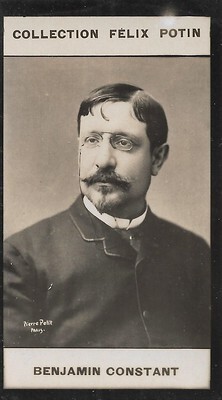
French minicard in the first series of Collection Felix Potin. Famous painters of the late 19th century. Photo: Pierre Petit, Paris. Benjamin-Constant.
Jean-Joseph Benjamin-Constant (1845-1902), also known as Benjamin-Constant), was a French painter and etcher best known for his Oriental subjects and portraits. A journey to Morocco in 1872 strongly influenced his early artistic development and led him to produce Romantic scenes under the spell of Orientalism. His large canvas, 'The Entrance of Mahomet II into Constantinople' (Musée des Augustins Toulouse), received a medal at the Paris Salon in 1876. Other acclaimed works were his portraits of Judith, Herodias, and Empress Theodora. In later life, he focused on mural decorations and portraits and became a favourite of the British aristocracy. The Italian silent film Il fiacre No. 13 (1917) shows the salon staging of a tableau vivant of Benjamin-Constant's Empress Theodora. In 2015 the Montreal Museum of Fine Arts had a big show with the works of Benjamin-Constant, entitled 'Marvels and Mirages of Orientalism'. It was the first major retrospective of Benjamin-Constant in recent times.
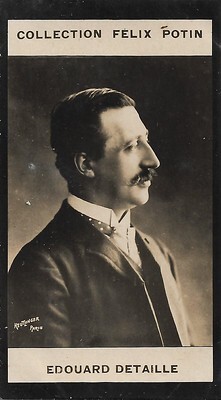
French minicard in the first series of Collection Felix Potin. Famous painters of the late 19th century. Photo: Reutlinger, Paris. Édouard Detaille.
Jean-Baptiste Édouard Detaille (1848-1912) was a French academic painter and military artist noted for his precision and realistic detail. He was regarded as the "semi-official artist of the French army". Detaille had studied with Meissonnier, who would have a lasting influence on him regarding an eye for accuracy and precision. After his own fights in the Franco-Prussian war of 1870-71, this became the topic for many of his paintings, as well as two panoramas he painted together with Alphonse Neuville.

French minicard in the first series of Collection Felix Potin. Photo: Nadar. Portrait of the writer Alexandre Dumas père . The image is much older than the collector's card.

French minicard in the first series of Collection Felix Potin. Photo: Eugène Pirou, Paris. Portrait of the writer Alexandre Dumas fils .
French minicard in the first series of Collection Felix Potin. Eleonora Duse .
Eleonora Duse (1858-1924), named 'La Duse', is one of the greatest stage actresses of the 19th century and early 20th century. Her performances have been considered innovative for the Italian theatre.

French minicard in the first series of Collection Felix Potin. Gabrielle Réjane .
Gabrielle Réjane (1856-1920) was a successful French stage actress and early silent film actress. She is most famous for her role of Catherine, in Sardou's play Madame Sans-Gene (1893), which she filmed twice.

French minicard in the first series of Collection Felix Potin. Aimée Tessandier.
Aimée Tessandier (1853-1923) was a French actress. It was in Reims that Jacques Offenbach, who came specially from Paris, offered Aimée Tessandier an engagement. In 1885 she performed 'L'Arlésienne', which had no less than 500 performances.

French minicard in the first series of Collection Felix Potin. Jean Coquelin .
Jean Coquelin (1865-1944) was the son of the famous stage actor Benoit Constant Coquelin. He started at the Theatre Francois, debuting in 1890, then moving on to the Renaissance and finally the Porte Saint-Martin which was run by his father but taken over by him in 1901. There he created the character of Raigoné in Edmond Rostand's 'Cyrano de Bergerac', the major play in which his father had performed. Coquelin and his father played together in the stage play 'La Dame de Monsoreau', after a novel of Alexandre Dumas, turned into a stage play in 1860.

French minicard in the first series of Collection Felix Potin. Paul Mounet
Paul Mounet (1847–1922)was a French actor of the Comédie Française, who also acted in various Film d’Art films around 1910. He was the younger brother of actor Jean Mounet-Sully .

French minicard in the first series of Collection Felix Potin. Albert Lambert.
French stage and screen actor Albert Lambert (1865-1941) was for a long time part of the Comédie-Française, but he also played in several early French Film d’Art films, first of all, L'Assassinat du Duc de Guise (1908).

French minicard in the first series of Collection Felix Potin. Rose Caron.
Rose Caron (1857-1930), was a classical singer with a beautiful soprano voice and a good physique. The French singer was famous in particular for her performances of the Wagnerian repertoire.S he joined the Paris Opéra from 1885 to 1887 and took part in many premieres, such as 'Salammbô'.

French minicard in the first series of Collection Felix Potin. Gyp.
Sibylle Aimée Marie-Antoinette Gabrielle de Riquetti de Mirabeau, Countess de Martel de Janville (1849-1932) was a French writer who published her works under the pseudonym Gyp.

French minicard in the first series of Collection Felix Potin. Aristide Bruant.
Aristide Bruant (1851-1925) was a French cabaret singer, writer, comedian and nightclub owner who became very well known through the posters of Henri de Toulouse-Lautrec, in which he can be seen as a man in a red scarf and black coat.

French minicard in the first series of Collection Felix Potin. Photo: Paul Nadar. Jean Louis Ernest Meissonier.
Jean Louis Ernest Meissonier (1815-1891) was one of the most famous French painters in the 1850s and 1860s.

French minicard in the first series of Collection Felix Potin. Gustave Doré.
Gustave Doré (1832-1883) was a French illustrator, caricaturist, painter, lithographer and sculptor. Doré published his first illustrated story at the age of 15. He became a book illustrator in Paris, where he drew the works of Rabelais, Balzac and Dante, among others. In 1853, he was asked to illustrate the works of Lord Byron. This was followed by other work for British publishers, including a newly illustrated English Bible. He also illustrated a large edition of 'The Raven' by Edgar Allan Poe. Doré's English Bible (1865) was a great success, and in 1867 he held a major exhibition of his work in London.

French minicard in the first series of Collection Felix Potin. Émile Zola .
Émile Zola (1840-1902) was a French writer and journalist. Considered the leader of naturalism, he is one of the most popular French novelists, the most published, translated and commented on worldwide. He has left a lasting mark on the French literary world. His novels have been adapted into numerous films and television shows. His life and work have been the subject of numerous historical studies.

French minicard in the first series of Collection Felix Potin. Henrik Ibsen.
Henrik Johan Ibsen (1828-1906) was a Norwegian playwright and theatre director. As one of the founders of modernism in theatre, Ibsen is often referred to as "the father of realism" and he was one of the most influential playwrights of his time. His major works include 'Brand', 'Peer Gynt', 'An Enemy of the People', 'A Doll's House', 'Hedda Gabler', 'Ghosts', 'The Wild Duck', and 'Rosmersholm'. Ibsen is the most frequently performed dramatist in the world after Shakespeare.

French minicard in the first series of Collection Felix Potin. Photo: Nadar. Georges Rodenbach.
Georges Rodenbach (1855-1898) was a French-speaking Belgian writer and poet. Rodenbach was one of the first prominent Belgian men of letters to embrace French symbolist poetry. Although he died at the age of forty-three, Georges Rodenbach occupies a prominent place in the history of international symbolism, with his poetry collections 'Le Règne du Silence' (1891), 'Les Vies encloses' (1896), 'Le Miroir du ciel natal' (1898), and his well-known novel 'Bruges-la-Morte' (1892).

French minicard in the first series of Collection Felix Potin. Jaap Eden.
Jaap Eden (1873-1925) was a Dutch athlete. He is the only male athlete to win gold at the world championships in both speed skating (three times: 1893, 1895, 1896) and bicycle racing (two times: 1894, 1895).

French minicard in the first series of Collection Felix Potin. Segond-Weber.
Caroline-Eugénie Weber, known as Mme Segond-Weber (1867-1945,) entered the Comédie Française in 1887, became sociétaire in 1902, and sociétaire honoraire in 1927. She was one of the 'monstres sacrés' of the French stage.

French minicard in the first series of Collection Felix Potin. Photo: Bary, Paris. Adelina Patti.
Adelina Patti (1843-1919) was an Italian 19th-century opera singer, who earned huge fees at the height of her career in the music capitals of Europe and America. She first sang in public as a child in 1851 and gave her last performance before an audience in 1914. Patti remains one of the most famous sopranos in history, owing to the purity and beauty of her lyrical voice and the unmatched quality of her bel canto technique. The composer Giuseppe Verdi, writing in 1877, described her as being perhaps the finest singer who had ever lived and a "stupendous artist". Verdi's admiration for Patti's talent was shared by numerous music critics and social commentators of her era.

French minicard in the first series of Collection Felix Potin. Pietro Mascagni.
Pietro Mascagni (1863-1945) was an Italian composer primarily known for his operas. His 1890 masterpiece 'Cavalleria Rusticana' caused one of the greatest sensations in opera history and single-handedly ushered in the Verismo movement in Italian dramatic music. While it was often held that Mascagni, like Ruggero Leoncavallo, was a "one-opera man" who could never repeat his first success, 'L'amico Fritz' and 'Iris' have remained in the repertoire in Europe (especially in Italy) since their premieres. In 1915 Mascagni wrote the music for Nino Oxilia's film Rapsodia Satanica, starring Lyda Borelli.

French minicard in the first series of Collection Felix Potin. Photo: G. Camus, Paris. Maurice de Féraudy .
Maurice de Féraudy (1859-1932) was an actor of the Comédie-Française and a French director. He was also a notable actor and director in French silent cinema.

French minicard in the first series of Collection Felix Potin. Photo: Boyer, Paris. Charles Le Bargy .
Charles Le Bargy (1858-1936) was already a famous stage actor in his time, performing at the Comedie Française when he debuted in cinema as the perfidious king Henry III in L'Assassinat du Duc de Guise (1908).

French minicard in the first series of Collection Felix Potin. Photo: Nadar, Paris. Jean Mounet-Sully.
Jean Mounet-Sully (1841-1916) was one of the biggest French theatre actors in the late 19th and early 20th centuries. At the end of his life, he played in several French Film d'Art films, some based on previous stage successes of Mounet-Sully. He was the brother of the actor Paul Mounet .

French minicard in the first series of Collection Felix Potin. Photo: Loescher & Petsch, Berlin. Otto von Bismarck.
Otto, Prince of Bismarck, Count of Bismarck-Schönhausen, Duke of Lauenburg (1815-1898), was a conservative German statesman and diplomat. From his origins in the upper class of Junker landowners, Bismarck rose rapidly in Prussian politics, and from 1862 to 1890 he was the minister-president and foreign minister of Prussia. Before his rise to the executive, he was the Prussian ambassador to Russia and France and served in both houses of the Prussian Parliament. He masterminded the unification of Germany in 1871 and served as the first Chancellor of the German Empire until 1890, in which capacity he dominated European affairs. He was nicknamed The Iron Chancellor.

French minicard in the first series of Collection Felix Potin. Famous painters of the late 19th century. Albert Besnard.
Paul-Albert Besnard (1849-1934) was a French painter and printmaker. Besnard made his name mainly as a painter of female portraits, in an unconventional, sometimes dreamy style, a kind of mixture between classicism and impressionism, typical of the belle époque, but also with influences of Thomas Gainsborough and Joshua Reynolds. He exhibited his portraits with great regularity and success in the Paris Salon.

French minicard in the first series of Collection Felix Potin. Famous painters of the late 19th century. Photo: Pirou, Paris. Alexandre Cabanel.
Alexandre Cabanel (1823-1889) was a French painter. He painted historical, classical and religious scenes in the academic style, and was also a well-known portrait painter. Cabanel is one of the most important representatives of the so-called "art pompier". He was also the favourite painter of Emperor Napoleon III, whose portrait he painted in 1865. His 1863 painting 'The Birth of Venus' is one of the best-known examples of 19th-century academic painting and was bought by Napoleon III. Other famous works are his 'The Death of Francesca da Rimini and Paolo Malatesta' (1870), 'Phaedra' (1880) and 'Cleopatra Testing Poisons on Condemned Prisoners' (1887). According to the Dictionary of Art (1996), "he was elected regularly to the Salon jury and his pupils could be counted by the hundred at the Salons. Through them, Cabanel did more than any other artist of his generation to form the character of belle époque French painting."

French minicard in the first series of Collection Felix Potin. Famous painters of the late 19th century. Photo: Nadar, Paris. Alfred Stevens.
Alfred Émile Léopold Stevens (1823-1906) was a Belgian painter, known for his paintings of elegant modern women. After gaining attention early in his career with a social realist painting depicting the plight of poor vagrants, he achieved great critical and popular success with his scenes of upper-middle-class Parisian life. In their realistic style and careful finish, his works reveal the influence of 17th-century Dutch genre painting. In 2009, a large overview of his work was exhibited in Brussels (Royal Museum of Fine Arts) and Amsterdam (Van Gogh Museum). Examples are e.g. 'Will You Go Out With Me Fido?' (1859), 'The Lady in Pink' (1866), 'The Parisian Sphinx' (1875–1877), and 'Maria Magdalena' (1887).

French minicard in the first series of Collection Felix Potin. Famous painters of the late 19th century. Photo: Nadar, Paris. Alphonse de Neuville.
Alphonse-Marie-Adolphe de Neuville (1835-1885) was a French academic painter who studied under Eugène Delacroix. His dramatic and intensely patriotic subjects illustrated episodes from the Franco-Prussian War, the Crimean War, the Zulu War, and portraits of soldiers. His fame spread rapidly and was increased by 'Les dernières cartouches/The Last Cartridges' (1873), memorializing an episode involving the Blue Division of the French marines, in which it is easy to discern the vast difference between the conventional treatment of military subjects, as practised by Horace Vernet, and that of a man who had lived the life that he painted. Between 1897 and the early 1900s several film adaptations of 'The Last Cartridges' were made by e.g. Lumière, Pathé, and Méliès. From 1881 to 1883, De Neuville collaborated with Édouard Detaille in the creation of two battle panoramas: The Battle of Champigny and The Battle of Rezonville. At the recent exhibition 'Enfin le cinéma' (2021) at Musée d'Orsay both his painting and the film versions were on show.

French minicard in the first series of Collection Felix Potin. Famous painters of the late 19th century. Photo: Pierre Petit, Paris. Benjamin-Constant.
Jean-Joseph Benjamin-Constant (1845-1902), also known as Benjamin-Constant), was a French painter and etcher best known for his Oriental subjects and portraits. A journey to Morocco in 1872 strongly influenced his early artistic development and led him to produce Romantic scenes under the spell of Orientalism. His large canvas, 'The Entrance of Mahomet II into Constantinople' (Musée des Augustins Toulouse), received a medal at the Paris Salon in 1876. Other acclaimed works were his portraits of Judith, Herodias, and Empress Theodora. In later life, he focused on mural decorations and portraits and became a favourite of the British aristocracy. The Italian silent film Il fiacre No. 13 (1917) shows the salon staging of a tableau vivant of Benjamin-Constant's Empress Theodora. In 2015 the Montreal Museum of Fine Arts had a big show with the works of Benjamin-Constant, entitled 'Marvels and Mirages of Orientalism'. It was the first major retrospective of Benjamin-Constant in recent times.

French minicard in the first series of Collection Felix Potin. Famous painters of the late 19th century. Photo: Reutlinger, Paris. Édouard Detaille.
Jean-Baptiste Édouard Detaille (1848-1912) was a French academic painter and military artist noted for his precision and realistic detail. He was regarded as the "semi-official artist of the French army". Detaille had studied with Meissonnier, who would have a lasting influence on him regarding an eye for accuracy and precision. After his own fights in the Franco-Prussian war of 1870-71, this became the topic for many of his paintings, as well as two panoramas he painted together with Alphonse Neuville.
Published on March 05, 2023 22:00
March 4, 2023
Photo by Civirani
Italian photographer Carlo Civirani (?-?) belonged to the group of Roman studio photographers which also included Pinto, Villoresi and d'Alessandri. He photographed many Italian film actors of the 1910s. His son, Osvaldo Civirani (1917-2008) later became one of Italy's most notable still photographers, who worked with such famous film directors as Luchino Visconti, Federico Fellini and Roberto Rossellini.
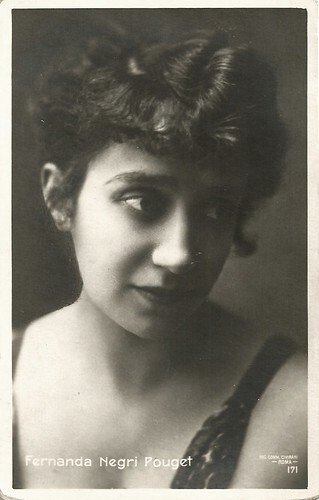
Italian postcard by Ed. Vettori, Bologna, no. 171. Photo: Comm. Civirani, Roma.
Fernanda Negri Pouget (1889-1955) was an Italian actress who starred in the Italian silent cinema of the 1910s.
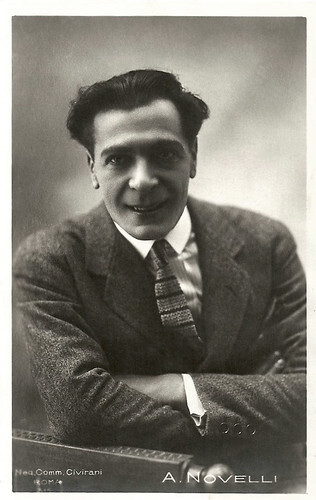
Italian postcard by Ed. Vettori, Bologna, no. 215. Photo: Civirani, Roma.
Amleto Novelli (1885-1924) was a famous actor in Italian silent cinema, as well in epic and historical cinema as in diva films.
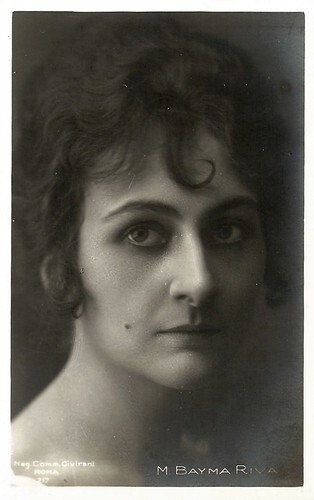
Italian postcard by Ed. Vettori, Bologna, no. 217. Photo: Civirani, Roma.
Mary Bayma-Riva (?-?) was an actress of Italian silent cinema of the 1910s and early 1920s, acting at companies such as Gloria and Floreal Film in films like Florette et Patapon (1913) and Il pastor fido (1918).
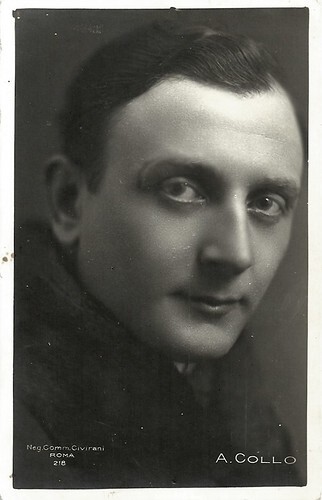
Italian postcard by Ed. Vettori, Bologna, no. 218. Photo: Comm. Civirani, Roma.
Alberto Collo (1883-1955) was an Italian film actor of mostly silent cinema. In the 1910s and early 1920s, he acted opposite the female stars of his times, such as Francesca Bertini, Hesperia, Maria and Diomira Jacobini and Italia Almirante Manzini. He also performed in war propaganda, historical films and strong men films.
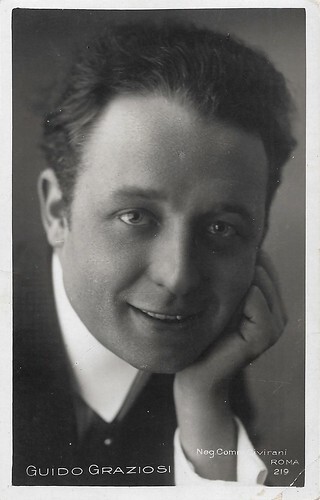
Italian postcard by Ed. Vettori, Bologna, no. 219. Photo: Comm. Civirani, Roma.
Guido Graziosi (?-?) was a prominent stage actor within the company of Ermete Zacconi In 1912, he started his film career at the Turin-based company Savoia. He acted in films with a young Maria Jacobini and with the French actress Stacia Napierkowska.
Carlo and Osvaldo Civirani
'Commendatore' Carlo Civirani had a well-frequented photo studio in Via Nazionale 22 in Rome. He was an acclaimed distinguished photographer, his son told in an interview, wearing a redingote and a monocle. Carlo Civirani belonged to the group of Roman studio photographers which also included Pinto , Villoresi and d'Alessandri.
Carlo's son Osvaldo Civirani learned photo retouching from his father and did this also for the other Roman photographers. In 1934 on the recommendation of his father, Osvaldo Civirani would start at the photo studio of Aurelio Pesce at the Cines Pittaluga film studio complex in Via Veio.
In 1935 he would make his first set photos, becoming one of Italy's most notable still photographers. In 1943, being hired as a still photographer on the set of Luchino Visconti 's Ossessione/Obsession (1943), Civirani introduced the novelty of taking pictures, not after the scene was shot - in a constellation that was staged for this purpose -, but while the scene was being shot, using for that purpose the lighter and unobtrusive Plaubel Makina 3. According to Civirani, this was also the first time that the still photographer appeared in the title credits.
As a set photographer, he worked with other famous film directors such as Alessandro Blasetti on Fabiola/The Fighting Gladiator (1949), Roberto Rossellini on Francesco, giullare di Dio/The Flowers of St. Francis (1950), Federico Fellini on Lo sceicco bianco/The White Sheik (1952), and Carlo Lizzani on Cronache di poveri amanti/Chronicle of Poor Lovers (1954).
Until 1963, Civirani worked mainly as a still photographer on over two hundred films. From 1963 to 1976, Osvaldo Civirani would also produce and direct 20 films in various genres: Peplum, Euro-Spy films, Spaghetti Westerns, and comedies with Franco & Ciccio. He later wrote two books: 'Un fotografo a Cinecittà' and 'La donna dei sogni', in which Civirani collected the memories and experiences of a whole life dedicated to cinema.
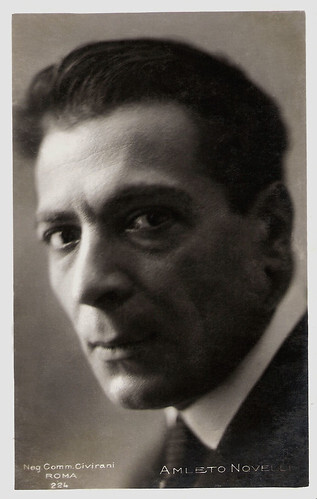
Italian postcard by Ed. Vettori, Bologna, no. 224. Photo: Comm. Civirani, Roma.
Amleto Novelli (1885-1924) was a famous actor in Italian silent cinema, as well as in epic and historical cinema as in diva films.
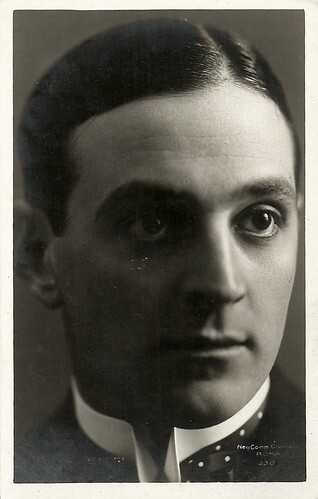
Italian postcard by Ed. Vettori, Bologna, no. 230. Photo: Civirani, Roma.
Luigi Serventi (1885-1976), was a male star of Italian silent cinema, often cast with Italian divas such as Pina Menichelli. After his Italian career, he continued in Germany and Czechoslovakia in the 1920s.
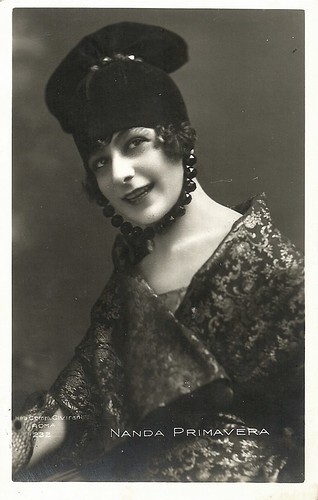
Italian postcard by Ed. Vettori, Bologna, no. 232. Photo: Civirani, Roma.
Nanda Primavera (1898-1995), was an Italian actress and singer. From 1940 on, she appeared in several Italian films.
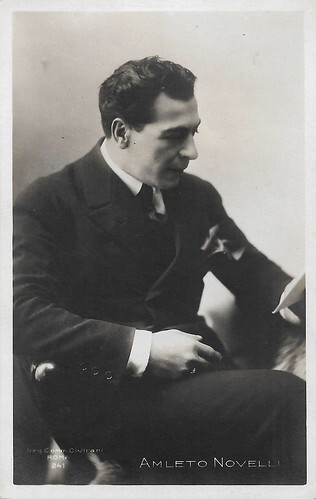
Italian postcard by Ed. Vettori, Bologna, no. 241. Photo: Comm. Civirani, Roma.
Amleto Novelli (1885-1924) was a star actor in Italian silent cinema. He appeared in many biblical films and epics and starred with all the divas of the Italian film. During the shooting of a film, he suddenly died, only 38.
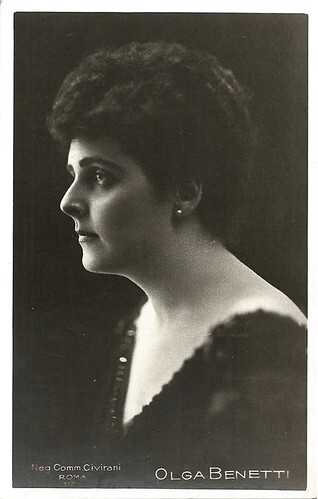
Italian postcard by Ed. Vettori, Bologna, no. 317. Photo: Comm. Civirani, Roma.
Olga Benetti (?-1958) was an Italian actress who acted in many films of the Roman film companies Cines, Celio, and Caesar in the 1910s and early 1920s. She often performed opposite Francesca Bertini, Gustavo Serena, and her husband Carlo Benetti (1885-1949).
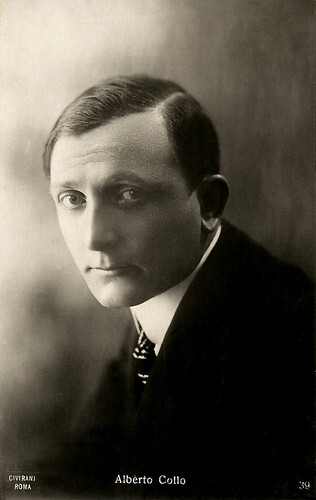
Italian postcard by Ed. Traldi, Milano, no. 39. Photo: Civirani, Roma.
Alberto Collo (1883-1955) was an Italian film actor of mostly silent cinema. In the 1910s and early 1920s, he acted opposite the female stars of his times, such as Francesca Bertini, Hesperia, Maria and Diomira Jacobini and Italia Almirante Manzini. He also performed in war propaganda, historical films and strong men films.
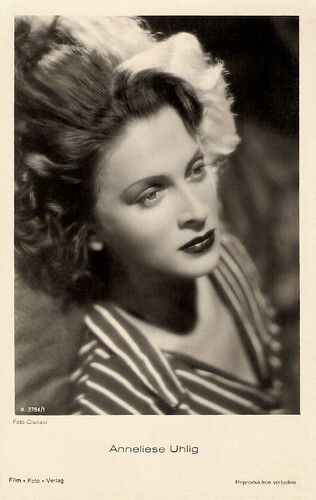
German Postcard by Film-Foto-Verlag, no. A3784/1, 1941-1944. Photo: Civirani.
Classic beauty Anneliese Uhlig (1918) was an elegant and enchanting femme fatale of Ufa crime films of the 1940s, who unwillingly bewitched Joseph Goebbels and hat to move to Italy. After the war, the German actress worked also internationally as a journalist, theatre producer and university teacher and became an American citizen.
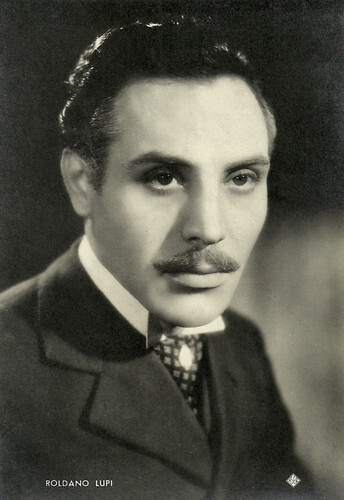
Italian postcard by ASER (A. Scaramaglia Edizioni Roma), no. 353. Photo: Civirani / Lux Film.
Roldano Lupi (1909-1989) was an Italian actor in cinema, television and theatre.
Sources: Wikipedia (English and Italian) and .

Italian postcard by Ed. Vettori, Bologna, no. 171. Photo: Comm. Civirani, Roma.
Fernanda Negri Pouget (1889-1955) was an Italian actress who starred in the Italian silent cinema of the 1910s.

Italian postcard by Ed. Vettori, Bologna, no. 215. Photo: Civirani, Roma.
Amleto Novelli (1885-1924) was a famous actor in Italian silent cinema, as well in epic and historical cinema as in diva films.

Italian postcard by Ed. Vettori, Bologna, no. 217. Photo: Civirani, Roma.
Mary Bayma-Riva (?-?) was an actress of Italian silent cinema of the 1910s and early 1920s, acting at companies such as Gloria and Floreal Film in films like Florette et Patapon (1913) and Il pastor fido (1918).

Italian postcard by Ed. Vettori, Bologna, no. 218. Photo: Comm. Civirani, Roma.
Alberto Collo (1883-1955) was an Italian film actor of mostly silent cinema. In the 1910s and early 1920s, he acted opposite the female stars of his times, such as Francesca Bertini, Hesperia, Maria and Diomira Jacobini and Italia Almirante Manzini. He also performed in war propaganda, historical films and strong men films.

Italian postcard by Ed. Vettori, Bologna, no. 219. Photo: Comm. Civirani, Roma.
Guido Graziosi (?-?) was a prominent stage actor within the company of Ermete Zacconi In 1912, he started his film career at the Turin-based company Savoia. He acted in films with a young Maria Jacobini and with the French actress Stacia Napierkowska.
Carlo and Osvaldo Civirani
'Commendatore' Carlo Civirani had a well-frequented photo studio in Via Nazionale 22 in Rome. He was an acclaimed distinguished photographer, his son told in an interview, wearing a redingote and a monocle. Carlo Civirani belonged to the group of Roman studio photographers which also included Pinto , Villoresi and d'Alessandri.
Carlo's son Osvaldo Civirani learned photo retouching from his father and did this also for the other Roman photographers. In 1934 on the recommendation of his father, Osvaldo Civirani would start at the photo studio of Aurelio Pesce at the Cines Pittaluga film studio complex in Via Veio.
In 1935 he would make his first set photos, becoming one of Italy's most notable still photographers. In 1943, being hired as a still photographer on the set of Luchino Visconti 's Ossessione/Obsession (1943), Civirani introduced the novelty of taking pictures, not after the scene was shot - in a constellation that was staged for this purpose -, but while the scene was being shot, using for that purpose the lighter and unobtrusive Plaubel Makina 3. According to Civirani, this was also the first time that the still photographer appeared in the title credits.
As a set photographer, he worked with other famous film directors such as Alessandro Blasetti on Fabiola/The Fighting Gladiator (1949), Roberto Rossellini on Francesco, giullare di Dio/The Flowers of St. Francis (1950), Federico Fellini on Lo sceicco bianco/The White Sheik (1952), and Carlo Lizzani on Cronache di poveri amanti/Chronicle of Poor Lovers (1954).
Until 1963, Civirani worked mainly as a still photographer on over two hundred films. From 1963 to 1976, Osvaldo Civirani would also produce and direct 20 films in various genres: Peplum, Euro-Spy films, Spaghetti Westerns, and comedies with Franco & Ciccio. He later wrote two books: 'Un fotografo a Cinecittà' and 'La donna dei sogni', in which Civirani collected the memories and experiences of a whole life dedicated to cinema.

Italian postcard by Ed. Vettori, Bologna, no. 224. Photo: Comm. Civirani, Roma.
Amleto Novelli (1885-1924) was a famous actor in Italian silent cinema, as well as in epic and historical cinema as in diva films.

Italian postcard by Ed. Vettori, Bologna, no. 230. Photo: Civirani, Roma.
Luigi Serventi (1885-1976), was a male star of Italian silent cinema, often cast with Italian divas such as Pina Menichelli. After his Italian career, he continued in Germany and Czechoslovakia in the 1920s.

Italian postcard by Ed. Vettori, Bologna, no. 232. Photo: Civirani, Roma.
Nanda Primavera (1898-1995), was an Italian actress and singer. From 1940 on, she appeared in several Italian films.

Italian postcard by Ed. Vettori, Bologna, no. 241. Photo: Comm. Civirani, Roma.
Amleto Novelli (1885-1924) was a star actor in Italian silent cinema. He appeared in many biblical films and epics and starred with all the divas of the Italian film. During the shooting of a film, he suddenly died, only 38.

Italian postcard by Ed. Vettori, Bologna, no. 317. Photo: Comm. Civirani, Roma.
Olga Benetti (?-1958) was an Italian actress who acted in many films of the Roman film companies Cines, Celio, and Caesar in the 1910s and early 1920s. She often performed opposite Francesca Bertini, Gustavo Serena, and her husband Carlo Benetti (1885-1949).

Italian postcard by Ed. Traldi, Milano, no. 39. Photo: Civirani, Roma.
Alberto Collo (1883-1955) was an Italian film actor of mostly silent cinema. In the 1910s and early 1920s, he acted opposite the female stars of his times, such as Francesca Bertini, Hesperia, Maria and Diomira Jacobini and Italia Almirante Manzini. He also performed in war propaganda, historical films and strong men films.

German Postcard by Film-Foto-Verlag, no. A3784/1, 1941-1944. Photo: Civirani.
Classic beauty Anneliese Uhlig (1918) was an elegant and enchanting femme fatale of Ufa crime films of the 1940s, who unwillingly bewitched Joseph Goebbels and hat to move to Italy. After the war, the German actress worked also internationally as a journalist, theatre producer and university teacher and became an American citizen.

Italian postcard by ASER (A. Scaramaglia Edizioni Roma), no. 353. Photo: Civirani / Lux Film.
Roldano Lupi (1909-1989) was an Italian actor in cinema, television and theatre.
Sources: Wikipedia (English and Italian) and .
Published on March 04, 2023 22:00
March 3, 2023
Liam Neeson
Northern Irish actor Liam Neeson (1952) appeared in 140 films and television productions since his debut in Pilgrim's Progress(1978). He was nominated for an Academy Award for his role as Oskar Schindler in Steven Spielberg's Schindler's List (1994). He also starred in Michael Collins (1996), Kinsey (2004) and Star Wars: Episode I - The Phantom Menace (1999). He also played the role of secret agent Bryan Mills three times in the Taken film series.
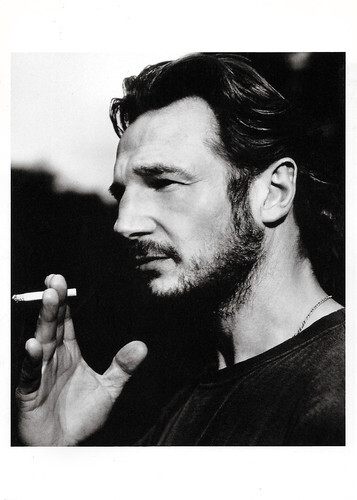
American postcard by Fotofolio, no. F831. Photo: Herb Ritts. Caption: Liam Neeson, Scotland, 1994.
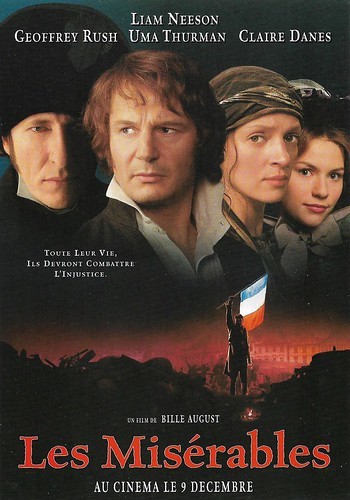
French postcard for the film Les Misérables (Bille August, 1998), starring Liam Neeson as Jean Valjean, Geoffrey Rush as Javert, Uma Thurman as Fantine, and Claire Danes as Cosette. The film was a British-American-German coproduction.
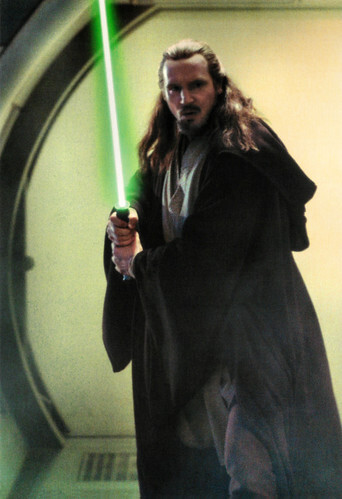
American postcard by Classico San Francisco, no. 106-017. Photo: Lucasfilm. Liam Neeson as Qui-Gon Jinn in Star Wars: Episode I - The Phantom Menace (George Lucas, 1999).
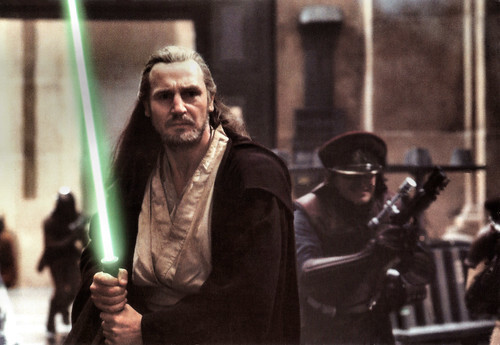
American postcard by Classico San Francisco, no. 106-039. Photo: Lucasfilm. Liam Neeson as Qui-Gon Jinn in Star Wars: Episode I - The Phantom Menace (George Lucas, 1999).
Final breakthrough and international recognition
William John 'Liam' Neeson was born in Ballymena, Northern Ireland in 1952. He was the third of four children of Katherine (Brown), a cook, and Bernard Neeson, a school caretaker. During his school years, he regularly performed in school plays. In his youth, Neeson was also very active in sports and won the Northern Ireland champion title in boxing. It also earned him a broken nose, to which he owes his characteristic nose shape.
He originally wanted to become a teacher and studied mathematics, physics, computer science and drama at Queen's University Belfast. However, he dropped out and worked as a forklift driver in a Guinness brewery, among other jobs. In 1976, Neeson joined the Lyric Players' Theatre group in Belfast, where he made his stage debut in Joseph Plunkett's drama 'The Risen People'. He made his film debut as an Evangelist in Pilgrim's Progress (Ken Anderson, 1978).
That year he moved to the Abbey Theatre in Dublin where John Boorman saw him play the role of Lennie in John Steinbeck's 'Of Mice and Men' (1980). Boorman subsequently hired him to play the role of the knight Gawain in the fantasy epic Excalibur (John Boorman, 1981) starring Nigel Terry and Helen Mirren.
From then on Liam Neeson appeared in numerous films, always in supporting roles alongside well-known stars, such as in The Bounty (Roger Donaldson, 1984) alongside Mel Gibson and Anthony Hopkins, in Mission (Roland Joffé, 1986) alongside Jeremy Irons and Robert De Niro , and in Husbands and Wives (Woody Allen, 1992) alongside Woody Allen, Blythe Danner and Judy Davis. Neeson played the lead in the cult favourite Darkman (1990), directed by Sam Raimi.
He gained fame for the role of the German industrialist Oskar Schindler in the Holocaust film Schindler's List (Steven Spielberg, 1994). Schindler saved the lives of around 1200 Jews in the Third Reich by employing them in his factory. Neeson earned great praise from critics for his portrayal. He achieved his final breakthrough and gained international recognition with nominations for the Oscar, Golden Globe and BAFTA Awards for Best Actor.
Also in 1993, he made his Broadway debut with a Tony-nominated performance in 'Anna Christie', in which he co-starred with his future wife Natasha Richardson. The next year, the two also starred opposite Jodie Foster in Nell (Michael Apted, 1994), and were married in July of that year.
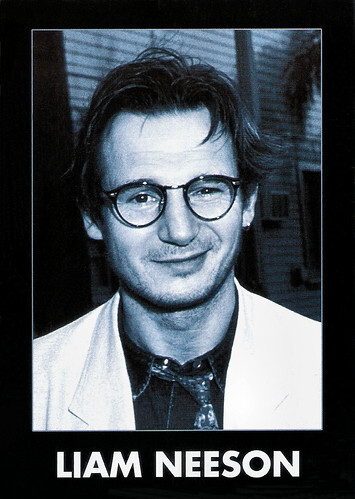
British postcard by Pyramid, Leicester, no. PC 8826.
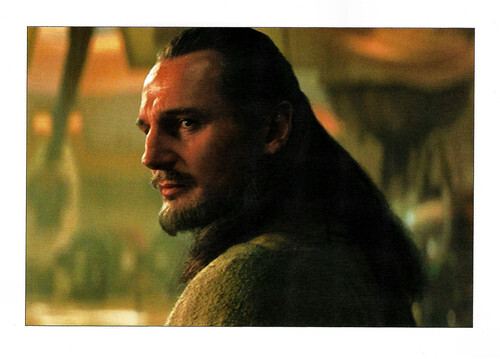
British double card by Danilo, London, no. SW039. Photo: Lucasfilm. Liam Neeson as Qui-Gon Jinn in Star Wars: Episode I - The Phantom Menace (George Lucas, 1999).
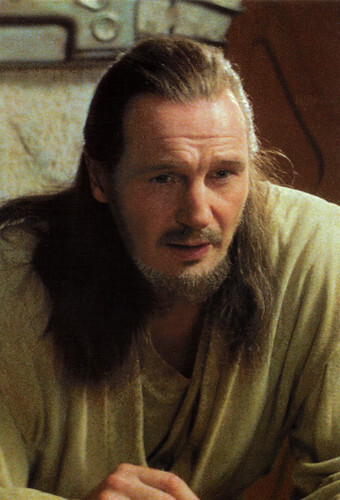
American postcard by Classico San Francisco, no. 106-016. Photo: Lucasfilm. Liam Neeson as Qui-Gon Jinn in Star Wars: Episode I - The Phantom Menace (George Lucas, 1999).
A surprise box-office hit, making almost $200 million more than its budget
Soon Liam Neeson was solidified as one of Hollywood's top leading men. He took on the role of 18th-century Scottish folk hero Robert Roy MacGregor in Rob Roy (Michael Caton-Jones, 1995) and that of Michael Collins, the Irish revolutionary leader, in Michael Collins (Neil Jordan, 1996). He played Jean Valjean in Les Miserables (Bille August, 1998) based on the novel by Victor Hugo .
In 1999 he became the Jedi Knight Qui-Gon Jinn, one of the main roles in Star Wars: Episode I - The Dark Menace (George Lucas, 1999). He also appeared in Martin Scorsese's Gangs of New York (2002), and the romantic comedy Love Actually (Richard Curtis, 2003). In 2004, he portrayed the US sex researcher Alfred Charles Kinsey in Kinsey (Bill Condon, 2004). He starred as a crusader in the historical epic Kingdom of Heaven (Ridley Scott, 2005).
Neeson then appeared in the first part of The Dark Knight trilogy, Batman Begins (Christopher Nolan, 2005), and in the third part, The Dark Knight Rises (Christopher Nolan, 2012), in which he portrayed Batman's mentor and later antagonist Ra's al Ghul. In 2008 he played the role of retired CIA agent Bryan Mills in Taken (Pierre Morel, 2008) also starring Famke Janssen. Taken was a surprise box-office hit, grossing $223.9 million worldwide.
From then on, he regularly portrayed action heroes. Neeson continued the role of Bryan Mills in the sequels Taken 2 (Olivier Megaton, 2012) and Taken 3 (Olivier Megaton, 2014). He played Zeus in Clash of the Titans (Louis Leterrier, 2010), another huge box-office hit, grossing $475 million worldwide, and returned as Zeus in the sequel Wrath of the Titans (Jonathan Liebesman, 2012), starring Sam Worthington. He then played John 'Hannibal' Smith in the spin-off of the legendary series, The A-Team - The Movie (Joe Carnahan, 2010).
In 2011, Neeson starred in the German-British-American action-thriller Unknown (Jaume Collet-Serra, 2011). This film led to a collaboration between Neeson and director Jaume Collet-Serra on a series of similar action films including Non-Stop (2014), Run All Night (2015) and The Commuter (2018). In 2016, he played the role of American General Douglas MacArthur in the South Korean film Operation Chromite (John H. Lee, 2016). This is the film version of the landing at Incheon, which initiated a turning point in the Korean War through MacArthur. Other action films followed in which Neeson took the leading role.
He appeared three more times as Qui-Gon Jinn: his voice was heard in Star Wars: The Rise of Skywalker (J.J. Abrams, 2019), he starred in an episode of the TV Mini-Series Obi-Wan Kenobi (Deborah Chow, 2022) starring Ewan McGregor , and lent his voice again in an episode of the anthology series Star Wars: Tales of the Jedi (Saul Ruiz, a.o., 2022). His total output for film and television includes more than 140 productions.
A native of Northern Ireland, Liam Neeson holds British and Irish citizenship and since 2009, he has also held United States citizenship. In 1999, Neeson was awarded an appointment as an Officer of the Order of the British Empire (OBE). He is an ambassador for UNICEF in Ireland. Neeson married Natasha Richardson in 1994 and had two sons with her. Richardson died in 2009 after a skiing accident in Canada in which she suffered serious head injuries. Their son Micheál Richardson is also an actor.
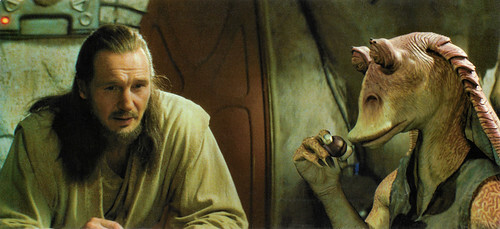
American postcard by Classico San Francisco, no. 490-002. Photo: Lucasfilm. Liam Neeson as Qui-Gon Jinn and Ahmed Best as Jar Jar Binks in Star Wars: Episode I - The Phantom Menace (George Lucas, 1999).
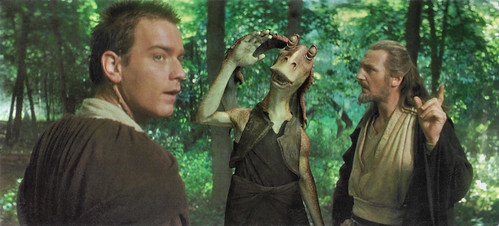
American postcard by Classico San Francisco, no. 490-003. Photo: Lucasfilm. Ewan McGregor as Obi-Wan Kenobi, Ahmed Best as Jar Jar Binks and Liam Neeson as Qui-Gon Jinn in Star Wars: Episode I - The Phantom Menace (George Lucas, 1999).
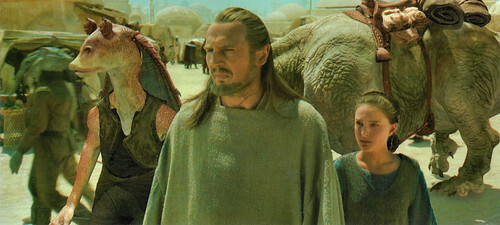
American postcard by Classico San Francisco, no. 490-005. Photo: Lucasfilm. Ahmed Best as Jar Jar Binks, Liam Neeson as Qui-Gon Jinn and Natalie Portman as Padmé in Star Wars: Episode I - The Phantom Menace (George Lucas, 1999).
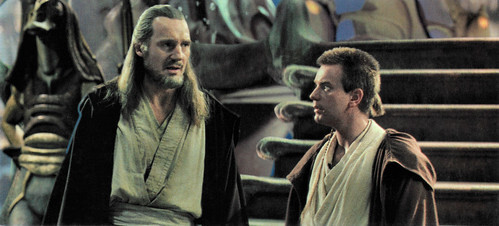
American postcard by Classico San Francisco, no. 490-020. Photo: Lucasfilm. Liam Neeson as Qui-Gon Jinn and Ewan McGregor as Obi-Wan Kenobi in Star Wars: Episode I - The Phantom Menace (George Lucas, 1999).
Sources: (IMDb), Wikipedia (Dutch, German and English) and .

American postcard by Fotofolio, no. F831. Photo: Herb Ritts. Caption: Liam Neeson, Scotland, 1994.

French postcard for the film Les Misérables (Bille August, 1998), starring Liam Neeson as Jean Valjean, Geoffrey Rush as Javert, Uma Thurman as Fantine, and Claire Danes as Cosette. The film was a British-American-German coproduction.

American postcard by Classico San Francisco, no. 106-017. Photo: Lucasfilm. Liam Neeson as Qui-Gon Jinn in Star Wars: Episode I - The Phantom Menace (George Lucas, 1999).

American postcard by Classico San Francisco, no. 106-039. Photo: Lucasfilm. Liam Neeson as Qui-Gon Jinn in Star Wars: Episode I - The Phantom Menace (George Lucas, 1999).
Final breakthrough and international recognition
William John 'Liam' Neeson was born in Ballymena, Northern Ireland in 1952. He was the third of four children of Katherine (Brown), a cook, and Bernard Neeson, a school caretaker. During his school years, he regularly performed in school plays. In his youth, Neeson was also very active in sports and won the Northern Ireland champion title in boxing. It also earned him a broken nose, to which he owes his characteristic nose shape.
He originally wanted to become a teacher and studied mathematics, physics, computer science and drama at Queen's University Belfast. However, he dropped out and worked as a forklift driver in a Guinness brewery, among other jobs. In 1976, Neeson joined the Lyric Players' Theatre group in Belfast, where he made his stage debut in Joseph Plunkett's drama 'The Risen People'. He made his film debut as an Evangelist in Pilgrim's Progress (Ken Anderson, 1978).
That year he moved to the Abbey Theatre in Dublin where John Boorman saw him play the role of Lennie in John Steinbeck's 'Of Mice and Men' (1980). Boorman subsequently hired him to play the role of the knight Gawain in the fantasy epic Excalibur (John Boorman, 1981) starring Nigel Terry and Helen Mirren.
From then on Liam Neeson appeared in numerous films, always in supporting roles alongside well-known stars, such as in The Bounty (Roger Donaldson, 1984) alongside Mel Gibson and Anthony Hopkins, in Mission (Roland Joffé, 1986) alongside Jeremy Irons and Robert De Niro , and in Husbands and Wives (Woody Allen, 1992) alongside Woody Allen, Blythe Danner and Judy Davis. Neeson played the lead in the cult favourite Darkman (1990), directed by Sam Raimi.
He gained fame for the role of the German industrialist Oskar Schindler in the Holocaust film Schindler's List (Steven Spielberg, 1994). Schindler saved the lives of around 1200 Jews in the Third Reich by employing them in his factory. Neeson earned great praise from critics for his portrayal. He achieved his final breakthrough and gained international recognition with nominations for the Oscar, Golden Globe and BAFTA Awards for Best Actor.
Also in 1993, he made his Broadway debut with a Tony-nominated performance in 'Anna Christie', in which he co-starred with his future wife Natasha Richardson. The next year, the two also starred opposite Jodie Foster in Nell (Michael Apted, 1994), and were married in July of that year.

British postcard by Pyramid, Leicester, no. PC 8826.

British double card by Danilo, London, no. SW039. Photo: Lucasfilm. Liam Neeson as Qui-Gon Jinn in Star Wars: Episode I - The Phantom Menace (George Lucas, 1999).

American postcard by Classico San Francisco, no. 106-016. Photo: Lucasfilm. Liam Neeson as Qui-Gon Jinn in Star Wars: Episode I - The Phantom Menace (George Lucas, 1999).
A surprise box-office hit, making almost $200 million more than its budget
Soon Liam Neeson was solidified as one of Hollywood's top leading men. He took on the role of 18th-century Scottish folk hero Robert Roy MacGregor in Rob Roy (Michael Caton-Jones, 1995) and that of Michael Collins, the Irish revolutionary leader, in Michael Collins (Neil Jordan, 1996). He played Jean Valjean in Les Miserables (Bille August, 1998) based on the novel by Victor Hugo .
In 1999 he became the Jedi Knight Qui-Gon Jinn, one of the main roles in Star Wars: Episode I - The Dark Menace (George Lucas, 1999). He also appeared in Martin Scorsese's Gangs of New York (2002), and the romantic comedy Love Actually (Richard Curtis, 2003). In 2004, he portrayed the US sex researcher Alfred Charles Kinsey in Kinsey (Bill Condon, 2004). He starred as a crusader in the historical epic Kingdom of Heaven (Ridley Scott, 2005).
Neeson then appeared in the first part of The Dark Knight trilogy, Batman Begins (Christopher Nolan, 2005), and in the third part, The Dark Knight Rises (Christopher Nolan, 2012), in which he portrayed Batman's mentor and later antagonist Ra's al Ghul. In 2008 he played the role of retired CIA agent Bryan Mills in Taken (Pierre Morel, 2008) also starring Famke Janssen. Taken was a surprise box-office hit, grossing $223.9 million worldwide.
From then on, he regularly portrayed action heroes. Neeson continued the role of Bryan Mills in the sequels Taken 2 (Olivier Megaton, 2012) and Taken 3 (Olivier Megaton, 2014). He played Zeus in Clash of the Titans (Louis Leterrier, 2010), another huge box-office hit, grossing $475 million worldwide, and returned as Zeus in the sequel Wrath of the Titans (Jonathan Liebesman, 2012), starring Sam Worthington. He then played John 'Hannibal' Smith in the spin-off of the legendary series, The A-Team - The Movie (Joe Carnahan, 2010).
In 2011, Neeson starred in the German-British-American action-thriller Unknown (Jaume Collet-Serra, 2011). This film led to a collaboration between Neeson and director Jaume Collet-Serra on a series of similar action films including Non-Stop (2014), Run All Night (2015) and The Commuter (2018). In 2016, he played the role of American General Douglas MacArthur in the South Korean film Operation Chromite (John H. Lee, 2016). This is the film version of the landing at Incheon, which initiated a turning point in the Korean War through MacArthur. Other action films followed in which Neeson took the leading role.
He appeared three more times as Qui-Gon Jinn: his voice was heard in Star Wars: The Rise of Skywalker (J.J. Abrams, 2019), he starred in an episode of the TV Mini-Series Obi-Wan Kenobi (Deborah Chow, 2022) starring Ewan McGregor , and lent his voice again in an episode of the anthology series Star Wars: Tales of the Jedi (Saul Ruiz, a.o., 2022). His total output for film and television includes more than 140 productions.
A native of Northern Ireland, Liam Neeson holds British and Irish citizenship and since 2009, he has also held United States citizenship. In 1999, Neeson was awarded an appointment as an Officer of the Order of the British Empire (OBE). He is an ambassador for UNICEF in Ireland. Neeson married Natasha Richardson in 1994 and had two sons with her. Richardson died in 2009 after a skiing accident in Canada in which she suffered serious head injuries. Their son Micheál Richardson is also an actor.

American postcard by Classico San Francisco, no. 490-002. Photo: Lucasfilm. Liam Neeson as Qui-Gon Jinn and Ahmed Best as Jar Jar Binks in Star Wars: Episode I - The Phantom Menace (George Lucas, 1999).

American postcard by Classico San Francisco, no. 490-003. Photo: Lucasfilm. Ewan McGregor as Obi-Wan Kenobi, Ahmed Best as Jar Jar Binks and Liam Neeson as Qui-Gon Jinn in Star Wars: Episode I - The Phantom Menace (George Lucas, 1999).

American postcard by Classico San Francisco, no. 490-005. Photo: Lucasfilm. Ahmed Best as Jar Jar Binks, Liam Neeson as Qui-Gon Jinn and Natalie Portman as Padmé in Star Wars: Episode I - The Phantom Menace (George Lucas, 1999).

American postcard by Classico San Francisco, no. 490-020. Photo: Lucasfilm. Liam Neeson as Qui-Gon Jinn and Ewan McGregor as Obi-Wan Kenobi in Star Wars: Episode I - The Phantom Menace (George Lucas, 1999).
Sources: (IMDb), Wikipedia (Dutch, German and English) and .
Published on March 03, 2023 22:00
March 2, 2023
Jacques Tati
French actor, comedian and film director Jacques Tati (1907-1982) was best known as the taciturn, gesticulating, maladjusted Monsieur Hulot, stumbling through the contemporary, mechanised world. He began as a mime in music halls. In his career of 50 years, Tati made only six feature-length and four short films in which he always starred himself. All his films came about after years of meticulous work. The influence of his sophisticated slapstick comedies on international cinema is considerable. In 1958, he received an Oscar for Mon oncle.
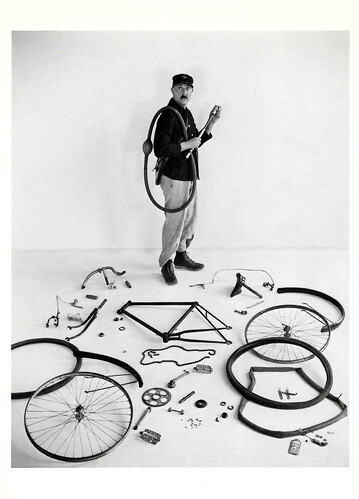
American postcard by Fotofolio, New York, NY, no. RD7. Photo: Robert Doisneau, 1949.
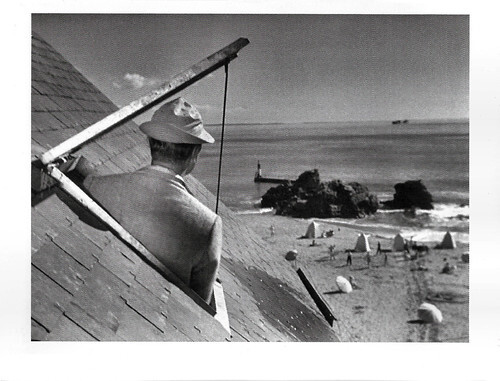
French postcard by Les Films de Mon Oncle, Paris. Photo: Collection Le Cinémathèque Française. Jacques Tati in Les Vacances de Monsieur Hulot/Mr. Hulot's Holiday (Jacques Tati, 1953).
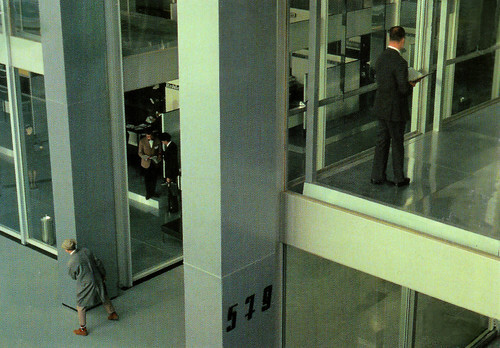
French postcard by Les Films de Mon Oncle, Paris. Jacques Tati in Playtime (Jacques Tati, 1967).
A peaceful village that does not escape modernity
Jacques Tati was born Jacques Tatischeff in 1907 in Le Pecq, 19 km west of the centre of Paris. He was the son of a Dutch mother and the Russian military attaché at the Russian embassy in Paris. At 18, he entered military service and from the age of 20, he was active as a professional rugby player. Later, he made a living as a pantomime player.
He was in variety theatre, where he performed several comic mime acts. Here he learnt the art of the comic movement and gained inspiration for his later films. His comic acts, based on various sports, were a success in the theatre. He made his screen debut in a series of short featurettes, tailored to show off his practised gags, notably Oscar, champion de tennis/Oscar, tennis champion (Jack Forrester, 1932) and Soigne ton gauche/Watch Your Left (René Clément, 1936), a very funny boxing sketch.
The Second World War, military service and inherent strictures resulting from the German occupation put a temporary halt to his career. Then, in 1946, through a friend, the writer-director Claude Autant-Lara, Jacques obtained a small role in the whimsical fantasy Sylvie et le fantôme/Sylvie and the Ghost (Claude Autant-Lara, 1946), about a girl ( Odette Joyeux ) in love with a ghost (Tati).
The small township of Sainte-Sévère, where Tati had taken refuge during the occupation, served as inspiration for his first film, the short L'école des facteurs/School for Postmen (Jacques Tati, 1947), in which Tati plays the character of François, a bumbling hyperactive postman. The film was so successful that Tati was offered the chance to make his first feature-length film, starring that same character.
Jour de fête (Jacques Tati, 1949) shows a postman in a rural village, Sainte-Sévère-sur-Indre, which is isolated and deprived compared to the rest of the modern world. But even the peaceful village does not escape modernity: on the day of the French national holiday on 14 July, a film is shown for the first time, and it is about the efficiency of the US postal service. In this film, postman François (played by Tati himself) sees how his colleagues in the United States deliver their mail by car and even by plane. François does everything by bike and now decides to drive his bike as fast as a car. The result is a whole series of stunts, which Tati himself performed on the bicycle. Jour de fête became a huge international success.
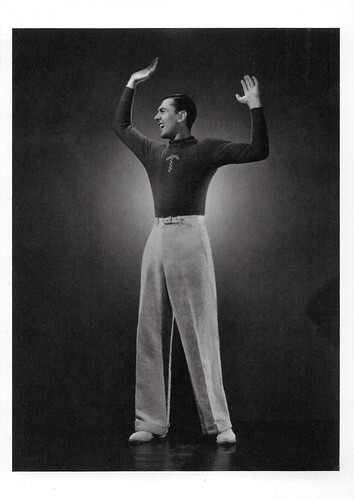
French postcard by Les Films de Mon Oncle. Photo: Collection La Cinémathèque Française. Jacques Tati in 'Impressions sportives' (1935).
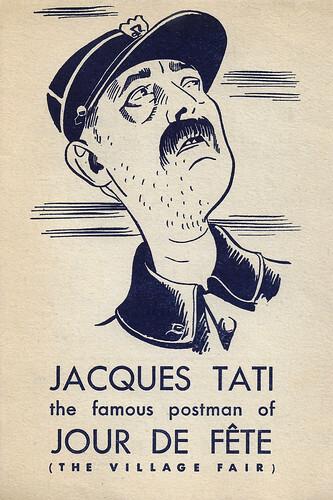
French postcard by Cinéma de L'Avenue, Paris. Image: Jacques Tati in Jour de Fête/The Village Fair (Jacques Tati, 1949). Caption: Three things to see during your stay in Paris. La Tour Eiffel, Le Chateau de Versailles and Jour de fête / The Village Fair with Jacques Tati. The greatest French comedian since Max Linder and Chaplin. English subtitles. Now playing at Cinéma de L'Avenue, 5, Rue du Colisée, Champs Élysees corner.

French postcard by Les Films de Mon Oncle. Photo: Collection Le Cinémathèque Française. Jacques Tati in Les Vacances de Monsieur Hulot/Mr. Hulot's Holiday (Jacques Tati, 1953).
An ungainly, yet hilarious figure
Jacques Tati then made the classic Les Vacances de Monsieur Hulot (Jacques Tati, 1953). In this film, Tati played the character of Monsieur Hulot for the first time. Tati took the name of the character from the architect Hulot who lived in the same apartment building as himself. Hulot arrives in a rickety 1924 Amilcar. I.S. Mowis at IMDb : "Tall and reedy, clad in a poplin coat, wearing a crumpled hat, striped socks, trousers which are patently too short, rolled umbrella, a pipe firmly clenched between his teeth and perambulating with an odd stiff-legged gait, Hulot cuts an ungainly, yet hilarious figure. Well-meaning though he is, he invariably leaves disaster in his wake and departs the scene quickly as things go wrong, letting others sort out the mess."
Monsieur Hulot would become one of the icons of comic cinematography. Style features of Tati are silent, small jokes hidden in a scene. These scenes are almost always filmed in total shots, keeping the camera and thus the audience at a distance. This makes the films like observations of people's behaviour. Tati shows the viewer an absurd, satirical mirror in which the viewer can recognise his own behaviour, from everyday life.
Another feature that made Tati differ from other slapstick actors was his use of sound. In Tati's films, the sound is as important as the image; many strange sound effects, such as footsteps, creaking and squeaking doors and clinking glass, enhance the effect of the jokes. In 1958, Tati made Mon Oncle (Jacques Tati, 1958), a comedy that was awarded the Oscar for best foreign film. This film also sees Tati as Monsieur Hulot. Tati criticises today's modern society in the film.
According to Tati, technology, decadence and greed started playing an increasing role in our society. Real human values such as individuality, sociability, helpfulness and exercise are lost as a result. Crowds are central to all of Tati's films, but there is always a character who refuses to adapt, but eventually dissolves into the masses.
This individual, played by Tati himself, fights (often unconsciously) against modernity. He understands nothing about machines and this often results in hilarious failures, in which modern technology is destroyed by human nature. The film juxtaposes the good old days with modern technology. Nostalgia clashes with the unimaginative, decadent, massive and impersonal world of modern times.
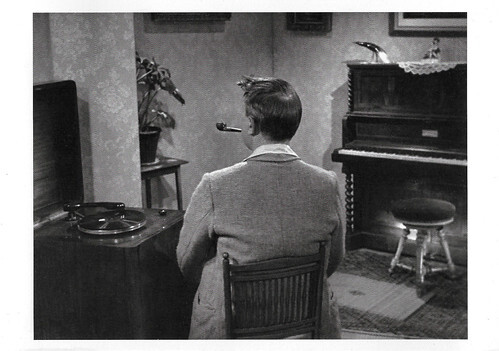
French postcard by Les Films de Mon Oncle. Photo: Collection La Cinémathèque Française. Jacques Tati in Les Vacances de Monsieur Hulot/Monsieur Hulot's Holiday (Jacques Tati, 1953).
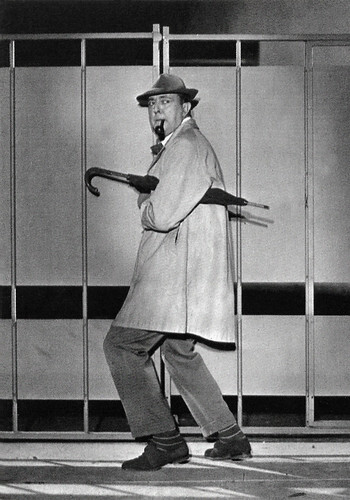
French postcard, no. C97. Jacques Tati in Mon Oncle/My Uncle (Jacques Tati, 1958).
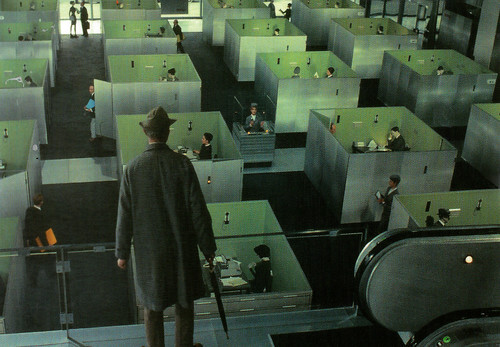
French postcard by Les Films de Mon Oncle, Paris. Jacques Tati in Playtime (Jacques Tati, 1967).
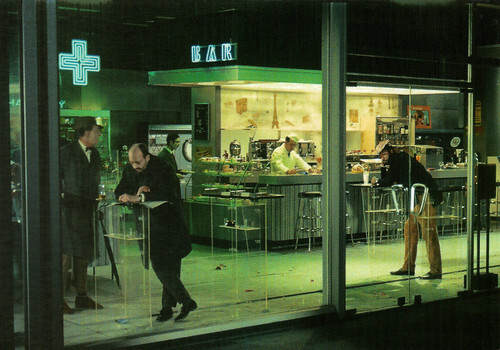
French postcard by Les Films de Mon Oncle, Paris. Jacques Tati in Playtime (Jacques Tati, 1967).
A Sci-Fi comedy in which the world was completely turned into a very large city
Jacques Tati then started working on an extremely expensive film, Playtime (Jacques Tati, 1967), a kind of Sci-Fi comedy in which the world was completely turned into a very large city. Lacking suitable filming locations, Tati had an entire full-scale futuristic city (Tativille) recreated in Joinville-le-Pont. The shooting took almost four years. It was shot in the expensive 70 mm format and the most extraordinary filming techniques were used. Tati experimented with colour and used a very recognisable soundtrack in his films, which is repeated again and again throughout the film.
When Playtime was released in 1967, critics' reactions were divided. In France, the film was reasonably successful, but nothing came of the intended American success: the film was not even released there. The picture's total budget had been $3 million and left Tati bankrupt. Tati was now unemployed: no one wanted to invest money in his films.
Only in 1972 did he return to the big screen, in the film Trafic (Jacques Tati, 1972), a satire of modern man's love of cars, partly shot in the Netherlands and co-directed by Dutch cinematographer Bert Haanstra. This film was not a success either. Tati then made the television film Parade (Jacques Tati, 1974), a comedy about circus life, for Swedish television. Creditors impounded Tati's films, which were not re-released until 1977 when a canny Parisian distributor expunged his outstanding debts.
Jacques Tati died of cancer in 1982 in Paris at the age of 75. Since 1944, he had been married to Micheline Winter with whom he had two children.
In 2010, L'Illusionniste was released, a full-length animated film by Sylvain Chomet, based on a script by Tati. The main character in this film, an old, disillusioned magician named Tatischeff, is a cartoon version of Monsieur Hulot. The idea to release Tati's script as a cartoon came from Tati's daughter who did not want another actor to imitate her father. In the film, the protagonist walks into a cinema where Mon Oncle is currently being played. The film is not so much comic as melodramatic and builds on Tati's ideas about alienation and the demise of old trades.
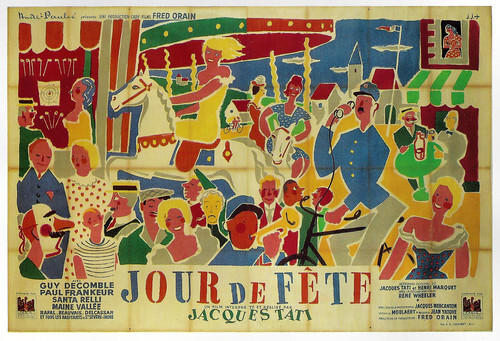
French postcard by La sociètè des Amis de la Bibliothèque Forney, Paris, Série J. Jacquelin, no. 5. Original poster design: Jean Jacquelin. Collection: Marc Savy. Film poster for Jour de fête/The Big Day (Jacques Tati, 1949).
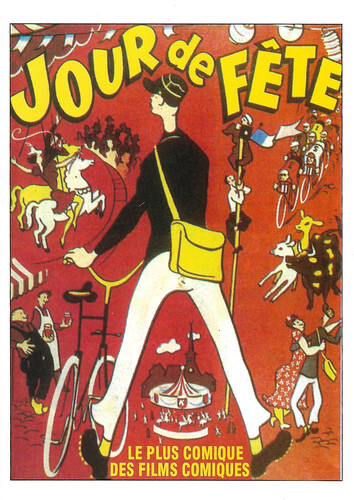
French postcard in the Encyclopédie du Cinéma series by Carterie Artistique et Cinématographique, Pont du Casse, no. EDC 394. Poster design: Film poster for Jour de fête/The Big Day (Jacques Tati, 1949). Caption: The funniest of all comedy films.
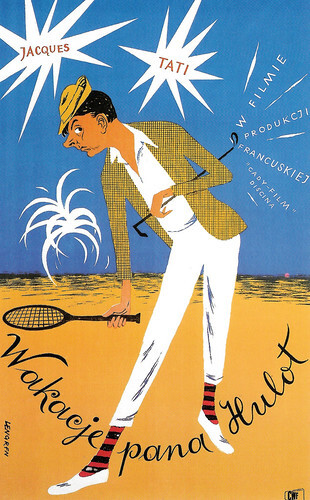
Swiss postcard by CVB Publishers / News Productions, no. 57212. Collection: Cinémathèque Suisse, Lausanne. Design poster: Lengren for CWF. Polish film poster for Les Vacances de Monsieur Hulot/Mr. Hulot's Holiday (Jacques Tati, 1953).
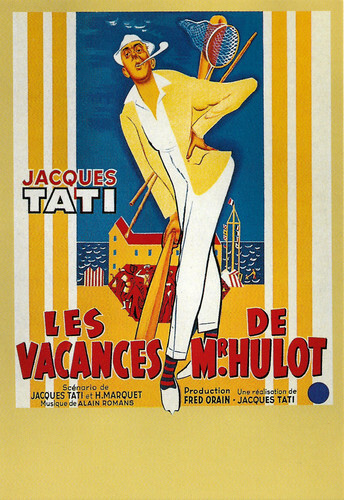
French postcard by Editions Zreik, Paris, in the Collection Télérama, La mémoire du cinéma, no. 170. Film poster for Les Vacances de Monsieur Hulot/Mr. Hulot's Holiday (Jacques Tati, 1953).
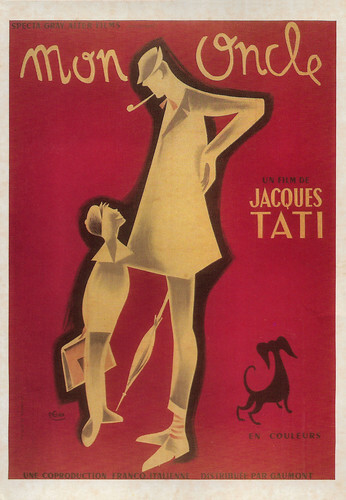
French postcard by Editions Ramsay, no. 170. Image: Pierre Étaix / Gaumont. Film poster for Mon Oncle/My Uncle (Jacques Tati, 1958).
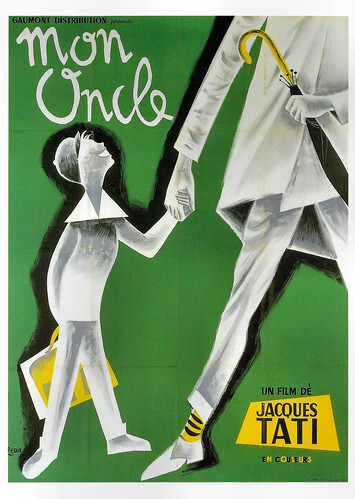
Swiss postcard by CVB Publishers, no. 57383. Collection Cinématèque Suisse, Lausanne. Film poster for Monb Oncle (Jacques Tati, 1958).
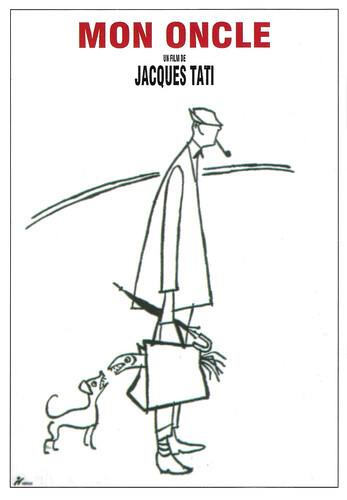
French postcard in the Encyclopédie du Cinéma series by Carterie Artistique et Cinématographique, Pont du Casse, no. EDC 395. Film poster for Mon Oncle (Jacques Tati, 1958).
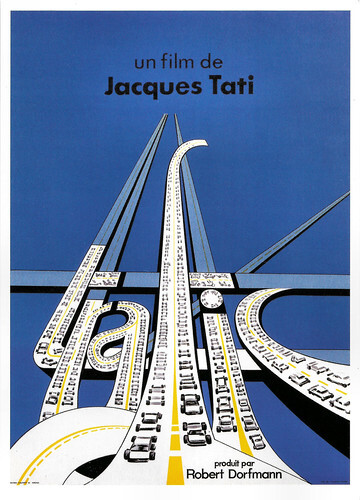
French postcard by CVB Publishers, no. 57383, Collection Cinémathèque Suisse Lausanne. Jacques Tati in Trafic (Jacques Tati, 1971).
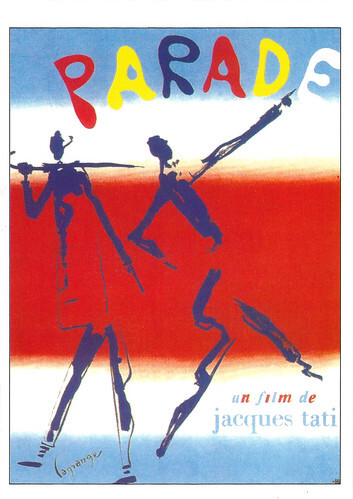
French postcard in the Encyclopédie du Cinéma series by Carterie Artistique et Cinématographique, Pont du Casse, no. EDC 392. Poster design: Lagrange. Film poster for Parade (Jacques Tati, 1974).
Sources: Wikipedia (Dutch) and .

American postcard by Fotofolio, New York, NY, no. RD7. Photo: Robert Doisneau, 1949.

French postcard by Les Films de Mon Oncle, Paris. Photo: Collection Le Cinémathèque Française. Jacques Tati in Les Vacances de Monsieur Hulot/Mr. Hulot's Holiday (Jacques Tati, 1953).

French postcard by Les Films de Mon Oncle, Paris. Jacques Tati in Playtime (Jacques Tati, 1967).
A peaceful village that does not escape modernity
Jacques Tati was born Jacques Tatischeff in 1907 in Le Pecq, 19 km west of the centre of Paris. He was the son of a Dutch mother and the Russian military attaché at the Russian embassy in Paris. At 18, he entered military service and from the age of 20, he was active as a professional rugby player. Later, he made a living as a pantomime player.
He was in variety theatre, where he performed several comic mime acts. Here he learnt the art of the comic movement and gained inspiration for his later films. His comic acts, based on various sports, were a success in the theatre. He made his screen debut in a series of short featurettes, tailored to show off his practised gags, notably Oscar, champion de tennis/Oscar, tennis champion (Jack Forrester, 1932) and Soigne ton gauche/Watch Your Left (René Clément, 1936), a very funny boxing sketch.
The Second World War, military service and inherent strictures resulting from the German occupation put a temporary halt to his career. Then, in 1946, through a friend, the writer-director Claude Autant-Lara, Jacques obtained a small role in the whimsical fantasy Sylvie et le fantôme/Sylvie and the Ghost (Claude Autant-Lara, 1946), about a girl ( Odette Joyeux ) in love with a ghost (Tati).
The small township of Sainte-Sévère, where Tati had taken refuge during the occupation, served as inspiration for his first film, the short L'école des facteurs/School for Postmen (Jacques Tati, 1947), in which Tati plays the character of François, a bumbling hyperactive postman. The film was so successful that Tati was offered the chance to make his first feature-length film, starring that same character.
Jour de fête (Jacques Tati, 1949) shows a postman in a rural village, Sainte-Sévère-sur-Indre, which is isolated and deprived compared to the rest of the modern world. But even the peaceful village does not escape modernity: on the day of the French national holiday on 14 July, a film is shown for the first time, and it is about the efficiency of the US postal service. In this film, postman François (played by Tati himself) sees how his colleagues in the United States deliver their mail by car and even by plane. François does everything by bike and now decides to drive his bike as fast as a car. The result is a whole series of stunts, which Tati himself performed on the bicycle. Jour de fête became a huge international success.

French postcard by Les Films de Mon Oncle. Photo: Collection La Cinémathèque Française. Jacques Tati in 'Impressions sportives' (1935).

French postcard by Cinéma de L'Avenue, Paris. Image: Jacques Tati in Jour de Fête/The Village Fair (Jacques Tati, 1949). Caption: Three things to see during your stay in Paris. La Tour Eiffel, Le Chateau de Versailles and Jour de fête / The Village Fair with Jacques Tati. The greatest French comedian since Max Linder and Chaplin. English subtitles. Now playing at Cinéma de L'Avenue, 5, Rue du Colisée, Champs Élysees corner.

French postcard by Les Films de Mon Oncle. Photo: Collection Le Cinémathèque Française. Jacques Tati in Les Vacances de Monsieur Hulot/Mr. Hulot's Holiday (Jacques Tati, 1953).
An ungainly, yet hilarious figure
Jacques Tati then made the classic Les Vacances de Monsieur Hulot (Jacques Tati, 1953). In this film, Tati played the character of Monsieur Hulot for the first time. Tati took the name of the character from the architect Hulot who lived in the same apartment building as himself. Hulot arrives in a rickety 1924 Amilcar. I.S. Mowis at IMDb : "Tall and reedy, clad in a poplin coat, wearing a crumpled hat, striped socks, trousers which are patently too short, rolled umbrella, a pipe firmly clenched between his teeth and perambulating with an odd stiff-legged gait, Hulot cuts an ungainly, yet hilarious figure. Well-meaning though he is, he invariably leaves disaster in his wake and departs the scene quickly as things go wrong, letting others sort out the mess."
Monsieur Hulot would become one of the icons of comic cinematography. Style features of Tati are silent, small jokes hidden in a scene. These scenes are almost always filmed in total shots, keeping the camera and thus the audience at a distance. This makes the films like observations of people's behaviour. Tati shows the viewer an absurd, satirical mirror in which the viewer can recognise his own behaviour, from everyday life.
Another feature that made Tati differ from other slapstick actors was his use of sound. In Tati's films, the sound is as important as the image; many strange sound effects, such as footsteps, creaking and squeaking doors and clinking glass, enhance the effect of the jokes. In 1958, Tati made Mon Oncle (Jacques Tati, 1958), a comedy that was awarded the Oscar for best foreign film. This film also sees Tati as Monsieur Hulot. Tati criticises today's modern society in the film.
According to Tati, technology, decadence and greed started playing an increasing role in our society. Real human values such as individuality, sociability, helpfulness and exercise are lost as a result. Crowds are central to all of Tati's films, but there is always a character who refuses to adapt, but eventually dissolves into the masses.
This individual, played by Tati himself, fights (often unconsciously) against modernity. He understands nothing about machines and this often results in hilarious failures, in which modern technology is destroyed by human nature. The film juxtaposes the good old days with modern technology. Nostalgia clashes with the unimaginative, decadent, massive and impersonal world of modern times.

French postcard by Les Films de Mon Oncle. Photo: Collection La Cinémathèque Française. Jacques Tati in Les Vacances de Monsieur Hulot/Monsieur Hulot's Holiday (Jacques Tati, 1953).

French postcard, no. C97. Jacques Tati in Mon Oncle/My Uncle (Jacques Tati, 1958).

French postcard by Les Films de Mon Oncle, Paris. Jacques Tati in Playtime (Jacques Tati, 1967).

French postcard by Les Films de Mon Oncle, Paris. Jacques Tati in Playtime (Jacques Tati, 1967).
A Sci-Fi comedy in which the world was completely turned into a very large city
Jacques Tati then started working on an extremely expensive film, Playtime (Jacques Tati, 1967), a kind of Sci-Fi comedy in which the world was completely turned into a very large city. Lacking suitable filming locations, Tati had an entire full-scale futuristic city (Tativille) recreated in Joinville-le-Pont. The shooting took almost four years. It was shot in the expensive 70 mm format and the most extraordinary filming techniques were used. Tati experimented with colour and used a very recognisable soundtrack in his films, which is repeated again and again throughout the film.
When Playtime was released in 1967, critics' reactions were divided. In France, the film was reasonably successful, but nothing came of the intended American success: the film was not even released there. The picture's total budget had been $3 million and left Tati bankrupt. Tati was now unemployed: no one wanted to invest money in his films.
Only in 1972 did he return to the big screen, in the film Trafic (Jacques Tati, 1972), a satire of modern man's love of cars, partly shot in the Netherlands and co-directed by Dutch cinematographer Bert Haanstra. This film was not a success either. Tati then made the television film Parade (Jacques Tati, 1974), a comedy about circus life, for Swedish television. Creditors impounded Tati's films, which were not re-released until 1977 when a canny Parisian distributor expunged his outstanding debts.
Jacques Tati died of cancer in 1982 in Paris at the age of 75. Since 1944, he had been married to Micheline Winter with whom he had two children.
In 2010, L'Illusionniste was released, a full-length animated film by Sylvain Chomet, based on a script by Tati. The main character in this film, an old, disillusioned magician named Tatischeff, is a cartoon version of Monsieur Hulot. The idea to release Tati's script as a cartoon came from Tati's daughter who did not want another actor to imitate her father. In the film, the protagonist walks into a cinema where Mon Oncle is currently being played. The film is not so much comic as melodramatic and builds on Tati's ideas about alienation and the demise of old trades.

French postcard by La sociètè des Amis de la Bibliothèque Forney, Paris, Série J. Jacquelin, no. 5. Original poster design: Jean Jacquelin. Collection: Marc Savy. Film poster for Jour de fête/The Big Day (Jacques Tati, 1949).

French postcard in the Encyclopédie du Cinéma series by Carterie Artistique et Cinématographique, Pont du Casse, no. EDC 394. Poster design: Film poster for Jour de fête/The Big Day (Jacques Tati, 1949). Caption: The funniest of all comedy films.

Swiss postcard by CVB Publishers / News Productions, no. 57212. Collection: Cinémathèque Suisse, Lausanne. Design poster: Lengren for CWF. Polish film poster for Les Vacances de Monsieur Hulot/Mr. Hulot's Holiday (Jacques Tati, 1953).

French postcard by Editions Zreik, Paris, in the Collection Télérama, La mémoire du cinéma, no. 170. Film poster for Les Vacances de Monsieur Hulot/Mr. Hulot's Holiday (Jacques Tati, 1953).

French postcard by Editions Ramsay, no. 170. Image: Pierre Étaix / Gaumont. Film poster for Mon Oncle/My Uncle (Jacques Tati, 1958).

Swiss postcard by CVB Publishers, no. 57383. Collection Cinématèque Suisse, Lausanne. Film poster for Monb Oncle (Jacques Tati, 1958).

French postcard in the Encyclopédie du Cinéma series by Carterie Artistique et Cinématographique, Pont du Casse, no. EDC 395. Film poster for Mon Oncle (Jacques Tati, 1958).

French postcard by CVB Publishers, no. 57383, Collection Cinémathèque Suisse Lausanne. Jacques Tati in Trafic (Jacques Tati, 1971).

French postcard in the Encyclopédie du Cinéma series by Carterie Artistique et Cinématographique, Pont du Casse, no. EDC 392. Poster design: Lagrange. Film poster for Parade (Jacques Tati, 1974).
Sources: Wikipedia (Dutch) and .
Published on March 02, 2023 22:00
Georges Wague on stage
Georges Wague (1874-1965) was a French mime, teacher and silent film actor who performed in more than forty films between 1907 and 1922. We published before about Wague's films, but this post focuses on his equally interesting stage career.
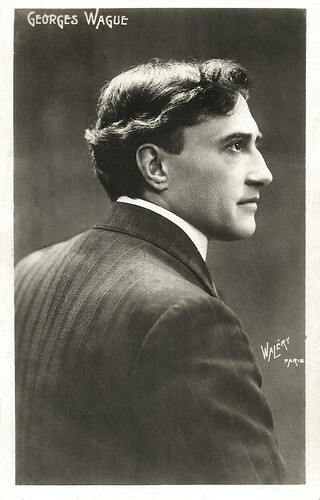
French postcard. Photo Waléry, Paris.
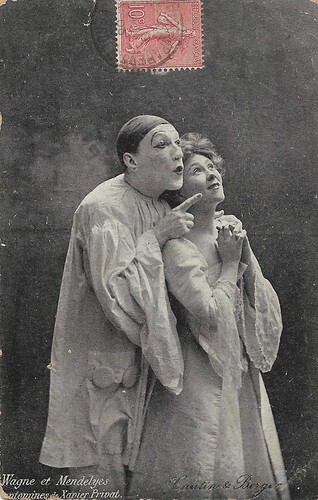
French postcard by Cautin & Berger, ca. 1900, mailed July 1905. Georges Wagne [sic, = Wague] and Mendelyes [sic, = Christiane Mendelys, aka Christiane Wague]. Caption: Cantomines [sic, = cantomimes] de Xavier Privat [sic, = Privas].
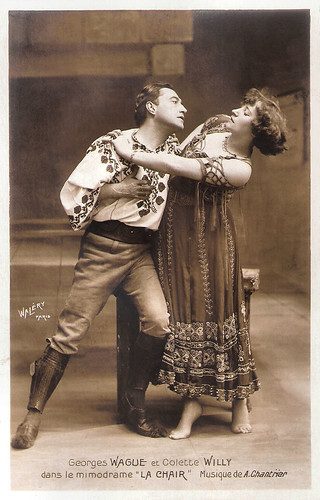
French postcard. Photo: Waléry, Paris. Georges Wague| and Colette Willy in La Chair (The Flesh, 1907) written by Georges Wague and Leon Lambert, with music by Albert Chantrier. It was Colette 's greatest stage success.
The invention of the Cantomime
Georges Wague was born Georges Marie Valentin Waag in Paris in 1874. His parents were strict and devout. His mother died when he was nine, and he was placed in l’école des Frères de la doctrine chrétienne (the school of the Brothers of the Christian doctrine) in Paris. Here he helped with performances given by the association of young people from the parish of Saint-Sulpice and began to recite poetry with this association. He qualified as an electrical engineer before entering the Conservatory of Dramatic Art of Paris as an auditor. At the Conservatory he attended the course given by Dupont Vernon.
In the early 1890s, Wague participated in the soirées of La Plume, the literary magazine founded by Léon Deschamps, where he was noticed for his verse recitals. Xavier Privas proposed to sing songs while Georges Wague mimed them, creating a new artistic expression they called 'Cantomime'. Cantomime from "canto" (singing) and mime. In the cantomimes, which began in 1893 at the Café Procope, Wague performed on stage with a singer and piano in the wings. Often the character was Pierrot. The established mime Félicia Mallet assisted Wague in developing his highly individual style during the early part of his career. He moved to the Bodinière theatre where he became known in Paris with his cantomimes including 'Noël de Pierrot' (1894) and 'Le Testament de Pierrot' (1895).
Wague first staged his pantomime at the Théâtre Montparnasse in 1895, 'Le Voeu de Musette'. Many others followed over the years. To revive his career after his return from military service in 1898, Georges Wague began to participate in soirées of the 'Veillées artistiques de Plaisance'. Cantomimes included 'Pierrot Chante' (1899) and 'Sommeil Blanc' (1899). 'Sommeil Blanc' (White Sleep) was written for him by Xavier Privas, with music by Louis Huvey.
Due to rivalry with other performers of cantomimes, Wague created a company with Christiane Mandelys (or Mendelys), who became his wife, to preserve his rights as the inventor of the concept. With his troupe, he played 'La Roulotte' (The Caravan) directed by Georges Chartron. He won success and began touring in France and abroad, leading to the presentation of the last show at the Exposition Universelle (1900) where he played several Pierrot plays including 'Pierrot infidèle' (Unfaithful Pierrot) and 'Le Noël de Pierrot' (Christmas Pierrot).
George Wague decided to move from white pantomime, in which gestures and movements were ample, to dramatic pantomime. To do this, he changed his stage acting: his mime consisted of gestures reduced to the simplest attitudes to express the full range of thought in constant movement. He did not use the conventional alphabet of mimes in this original form of expression.
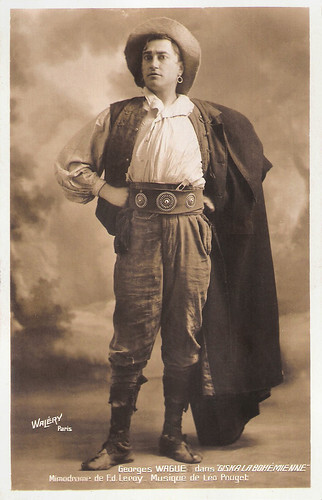
French postcard by Editions artistique de Walery. Photo: Walery, Paris. Publicity still for the play Giska la Bohémienne (1908) by Ed. Leroy.
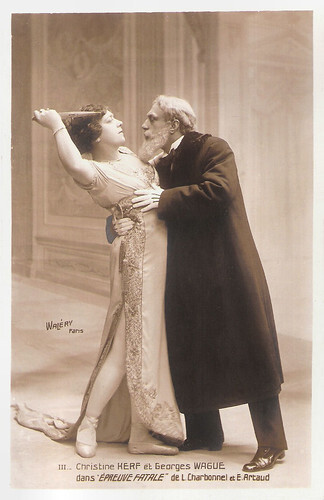
French postcard by Editions artistique de Walery. Photo: Walery, Paris. Georges Wague and Christine Kerf in the play 'Épreuve Fatale' (1913) by Leon Charbonnel and Emile Artaud.
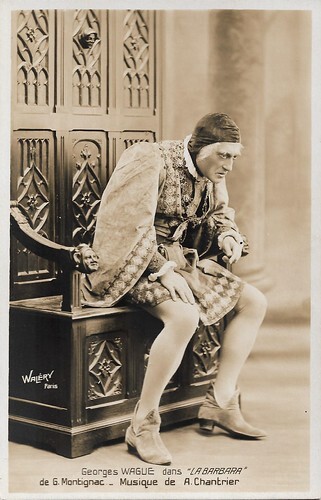
Vintage French postcard. Photo by Waléry, Paris. Georges Wague in the lead of the play 'La Barbara' by G. Montignac and Wague, music by A. Chantrier, performed e.g. in June 1913 at the Ba-Ta-Clan in Paris.
Colette and La Argentina
Georges Wague taught pantomime, notably to the writer Colette , with whom he made a tour from 1906 to 1912 and caused a scandal with presentations of 'La Chair' (The Flesh) where Colette performed largely naked.
Wague performed in many other stage pantomimes including 'Scaramouche', 'Barbe Bluette' and 'L'homme aux poupées', and played silent roles in ballet and opera. He continued to play a white-faced Pierrot at the Opéra-Comique during the 1920s.
From 1916 Wague taught at the Conservatoire national supérieur d'art dramatique. Wague taught mimes who went on the fame such as Christine Kerf, Caroline Otéro, Angèle Héraud and Charlotte Wiehé. In 1920, he and his wife Christiane Mandelys opened a mime and comedy school in their home on rue Pigalle. He also taught actors and opera singers how to use their bodies to express their feelings. This skill was much neglected in opera, where often the singers were chosen for their voice rather than their appearance and had little acting ability.
In 1925 he performed with the flamenco dancer Antonia Mercé y Luque, "La Argentina", in 'El amor brujo' at the Théâtre Trianon-Lyrique. Later, Wague collaborated with the mime and actor Jean-Louis Barrault when he played Jean-Gaspard Deburau in the classic film Les Enfants du Paradis/Children of Paradise (Marcel Carné, 1943), the basis for his 1946 mime piece 'Baptiste'.
After the death of his wife, Christiane Mandelys, in 1957, he collected his archives and deposited them in the Bibliothèque nationale. Georges Wague was awarded the 'Grande médaille de vermeil' by the city of Paris in 1962. In 1965, Wague died at Menton in the Alpes-Maritimes, aged 91.
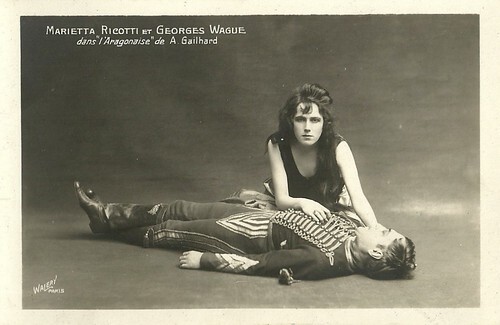
French postcard. Photo: Waléry, Paris. Georges Wague and Marietta Ricotti in 'L'Aragonaise' by A. Gailhard. L'Aragonaise was a pantomime by Wague, with songs by Gailhard/Gaillard. Ricotti was a singer from the Paris Opera.
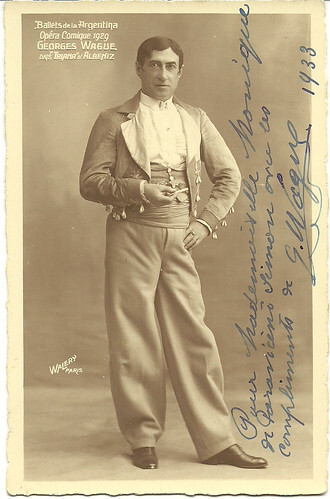
French postcard by Walery, Paris, 1929. Photo: Walery, Paris. Publicity still for the Ballets Argentina / Operas Comique production of Triana by Albeniz. Collection: Didier Hanson.
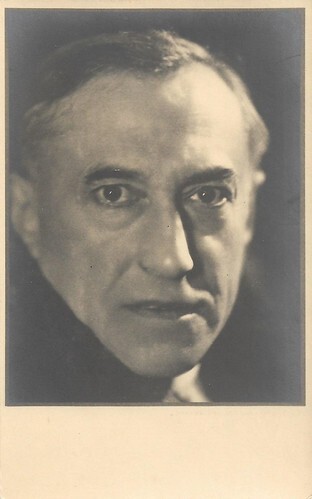
British postcard by K Ltd.
Source: Wikipedia (English and French) and . See also Tami Williams, 'The “Silent” Arts. Modern Pantomime and the Making of an Art Cinema in Belle Époque Paris: The Case of Georges Wague and Germaine Dulac', in A Companion to Early Cinema (2012).

French postcard. Photo Waléry, Paris.

French postcard by Cautin & Berger, ca. 1900, mailed July 1905. Georges Wagne [sic, = Wague] and Mendelyes [sic, = Christiane Mendelys, aka Christiane Wague]. Caption: Cantomines [sic, = cantomimes] de Xavier Privat [sic, = Privas].

French postcard. Photo: Waléry, Paris. Georges Wague| and Colette Willy in La Chair (The Flesh, 1907) written by Georges Wague and Leon Lambert, with music by Albert Chantrier. It was Colette 's greatest stage success.
The invention of the Cantomime
Georges Wague was born Georges Marie Valentin Waag in Paris in 1874. His parents were strict and devout. His mother died when he was nine, and he was placed in l’école des Frères de la doctrine chrétienne (the school of the Brothers of the Christian doctrine) in Paris. Here he helped with performances given by the association of young people from the parish of Saint-Sulpice and began to recite poetry with this association. He qualified as an electrical engineer before entering the Conservatory of Dramatic Art of Paris as an auditor. At the Conservatory he attended the course given by Dupont Vernon.
In the early 1890s, Wague participated in the soirées of La Plume, the literary magazine founded by Léon Deschamps, where he was noticed for his verse recitals. Xavier Privas proposed to sing songs while Georges Wague mimed them, creating a new artistic expression they called 'Cantomime'. Cantomime from "canto" (singing) and mime. In the cantomimes, which began in 1893 at the Café Procope, Wague performed on stage with a singer and piano in the wings. Often the character was Pierrot. The established mime Félicia Mallet assisted Wague in developing his highly individual style during the early part of his career. He moved to the Bodinière theatre where he became known in Paris with his cantomimes including 'Noël de Pierrot' (1894) and 'Le Testament de Pierrot' (1895).
Wague first staged his pantomime at the Théâtre Montparnasse in 1895, 'Le Voeu de Musette'. Many others followed over the years. To revive his career after his return from military service in 1898, Georges Wague began to participate in soirées of the 'Veillées artistiques de Plaisance'. Cantomimes included 'Pierrot Chante' (1899) and 'Sommeil Blanc' (1899). 'Sommeil Blanc' (White Sleep) was written for him by Xavier Privas, with music by Louis Huvey.
Due to rivalry with other performers of cantomimes, Wague created a company with Christiane Mandelys (or Mendelys), who became his wife, to preserve his rights as the inventor of the concept. With his troupe, he played 'La Roulotte' (The Caravan) directed by Georges Chartron. He won success and began touring in France and abroad, leading to the presentation of the last show at the Exposition Universelle (1900) where he played several Pierrot plays including 'Pierrot infidèle' (Unfaithful Pierrot) and 'Le Noël de Pierrot' (Christmas Pierrot).
George Wague decided to move from white pantomime, in which gestures and movements were ample, to dramatic pantomime. To do this, he changed his stage acting: his mime consisted of gestures reduced to the simplest attitudes to express the full range of thought in constant movement. He did not use the conventional alphabet of mimes in this original form of expression.

French postcard by Editions artistique de Walery. Photo: Walery, Paris. Publicity still for the play Giska la Bohémienne (1908) by Ed. Leroy.

French postcard by Editions artistique de Walery. Photo: Walery, Paris. Georges Wague and Christine Kerf in the play 'Épreuve Fatale' (1913) by Leon Charbonnel and Emile Artaud.

Vintage French postcard. Photo by Waléry, Paris. Georges Wague in the lead of the play 'La Barbara' by G. Montignac and Wague, music by A. Chantrier, performed e.g. in June 1913 at the Ba-Ta-Clan in Paris.
Colette and La Argentina
Georges Wague taught pantomime, notably to the writer Colette , with whom he made a tour from 1906 to 1912 and caused a scandal with presentations of 'La Chair' (The Flesh) where Colette performed largely naked.
Wague performed in many other stage pantomimes including 'Scaramouche', 'Barbe Bluette' and 'L'homme aux poupées', and played silent roles in ballet and opera. He continued to play a white-faced Pierrot at the Opéra-Comique during the 1920s.
From 1916 Wague taught at the Conservatoire national supérieur d'art dramatique. Wague taught mimes who went on the fame such as Christine Kerf, Caroline Otéro, Angèle Héraud and Charlotte Wiehé. In 1920, he and his wife Christiane Mandelys opened a mime and comedy school in their home on rue Pigalle. He also taught actors and opera singers how to use their bodies to express their feelings. This skill was much neglected in opera, where often the singers were chosen for their voice rather than their appearance and had little acting ability.
In 1925 he performed with the flamenco dancer Antonia Mercé y Luque, "La Argentina", in 'El amor brujo' at the Théâtre Trianon-Lyrique. Later, Wague collaborated with the mime and actor Jean-Louis Barrault when he played Jean-Gaspard Deburau in the classic film Les Enfants du Paradis/Children of Paradise (Marcel Carné, 1943), the basis for his 1946 mime piece 'Baptiste'.
After the death of his wife, Christiane Mandelys, in 1957, he collected his archives and deposited them in the Bibliothèque nationale. Georges Wague was awarded the 'Grande médaille de vermeil' by the city of Paris in 1962. In 1965, Wague died at Menton in the Alpes-Maritimes, aged 91.

French postcard. Photo: Waléry, Paris. Georges Wague and Marietta Ricotti in 'L'Aragonaise' by A. Gailhard. L'Aragonaise was a pantomime by Wague, with songs by Gailhard/Gaillard. Ricotti was a singer from the Paris Opera.

French postcard by Walery, Paris, 1929. Photo: Walery, Paris. Publicity still for the Ballets Argentina / Operas Comique production of Triana by Albeniz. Collection: Didier Hanson.

British postcard by K Ltd.
Source: Wikipedia (English and French) and . See also Tami Williams, 'The “Silent” Arts. Modern Pantomime and the Making of an Art Cinema in Belle Époque Paris: The Case of Georges Wague and Germaine Dulac', in A Companion to Early Cinema (2012).
Published on March 02, 2023 02:11
March 1, 2023
The Ten Commandments (1956)
The Ten Commandments (1956) was director and producer Cecil B. DeMille's last and most successful film, a partial remake of his 1923 silent film of the same title. It was filmed on location in Egypt, Mount Sinai and the Sinai Peninsula, shot in VistaVision with colour by Technicolor. The film dramatises the biblical story of the life of Moses, an adopted Egyptian prince who becomes the deliverer of his real brethren, the enslaved Hebrews. He leads the Exodus to Mount Sinai, where he receives, from God, the Ten Commandments. Charlton Heston played Moses, Yul Brynner played his jealous half-brother Rameses II and Anne Baxter the Egyptian throne princess Nefretiri.
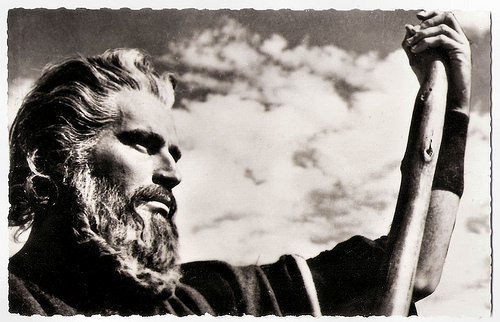
French postcard by Editions P.I., Paris, no. 830. Offered by Les Carbones Korès "Carboplane". Photo: Paramount. Publicity still for The Ten Commandments (Cecil B. DeMille, 1956).
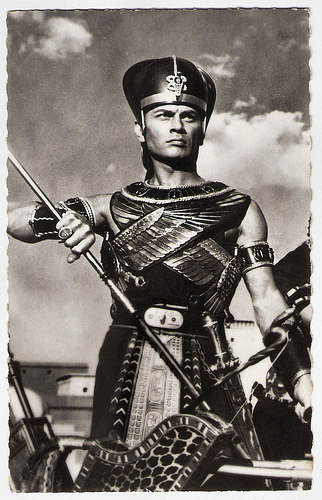
French postcard by Editions P.I., Paris, no. 831. Photo: Paramount. Publicity still for The Ten Commandments (Cecil B. DeMille, 1956). For his pursuit of the Israelites, Yul Brynner in his role as Rameses II wears the blue Khepresh helmet crown, which the pharaohs wore for battle.
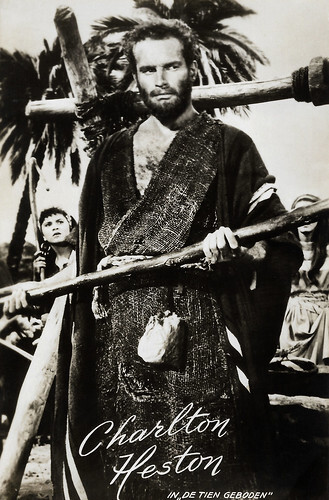
Belgian postcard by Papeterie, Bruxelles no. 3847. Photo: Paramount. Charlton Heston in The Ten Commandments (Cecil B. DeMille, 1956).
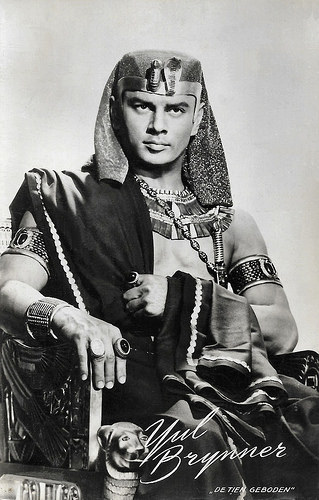
Dutch postcard by Uitg. Takken, no. AX 3871. Photo: Paramount. Publicity still for The Ten Commandments (Cecil B. DeMille, 1956).
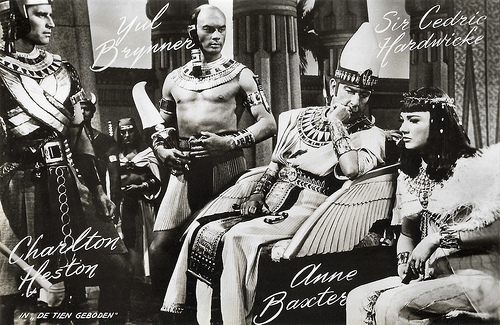
Dutch postcard by Uitg. Takken, no. AX 3881. Photo: Paramount. Publicity still for The Ten Commandments (Cecil B. DeMille, 1956) with Charlton Heston , Yul Brynner , Sir Cedric Hardwicke and Anne Baxter.
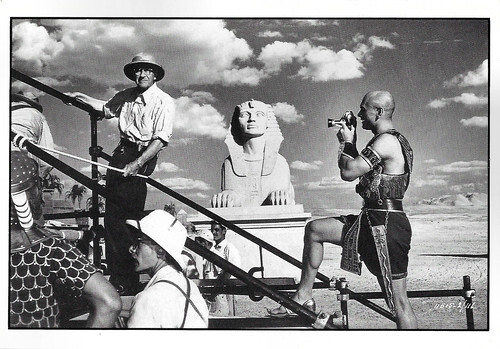
French postcard in the Entr'acte series by Éditions Asphodèle. Mâcon, no. 004/2. Photo: Collection B. Courtel / D.R. Cecil B. DeMille and Yul Brynner on the set of The Ten Commandments (Cecil B. DeMille, 1955). Caption: Yul Brynner, film actor and photo enthusiast, takes a break to photograph director Cecil B. DeMille.
Put on Earth to do God’s will
Based on the Holy Scriptures, with additional dialogue by several other hands, The Ten Commandments (Cecil B. DeMille, 1956) tells the story of Moses, leader of the Hebrews, considered to have been a prophet by Jews, Christians and Muslims. He is thought to have lived in Egypt, in or around the 14th century BC.
The older he became, the more Cecil B. DeMille was convinced that he had been put on Earth to do God’s will. He decided to remake The Ten Commandments, in response, he claimed, to scores of imploring letters: “The world needs a reminder, they said, of the Law of God.”
Charlton Heston , who had previously worked with DeMille in The Greatest Show on Earth (Cecil B. DeMille, 1952), won the part of Moses after he impressed DeMille at his audition with his knowledge of ancient Egypt. The film follows Moses from the time he was discovered in the bull rushes as an infant by the Pharaoh's daughter, to his long, hard struggle to free the Hebrews from their slavery at the hands of the Egyptians.
Heston was also chosen to be the voice of God in the form of a burning bush, toned down to a softer and lower register. As soon as Heston announced to DeMille that his wife Lydia was pregnant, Heston's newborn son, Fraser (1955), was cast by DeMille. Fraser Heston was three months old during filming.
Edward G. Robinson was cast as Dathan, Yvonne De Carlo as Sephora, Debra Paget as Lilia, and John Derek as Joshua. The film features Sir Cedric Hardwicke as Sethi, Nina Foch as Bithiah, Martha Scott as Yoshebel, Judith Anderson as Memnet, and Vincent Price as Baka. For the large crowd shots, at least 14,000 extras and 15,000 animals were used.
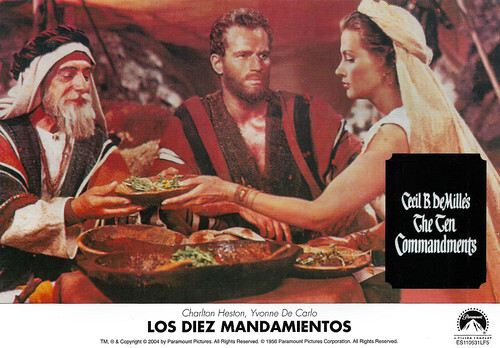
Spanish card, 2004. Photo: Paramount. Charlton Heston and Yvonne De Carlo in The Ten Commandments (Cecil B. DeMille, 1956).
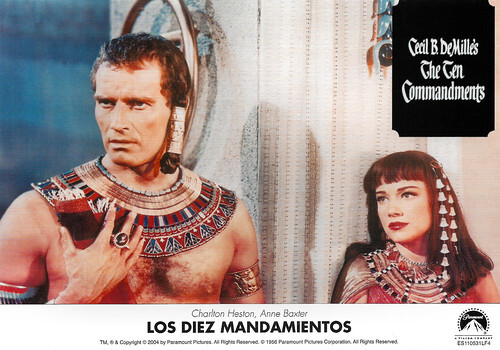
Spanish card, 2004. Photo: Paramount. Charlton Heston and Anne Baxter in The Ten Commandments (Cecil B. DeMille, 1956).
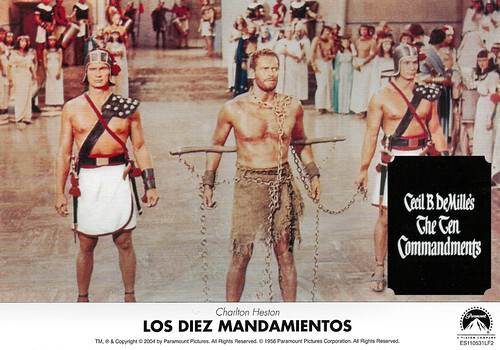
Spanish card, 2004. Photo: Paramount. Charlton Heston in The Ten Commandments (Cecil B. DeMille, 1956).
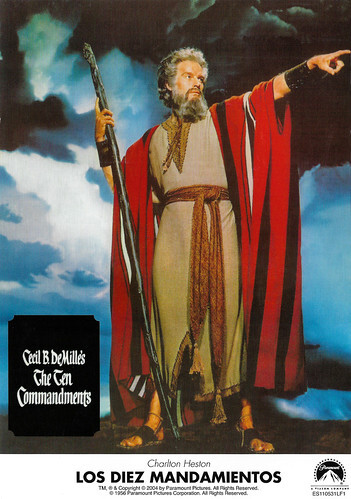
Spanish card, 2004. Photo: Paramount. Charlton Heston in The Ten Commandments (Cecil B. DeMille, 1956).
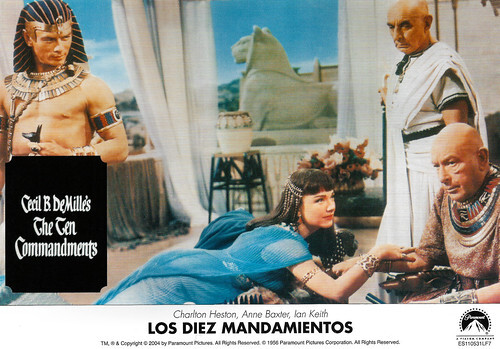
Spanish card, 2004. Photo: Paramount. Charlton Heston , Anne Baxter and Ian Keith in The Ten Commandments (Cecil B. DeMille, 1956).
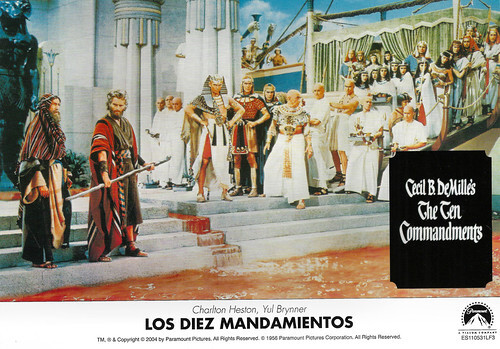
Spanish card, 2004. Photo: Paramount. Charlton Heston and Yul Brynner in The Ten Commandments (Cecil B. DeMille, 1956).
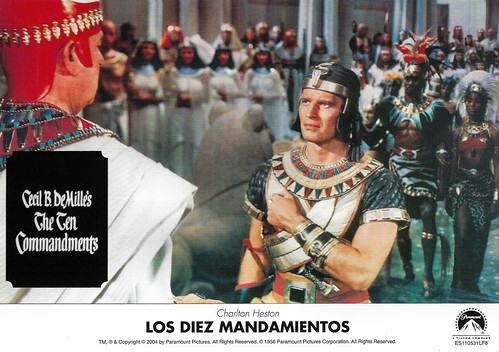
Spanish card, 2004. Photo: Paramount. Charlton Heston in The Ten Commandments (Cecil B. DeMille, 1956).
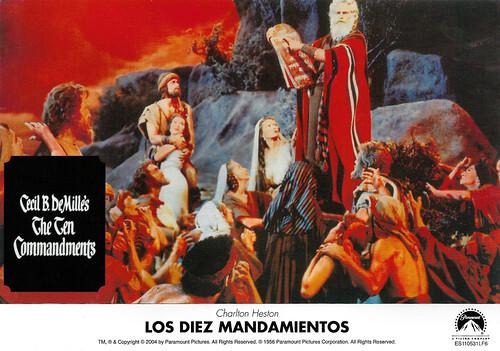
Spanish card, 2004. Photo: Paramount. Charlton Heston in The Ten Commandments (Cecil B. DeMille, 1956).
The most eventful 219 minutes ever recorded
In 1957, The Ten Commandments was nominated for seven Oscars, including Best Picture. John P. Fulton, head of the special effects department at Paramount, won the Academy Award for his effects. Fulton’s effects included the building of Sethi’s Jubilee treasure city, the Burning Bush, the fiery hail from a cloudless sky, the Angel of Death, the composites of the Exodus, the Pillar of Fire, the giving of the Ten Commandments, and the highlight, the parting of the Red Sea.
The production, at the time incredibly expensive with a budget of $13 million, grossed $122.7 million at the box office. It was re-released in 1966 and 1972, and one more time in 1989. The liberties taken with the biblical story of Exodus nor its nearly four-hour length has had any effect on its popularity. According to Guinness World Records, in terms of theatrical exhibition, The Ten Commandments (1956) is the seventh most successful film of all time when the box office gross is adjusted for inflation.
During production, DeMille had customarily spread out prints of paintings by Lawrence Alma-Tadema to inform his set designers of the look he wanted to achieve. However, in terms of accuracy about Moses and his time, The Ten Commandments is patchy. Alex von Tunzelmann in The Guardian: “It's amazing how much the fashions of New Kingdom Egypt seem to resemble those of 1956. DeMille can just about be forgiven for the makeup because ancient Egyptians did indeed paint their eyelids, lips and nails, but he is pushing it by dressing dancing girls in fluorescent green bikinis. At least the spectacular scenes filmed on location in Egypt and Sinai, with thousands of extras, lend the whole thing a sense of authenticity.”
Hal Erickson at AllMovie : “DeMille's The Ten Commandments may not be the most subtle and sophisticated entertainment ever concocted, but it tells its story with a clarity and vitality that few Biblical scholars have ever been able to duplicate. It is very likely the most eventful 219 minutes ever recorded to film - and who's to say that Nefertiri (Anne Baxter) didn't make speeches like, "Oh, Moses, Moses, you splendid, stubborn, adorable fool"?”
During the production in Egypt, Cecil B. DeMille had a colossal heart attack. The doctor insisted that he spend the next two weeks flat on his back in an oxygen tent, and then recuperate for several weeks after that. Typically, DeMille took no notice and was back at work the next morning. He finished filming The Ten Commandments on the day after his 74th birthday. But although he lived for another five years, his health never recovered. On 20 January 1959, his doctor paid him a visit and suggested he should go straight to the hospital. “No,” DeMille told him. “I think I’ll go to the morgue instead.” He died the next day.
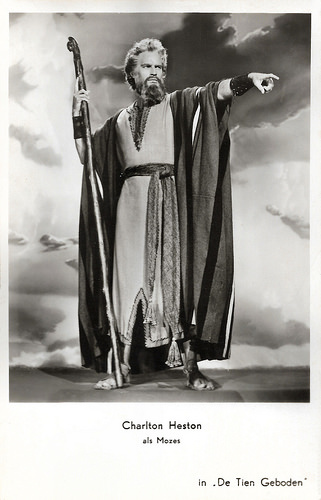
Dutch postcard by Gebr. Spanjersberg N.V., Rotterdam, no. 5183. Photo: Paramount. Publicity still for The Ten Commandments (Cecil B. DeMille, 1956) with Charlton Heston as Moses. Moses' robe was hand-woven by Dorothea Hulse, one of the world's finest weavers. She also created costumes for The Robe (Henry Koster, 1953), as well as textiles and costume fabrics for Samson and Delilah (Cecil B. DeMille, 1949), David and Bathsheba (Henry King, 1951), and other films.
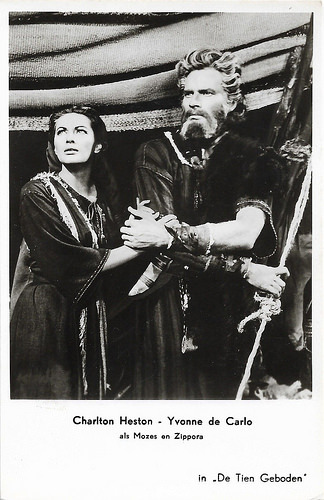
Dutch postcard by Gebr. Spanjersberg N.V., Rotterdam, no. 5184. Photo: Charlton Heston and Yvonne De Carlo in The Ten Commandments (Cecil B. DeMille, 1956), released in Dutch as De Tien Geboden.
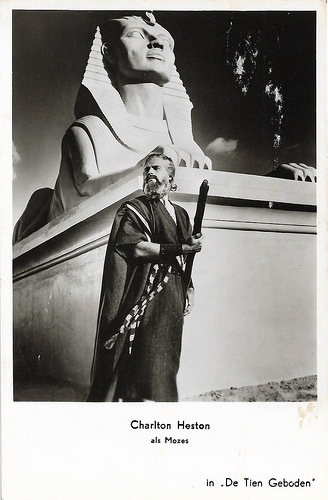
Dutch postcard by Gebr. Spanjersberg N.V., Rotterdam, no. 5185. Photo: Charlton Heston as Moses in The Ten Commandments (Cecil B. DeMille, 1956), released in Dutch as De Tien Geboden.
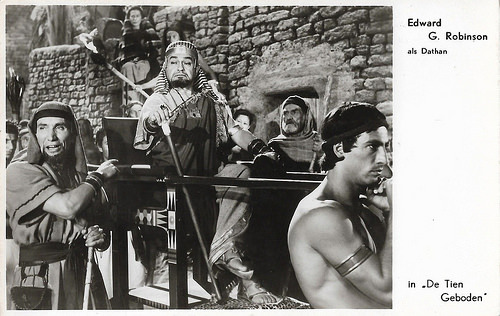
Dutch postcard by Gebr. Spanjersberg N.V., Rotterdam, no. 5187. Photo: Edward G. Robinson as Dathan in The Ten Commandments (Cecil B. DeMille, 1956), released in Dutch as De Tien Geboden.
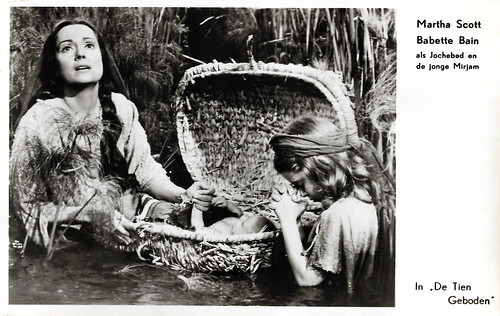
Dutch postcard by Gebr. Spanjersberg N.V., Rotterdam, no. 5190. Photo: Paramount. Martha Scott as Yochabel and Babette Bain as Little Miriam in The Ten Commandments (Cecil B. DeMille, 1956).
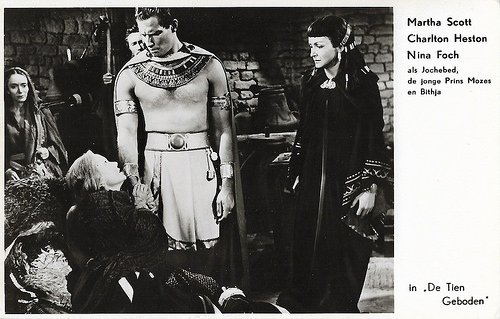
Dutch postcard by Gebr. Spanjersberg N.V., Rotterdam, no. 5193. Photo: Charlton Heston , Nina Foch, and Martha Scott in The Ten Commandments (Cecil B. DeMille, 1956), released in Dutch as De Tien Geboden.
Trailer The Ten Commandments (1956). Source: YouTube Trailers (YouTube).
Sources: Hal Erickson (AllMovie), John Preston (The Telegraph), Alex von Tunzelmann (The Guardian), Wikipedia, and IMDb.

French postcard by Editions P.I., Paris, no. 830. Offered by Les Carbones Korès "Carboplane". Photo: Paramount. Publicity still for The Ten Commandments (Cecil B. DeMille, 1956).

French postcard by Editions P.I., Paris, no. 831. Photo: Paramount. Publicity still for The Ten Commandments (Cecil B. DeMille, 1956). For his pursuit of the Israelites, Yul Brynner in his role as Rameses II wears the blue Khepresh helmet crown, which the pharaohs wore for battle.

Belgian postcard by Papeterie, Bruxelles no. 3847. Photo: Paramount. Charlton Heston in The Ten Commandments (Cecil B. DeMille, 1956).

Dutch postcard by Uitg. Takken, no. AX 3871. Photo: Paramount. Publicity still for The Ten Commandments (Cecil B. DeMille, 1956).

Dutch postcard by Uitg. Takken, no. AX 3881. Photo: Paramount. Publicity still for The Ten Commandments (Cecil B. DeMille, 1956) with Charlton Heston , Yul Brynner , Sir Cedric Hardwicke and Anne Baxter.

French postcard in the Entr'acte series by Éditions Asphodèle. Mâcon, no. 004/2. Photo: Collection B. Courtel / D.R. Cecil B. DeMille and Yul Brynner on the set of The Ten Commandments (Cecil B. DeMille, 1955). Caption: Yul Brynner, film actor and photo enthusiast, takes a break to photograph director Cecil B. DeMille.
Put on Earth to do God’s will
Based on the Holy Scriptures, with additional dialogue by several other hands, The Ten Commandments (Cecil B. DeMille, 1956) tells the story of Moses, leader of the Hebrews, considered to have been a prophet by Jews, Christians and Muslims. He is thought to have lived in Egypt, in or around the 14th century BC.
The older he became, the more Cecil B. DeMille was convinced that he had been put on Earth to do God’s will. He decided to remake The Ten Commandments, in response, he claimed, to scores of imploring letters: “The world needs a reminder, they said, of the Law of God.”
Charlton Heston , who had previously worked with DeMille in The Greatest Show on Earth (Cecil B. DeMille, 1952), won the part of Moses after he impressed DeMille at his audition with his knowledge of ancient Egypt. The film follows Moses from the time he was discovered in the bull rushes as an infant by the Pharaoh's daughter, to his long, hard struggle to free the Hebrews from their slavery at the hands of the Egyptians.
Heston was also chosen to be the voice of God in the form of a burning bush, toned down to a softer and lower register. As soon as Heston announced to DeMille that his wife Lydia was pregnant, Heston's newborn son, Fraser (1955), was cast by DeMille. Fraser Heston was three months old during filming.
Edward G. Robinson was cast as Dathan, Yvonne De Carlo as Sephora, Debra Paget as Lilia, and John Derek as Joshua. The film features Sir Cedric Hardwicke as Sethi, Nina Foch as Bithiah, Martha Scott as Yoshebel, Judith Anderson as Memnet, and Vincent Price as Baka. For the large crowd shots, at least 14,000 extras and 15,000 animals were used.

Spanish card, 2004. Photo: Paramount. Charlton Heston and Yvonne De Carlo in The Ten Commandments (Cecil B. DeMille, 1956).

Spanish card, 2004. Photo: Paramount. Charlton Heston and Anne Baxter in The Ten Commandments (Cecil B. DeMille, 1956).

Spanish card, 2004. Photo: Paramount. Charlton Heston in The Ten Commandments (Cecil B. DeMille, 1956).

Spanish card, 2004. Photo: Paramount. Charlton Heston in The Ten Commandments (Cecil B. DeMille, 1956).

Spanish card, 2004. Photo: Paramount. Charlton Heston , Anne Baxter and Ian Keith in The Ten Commandments (Cecil B. DeMille, 1956).

Spanish card, 2004. Photo: Paramount. Charlton Heston and Yul Brynner in The Ten Commandments (Cecil B. DeMille, 1956).

Spanish card, 2004. Photo: Paramount. Charlton Heston in The Ten Commandments (Cecil B. DeMille, 1956).

Spanish card, 2004. Photo: Paramount. Charlton Heston in The Ten Commandments (Cecil B. DeMille, 1956).
The most eventful 219 minutes ever recorded
In 1957, The Ten Commandments was nominated for seven Oscars, including Best Picture. John P. Fulton, head of the special effects department at Paramount, won the Academy Award for his effects. Fulton’s effects included the building of Sethi’s Jubilee treasure city, the Burning Bush, the fiery hail from a cloudless sky, the Angel of Death, the composites of the Exodus, the Pillar of Fire, the giving of the Ten Commandments, and the highlight, the parting of the Red Sea.
The production, at the time incredibly expensive with a budget of $13 million, grossed $122.7 million at the box office. It was re-released in 1966 and 1972, and one more time in 1989. The liberties taken with the biblical story of Exodus nor its nearly four-hour length has had any effect on its popularity. According to Guinness World Records, in terms of theatrical exhibition, The Ten Commandments (1956) is the seventh most successful film of all time when the box office gross is adjusted for inflation.
During production, DeMille had customarily spread out prints of paintings by Lawrence Alma-Tadema to inform his set designers of the look he wanted to achieve. However, in terms of accuracy about Moses and his time, The Ten Commandments is patchy. Alex von Tunzelmann in The Guardian: “It's amazing how much the fashions of New Kingdom Egypt seem to resemble those of 1956. DeMille can just about be forgiven for the makeup because ancient Egyptians did indeed paint their eyelids, lips and nails, but he is pushing it by dressing dancing girls in fluorescent green bikinis. At least the spectacular scenes filmed on location in Egypt and Sinai, with thousands of extras, lend the whole thing a sense of authenticity.”
Hal Erickson at AllMovie : “DeMille's The Ten Commandments may not be the most subtle and sophisticated entertainment ever concocted, but it tells its story with a clarity and vitality that few Biblical scholars have ever been able to duplicate. It is very likely the most eventful 219 minutes ever recorded to film - and who's to say that Nefertiri (Anne Baxter) didn't make speeches like, "Oh, Moses, Moses, you splendid, stubborn, adorable fool"?”
During the production in Egypt, Cecil B. DeMille had a colossal heart attack. The doctor insisted that he spend the next two weeks flat on his back in an oxygen tent, and then recuperate for several weeks after that. Typically, DeMille took no notice and was back at work the next morning. He finished filming The Ten Commandments on the day after his 74th birthday. But although he lived for another five years, his health never recovered. On 20 January 1959, his doctor paid him a visit and suggested he should go straight to the hospital. “No,” DeMille told him. “I think I’ll go to the morgue instead.” He died the next day.

Dutch postcard by Gebr. Spanjersberg N.V., Rotterdam, no. 5183. Photo: Paramount. Publicity still for The Ten Commandments (Cecil B. DeMille, 1956) with Charlton Heston as Moses. Moses' robe was hand-woven by Dorothea Hulse, one of the world's finest weavers. She also created costumes for The Robe (Henry Koster, 1953), as well as textiles and costume fabrics for Samson and Delilah (Cecil B. DeMille, 1949), David and Bathsheba (Henry King, 1951), and other films.

Dutch postcard by Gebr. Spanjersberg N.V., Rotterdam, no. 5184. Photo: Charlton Heston and Yvonne De Carlo in The Ten Commandments (Cecil B. DeMille, 1956), released in Dutch as De Tien Geboden.

Dutch postcard by Gebr. Spanjersberg N.V., Rotterdam, no. 5185. Photo: Charlton Heston as Moses in The Ten Commandments (Cecil B. DeMille, 1956), released in Dutch as De Tien Geboden.

Dutch postcard by Gebr. Spanjersberg N.V., Rotterdam, no. 5187. Photo: Edward G. Robinson as Dathan in The Ten Commandments (Cecil B. DeMille, 1956), released in Dutch as De Tien Geboden.

Dutch postcard by Gebr. Spanjersberg N.V., Rotterdam, no. 5190. Photo: Paramount. Martha Scott as Yochabel and Babette Bain as Little Miriam in The Ten Commandments (Cecil B. DeMille, 1956).

Dutch postcard by Gebr. Spanjersberg N.V., Rotterdam, no. 5193. Photo: Charlton Heston , Nina Foch, and Martha Scott in The Ten Commandments (Cecil B. DeMille, 1956), released in Dutch as De Tien Geboden.
Trailer The Ten Commandments (1956). Source: YouTube Trailers (YouTube).
Sources: Hal Erickson (AllMovie), John Preston (The Telegraph), Alex von Tunzelmann (The Guardian), Wikipedia, and IMDb.
Published on March 01, 2023 22:00
February 28, 2023
Jutta Hoffmann
German actress Jutta Hoffmann (1941) has appeared in more than 40 films and television shows since 1961. She was one of the best-known actresses in the GDR from the end of the 1960s and has been one of the most important actresses in the German-speaking world since the beginning of the 1980s.
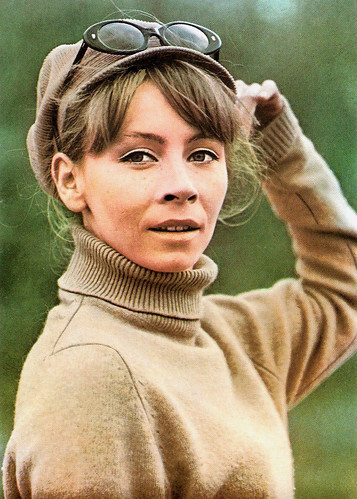
East-German postcard in the Progress Starfoto series by VEB Progress Film-Vertrieb, Berlin, no. 4 / F / 72. Photo: Schwarz / DEFA.
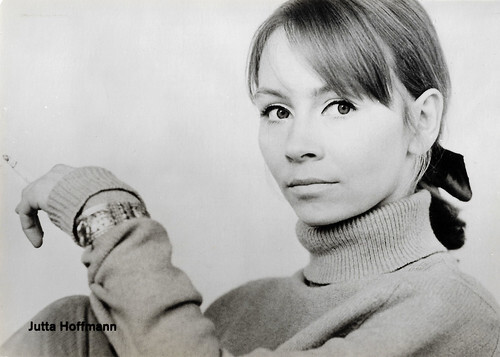
East German postcard by VEB Progress Film-Verlag, Berlin, no. 1928, 1963. Photo: DEFA / Werner Bergmann.
Banned by the GDR censors
Jutta Hoffmann was born in 1941 in Halle an der Saale, Deutschland. She was the first child of Alice and Erich Hoffmann and has a sister, Sabine, who is three years younger. While still at school in Schkopau, she appeared in the amateur drama group of the Buna-Werke in Schkopau.
After graduating from high school in Merseburg, she studied at the film academy in Potsdam-Babelsberg from 1959 to 1962. She joined the ensemble of the Maxim Gorki Theatre after completing her training. From 1965 to 1967 she was a member of the ensemble of the Deutsches Theater, and in 1973 she went to the Berliner Ensemble.
In addition to her dominant theatre work, she repeatedly appeared in front of the camera for cinema and television productions. In 1961 Hoffmann made her film debut as Katrin in the feature film Das Rabauken-Kabarett/Rough's Neck's Show (Werner W. Wallroth, 1961) with Horst Jonischkan. She played the professor's daughter Penny in Frank Vogel's Julia lebt/Julia lives (1963) and as Lämmchen in the television film Kleiner Mann - was nun?/Little man - what now? (Hans-Joachim Kasprzik, 1967).
Both the films Denk bloß nicht, dass ich heule/Just Don't Think I'll Cry (Frank Vogel, 1966) and Die Karla/Karla (Herrmann Zschoche, 1966) were banned by the GDR censors in 1966. They could only be seen after the fall of the Berlin Wall. In 1972, she was awarded the actor's prize for the leading role in Der Dritte/Her Third (Egon Günther, 1972) with Armin Mueller-Stahl. She played the single mother Margit looking for a new partner. Der Dritte won two National Prizes and was screened at the Venice Film Festival in 1972, where Jutta Hoffmann won an award for Best Actor in the category Venezia Critici.
Günther also directed her in the two-part Arnold Zweig adaptation Junge Frau von 1914/Young woman from 1914 (1970), the Thomas Mann adaptation Lotte in Weimar (Egon Günther, 1974), in which her gossipy Adele Schopenhauer was wonderful, and Der Schlüssel/The Key (1974). She also appeared in Das Versteck/The Hiding Place (Hermann Zscoche, 1977) with Manfred Krug . In 1979 she played for the last time for the DEFA in the Indian film Blauvogel/Blue Bird (Ulrich Weiss, 1979). Hoffmann left the GDR in 1983.
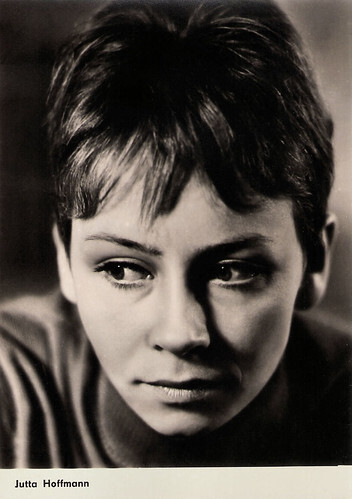
East German postcard by VEB Progress Film-Verlag, Berlin, no. 2121, 1964. Photo: Klaus Fischer.
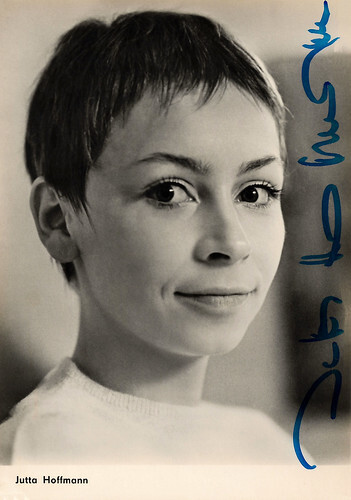
East German postcard by VEB Progress Film-Verlag, Berlin, no. 2228, 1965. Photo: Hirschfeld.
A wonderfully loose and forceful role
In the mid-1980s, Jutta Hoffmann was seen more and more often on West German stages such as the Münchner Kammerspiele and the Deutsches Schauspielhaus in Hamburg. At the end of the 1980s, she took up a professorship at the Hamburg Academy of Music and Theatre.
She also continued to star in films. Alexander Kluge directed her in the West German film Der Angriff der Gegenwart auf die übrige Zeit/The Assault of the Present on the Rest of Time (Alexander Kluge, 1985).
She played a wonderfully loose and forceful role in the brash women's prison and gangster musical Bandits (Katja von Garnier, 1989) alongside Katja Riemann . From 1998 to 2002, Jutta Hoffmann also appeared as Inspector Wanda Rosenbaum on television in the successful crime series Polizeiruf 110/Police Call 110.
In 2005, Hoffmann was honoured by the DEFA Foundation for her services to German film. On the occasion of her 70th birthday, the Filmmuseum Potsdam dedicated an exhibition to her. Since 2011, Hoffmann has had a star on the Boulevard of Stars in Berlin.
Hoffmann was married in her first marriage to the director Herrmann Zschoche and is married in her second marriage to the Austrian actor and director Nikolaus Haenel, with whom she has two children. The rapper Haiyti is her granddaughter. Jutta Hoffmann lives in Potsdam.
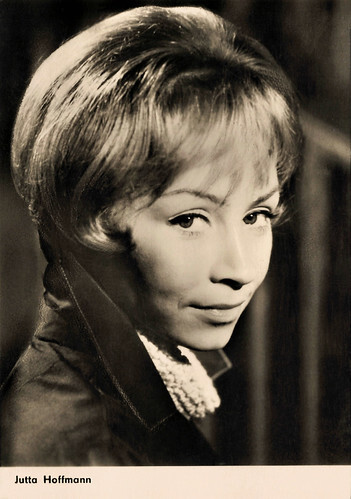
East German postcard by VEB Progress Film-Verlag, Berlin, no. 1928, 1963. Photo: DEFA / Werner Bergmann.
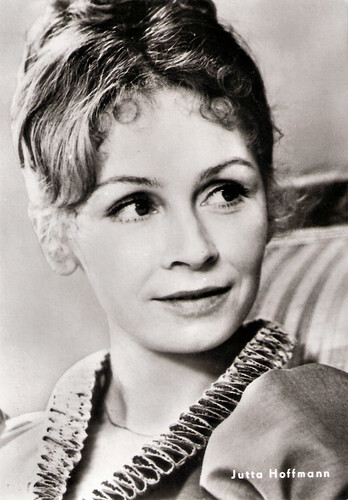
East-German postcard in the Progress Starfoto series by VEB Progress Film-Verleih, Berlin, no. 48/75. Photo: Ebert.
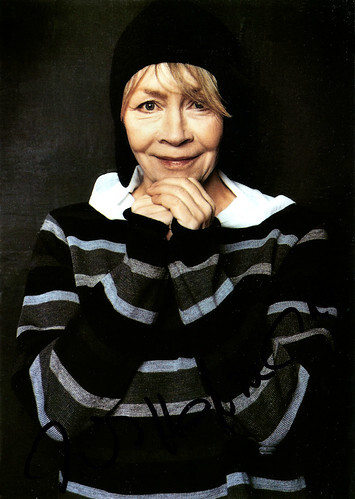
German postcard by Rüdel Verlag, Hamburg. Photo: Mathias Bothor.
Sources: Prisma (German), Wikipedia (German and English), and .

East-German postcard in the Progress Starfoto series by VEB Progress Film-Vertrieb, Berlin, no. 4 / F / 72. Photo: Schwarz / DEFA.

East German postcard by VEB Progress Film-Verlag, Berlin, no. 1928, 1963. Photo: DEFA / Werner Bergmann.
Banned by the GDR censors
Jutta Hoffmann was born in 1941 in Halle an der Saale, Deutschland. She was the first child of Alice and Erich Hoffmann and has a sister, Sabine, who is three years younger. While still at school in Schkopau, she appeared in the amateur drama group of the Buna-Werke in Schkopau.
After graduating from high school in Merseburg, she studied at the film academy in Potsdam-Babelsberg from 1959 to 1962. She joined the ensemble of the Maxim Gorki Theatre after completing her training. From 1965 to 1967 she was a member of the ensemble of the Deutsches Theater, and in 1973 she went to the Berliner Ensemble.
In addition to her dominant theatre work, she repeatedly appeared in front of the camera for cinema and television productions. In 1961 Hoffmann made her film debut as Katrin in the feature film Das Rabauken-Kabarett/Rough's Neck's Show (Werner W. Wallroth, 1961) with Horst Jonischkan. She played the professor's daughter Penny in Frank Vogel's Julia lebt/Julia lives (1963) and as Lämmchen in the television film Kleiner Mann - was nun?/Little man - what now? (Hans-Joachim Kasprzik, 1967).
Both the films Denk bloß nicht, dass ich heule/Just Don't Think I'll Cry (Frank Vogel, 1966) and Die Karla/Karla (Herrmann Zschoche, 1966) were banned by the GDR censors in 1966. They could only be seen after the fall of the Berlin Wall. In 1972, she was awarded the actor's prize for the leading role in Der Dritte/Her Third (Egon Günther, 1972) with Armin Mueller-Stahl. She played the single mother Margit looking for a new partner. Der Dritte won two National Prizes and was screened at the Venice Film Festival in 1972, where Jutta Hoffmann won an award for Best Actor in the category Venezia Critici.
Günther also directed her in the two-part Arnold Zweig adaptation Junge Frau von 1914/Young woman from 1914 (1970), the Thomas Mann adaptation Lotte in Weimar (Egon Günther, 1974), in which her gossipy Adele Schopenhauer was wonderful, and Der Schlüssel/The Key (1974). She also appeared in Das Versteck/The Hiding Place (Hermann Zscoche, 1977) with Manfred Krug . In 1979 she played for the last time for the DEFA in the Indian film Blauvogel/Blue Bird (Ulrich Weiss, 1979). Hoffmann left the GDR in 1983.

East German postcard by VEB Progress Film-Verlag, Berlin, no. 2121, 1964. Photo: Klaus Fischer.

East German postcard by VEB Progress Film-Verlag, Berlin, no. 2228, 1965. Photo: Hirschfeld.
A wonderfully loose and forceful role
In the mid-1980s, Jutta Hoffmann was seen more and more often on West German stages such as the Münchner Kammerspiele and the Deutsches Schauspielhaus in Hamburg. At the end of the 1980s, she took up a professorship at the Hamburg Academy of Music and Theatre.
She also continued to star in films. Alexander Kluge directed her in the West German film Der Angriff der Gegenwart auf die übrige Zeit/The Assault of the Present on the Rest of Time (Alexander Kluge, 1985).
She played a wonderfully loose and forceful role in the brash women's prison and gangster musical Bandits (Katja von Garnier, 1989) alongside Katja Riemann . From 1998 to 2002, Jutta Hoffmann also appeared as Inspector Wanda Rosenbaum on television in the successful crime series Polizeiruf 110/Police Call 110.
In 2005, Hoffmann was honoured by the DEFA Foundation for her services to German film. On the occasion of her 70th birthday, the Filmmuseum Potsdam dedicated an exhibition to her. Since 2011, Hoffmann has had a star on the Boulevard of Stars in Berlin.
Hoffmann was married in her first marriage to the director Herrmann Zschoche and is married in her second marriage to the Austrian actor and director Nikolaus Haenel, with whom she has two children. The rapper Haiyti is her granddaughter. Jutta Hoffmann lives in Potsdam.

East German postcard by VEB Progress Film-Verlag, Berlin, no. 1928, 1963. Photo: DEFA / Werner Bergmann.

East-German postcard in the Progress Starfoto series by VEB Progress Film-Verleih, Berlin, no. 48/75. Photo: Ebert.

German postcard by Rüdel Verlag, Hamburg. Photo: Mathias Bothor.
Sources: Prisma (German), Wikipedia (German and English), and .
Published on February 28, 2023 22:00
February 26, 2023
Else Eckersberg
Else Eckersberg (1895-1989) was an actress in Max Reinhardt's theatre. She also had a film career in German silent film in the 1910s.
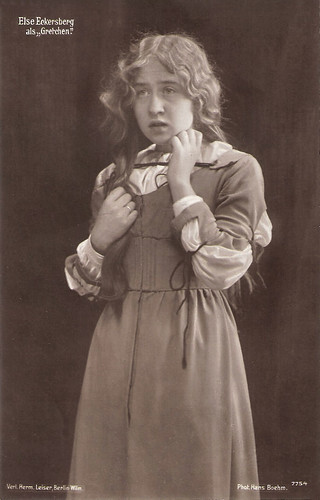
German postcard by Verlag Hermann Leiser, Berlin-Wilm.no. 7754. Photo: Hans Boehm, Berlin. Else Eckersberg as Gretchen in Goethe's 'Faust' (1913).
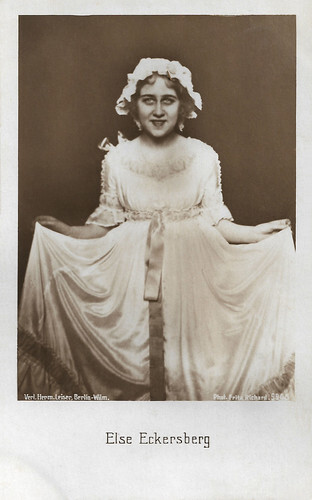
German postcard byVerlag Hermann Leiser, Berlin-Wilm., no. 9945. Photo: Fritz Richard.
The youngest member of Max Reinhardt's ensemble
Else Eckersberg was born in 1895 in Berlin as the daughter of Paul Eckersberg and Antonie, née Tessel. After the early death of her father, she grew up with her grandparents and in the boarding school of the Ursulines.
In her first marriage, Else Eckersberg married the lawyer Walther Eitzen in 1913. After her divorce in 1918, she married Philipp Freiherr Schey von Koromla in Berlin in 1921, from whom she divorced in 1935. In her third marriage, she married Paul Graf Yorck von Wartenburg in 1940 in Berlin. Her only child was Alexander (1927-2012) from her second marriage, who was adopted by his stepfather in 1950.
After completing her secondary education, Else Eckersberg entered the acting school of the Deutsches Theater under the direction of Max Reinhardt at the age of 15. After two years of training, she was the only girl accepted for further training alongside Gert Fricke, Friedrich Wilhelm Murnau , Ernst Waldow, Ernst Lubitsch and Ernst Hofmann .
In a private performance of Frank Wedekind's 'Tod und Teufel' (Death and the Devil), Else was discovered in 1912 in the role of the strumpet Lisiska and engaged by Max Reinhardt as the youngest member of his ensemble.
On 31 August 1912, she made her debut at the Deutsches Theater as Klugheit in Goethe's 'Faust II'. Under Reinhardt's direction, she also ventured an early foray into silent film, shooting Eine Venezianische Nacht/A Venetian Night (Max Reinhardt, 1914) with Maria Carmi and Alfred Abel .
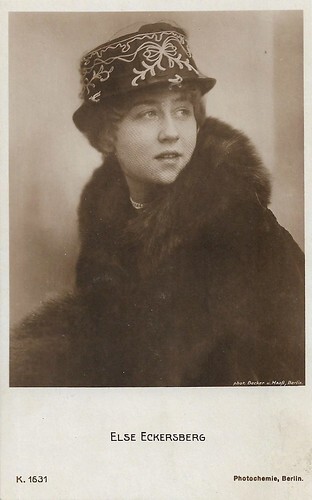
German postcard by Photochemie, Berlin, no. K. 1631. Photo: Becker & Maass., Berlin.
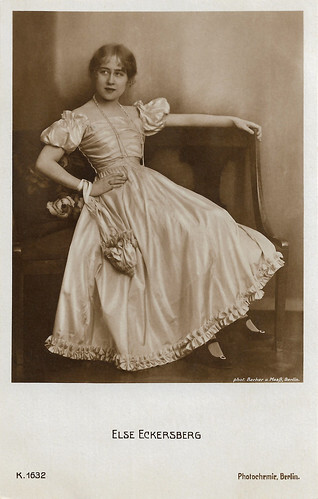
German postcard by Photochemie, Berlin, no. K. 1632. Photo: Becker & Maass, Berlin.
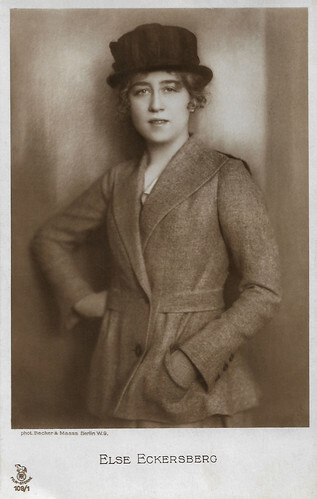
German postcard in the Film Sterne series by Rotophot, no. 109/1. Photo: Becker & Maass, Berlin.
Glamorous, slightly capricious, fun-loving and humorous roles
German Wikipedia downplays Else Eckersberg's film career but she still played in 20 films between 1914 and 1921. In 1914 she started at Union / PAGU, in a range of 9 comedies of 1914-1915 in which she was paired with Ernst Matray , and in which at times also e.g. Anna Müller-Lincke and Senta Söneland performed. These were mostly directed by Richard Löwenbein, e.g. Die Erbtante/The Inherited Aunt (Richard Löwenbein, 1914), Eine Lausbubengeschichte/A lousy boy's story (N.N., 1915), and Die bösen Buben/The bad boys (Richard Löwenbein, 1915).
In 1916 she created her own comedy series at Greenbaum-Film with the character Else, e.g. Elses letzter Hauslehrer/Else's last tutor (Paul Otto, 1917) with Curt Vespermann , Else als Detektiv/Else as a detective (Louis Neher, 1917), and Else und ihr Vetter/Else and her cousin (Louis Neher, 1917) with Wilhelm Diegelmann and Julius Falkenstein . After an absence from the sets, Eckersberg returned in 1920-1921 for three more Else-comedies, now at Althoff & Co., Else, der Räuberbrau/Else, the Robber Bride (Rudi Bach, 1920) with Fritz Kampers, Else, die Tochter der Exzellenz/Else, the daughter of the Excellency (Rudi Bach, 1920) and Prinzesschen Else/Little Princess Else (Rudi Bach, 1921).
Else Eckersberg also played supporting parts in the Fyodor Dostoevsky adaptation Die Brüder Karamasoff/The Brothers Karamazov (Carl Froehlich, Dimitri Buchowetzki, 1920) and Lupu Pick's Der Dummkopf/The Fool (1921) with Max Adalbert. After 1921, Eckersberg worked almost exclusively at the theatre where she shone mainly in glamorous, slightly capricious, fun-loving and humorous roles of women and girls.
After a guest performance in operetta, Else Eckersberg's breakthrough came in 1920 in the role of Cleopatra in G.B. Shaw's play 'Cäsar und Cleopatra' (Caesar and Cleopatra). Numerous engagements at theatres in Berlin and Vienna followed. With Reinhardt's departure from Berlin, Else Eckersberg also left the ensemble of the Deutsches Theater in 1921 and played mainly comedies at various entertainment theatres in the following years.
In 1924 she again enjoyed great success as Dodo in Hopwood's 'Unsere kleine Frau' at Reinhardt's Kammerspiele and as Antoinette Hechingen in Hugo von Hofmannsthal's 'Der Schwierige' at Vienna's Theater in der Josefstadt. In the early 1930s, Eckersberg's roles as Antoinette in Hofmannsthal's 'Der Schwierige', Christina in Bourdet's 'Das schwache Geschlecht' and Amanda in Noel Coward's 'Intimitäten' (Intimacies) earned her acclaim from Berlin theatre critics as a female comedienne of the first rank, a ravishing clown and witty parodist.
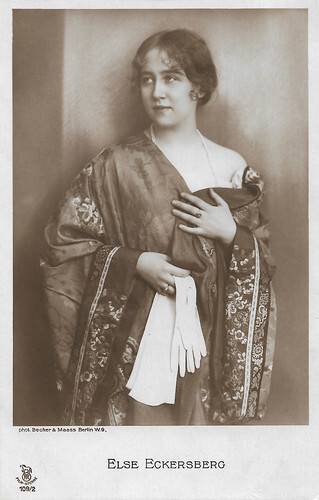
German postcard in the Film Sterne series by Rotophot, no. 109/2. Photo: Becker & Maass, Berlin.
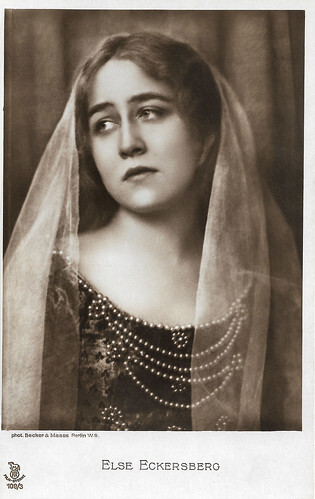
German postcard in the Film Sterne series by Rotophot, no. 109/3. Photo: Becker & Maass, Berlin.
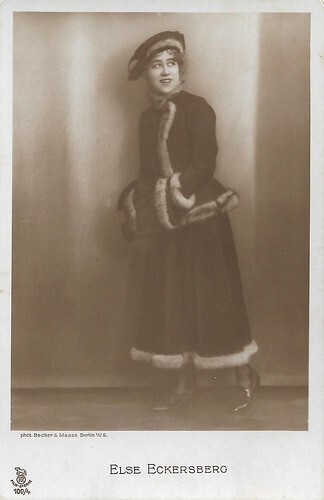
German postcard in the Film Sterne series by Rotophot, no. 109/4. Photo: Becker & Maass, Berlin.
Arrested and kept in solitary confinement for two months
In 1932, Else Eckersberg starred alongside Hans Brausewetter in her self-written play 'Three Years and a Night', which was staged by Eugen Robert, the director of the Berlin Tribüne under the title 'Stichwort Feldena'.
After the National Socialists seized power, Else Eckersberg withdrew more and more from the stage. The actually apolitical actress suffered from the fate of her Jewish colleagues and friends. In 1934 she played Noel Coward's 'Intimacies' again under Otto Falckenberg at the Munich Kammerspiele, in 1935 under Heinz Hilpert in Hauptmann's 'Griselda' and under Gustaf Gründgens , she played the Queen in Scribe's 'Das Glas Wasser'(The Glass of Water).
Else Eckersberg appeared the last time in front of the camera in Der Florentiner Hut/The Leghorn Hat (Wolfgang Liebeneiner, 1939) starring Heinz Rühmann . On the occasion of Gerhart Hauptmann's 80th birthday, Eckersberg, a close friend of the poet, recited 'Hannele's Ascension' for the first time. She performed this play several times after the Second World War and showed all her acting skills in the nuanced portrayal of the various characters.
In 1944, Else Eckersberg was arrested as the sister-in-law of Peter Graf Yorck von Wartenburg, who took part in the assassination attempt of 20 July and was kept in solitary confinement for two months. In 1958, Else Eckersberg published her memoirs under the title 'Diese volle Zeit' (This Full Time), in which she once again illuminated the lost glory of the era of Berlin theatre before the Second World War.
In the following years, Else Eckersberg lived in Lyon and Bucharest due to her husband's diplomatic activities and after his retirement in Neureichenau, where she died in 1989. She was buried in Jagsthausen in the tomb of the Barons of Berlichingen, ancestors of her husband on his mother's side.
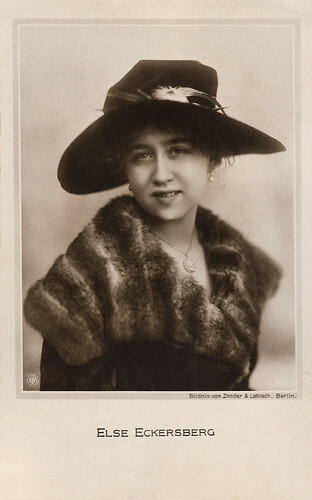
German postcard by NPG, no. 941. Photo: Zander & Labisch, Berlin.
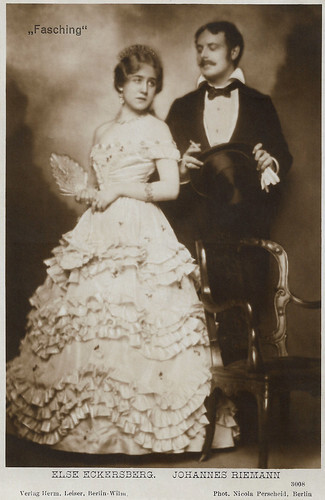
German postcard by Verlag Hermann Leiser, Berlin-Wilm., no. 3008. Photo: Nicola Perscheid. Else Eckersberg as countess Liszka and Johannes Riemann in the play 'Fasching' (Farsang; Fashions for Men) by Ferenc Molnar, directed by Max Reinhardt at the Deutsches Theater in 1917. Sent by mail in 1917.
Sources: Wikipedia (German), and .

German postcard by Verlag Hermann Leiser, Berlin-Wilm.no. 7754. Photo: Hans Boehm, Berlin. Else Eckersberg as Gretchen in Goethe's 'Faust' (1913).

German postcard byVerlag Hermann Leiser, Berlin-Wilm., no. 9945. Photo: Fritz Richard.
The youngest member of Max Reinhardt's ensemble
Else Eckersberg was born in 1895 in Berlin as the daughter of Paul Eckersberg and Antonie, née Tessel. After the early death of her father, she grew up with her grandparents and in the boarding school of the Ursulines.
In her first marriage, Else Eckersberg married the lawyer Walther Eitzen in 1913. After her divorce in 1918, she married Philipp Freiherr Schey von Koromla in Berlin in 1921, from whom she divorced in 1935. In her third marriage, she married Paul Graf Yorck von Wartenburg in 1940 in Berlin. Her only child was Alexander (1927-2012) from her second marriage, who was adopted by his stepfather in 1950.
After completing her secondary education, Else Eckersberg entered the acting school of the Deutsches Theater under the direction of Max Reinhardt at the age of 15. After two years of training, she was the only girl accepted for further training alongside Gert Fricke, Friedrich Wilhelm Murnau , Ernst Waldow, Ernst Lubitsch and Ernst Hofmann .
In a private performance of Frank Wedekind's 'Tod und Teufel' (Death and the Devil), Else was discovered in 1912 in the role of the strumpet Lisiska and engaged by Max Reinhardt as the youngest member of his ensemble.
On 31 August 1912, she made her debut at the Deutsches Theater as Klugheit in Goethe's 'Faust II'. Under Reinhardt's direction, she also ventured an early foray into silent film, shooting Eine Venezianische Nacht/A Venetian Night (Max Reinhardt, 1914) with Maria Carmi and Alfred Abel .

German postcard by Photochemie, Berlin, no. K. 1631. Photo: Becker & Maass., Berlin.

German postcard by Photochemie, Berlin, no. K. 1632. Photo: Becker & Maass, Berlin.

German postcard in the Film Sterne series by Rotophot, no. 109/1. Photo: Becker & Maass, Berlin.
Glamorous, slightly capricious, fun-loving and humorous roles
German Wikipedia downplays Else Eckersberg's film career but she still played in 20 films between 1914 and 1921. In 1914 she started at Union / PAGU, in a range of 9 comedies of 1914-1915 in which she was paired with Ernst Matray , and in which at times also e.g. Anna Müller-Lincke and Senta Söneland performed. These were mostly directed by Richard Löwenbein, e.g. Die Erbtante/The Inherited Aunt (Richard Löwenbein, 1914), Eine Lausbubengeschichte/A lousy boy's story (N.N., 1915), and Die bösen Buben/The bad boys (Richard Löwenbein, 1915).
In 1916 she created her own comedy series at Greenbaum-Film with the character Else, e.g. Elses letzter Hauslehrer/Else's last tutor (Paul Otto, 1917) with Curt Vespermann , Else als Detektiv/Else as a detective (Louis Neher, 1917), and Else und ihr Vetter/Else and her cousin (Louis Neher, 1917) with Wilhelm Diegelmann and Julius Falkenstein . After an absence from the sets, Eckersberg returned in 1920-1921 for three more Else-comedies, now at Althoff & Co., Else, der Räuberbrau/Else, the Robber Bride (Rudi Bach, 1920) with Fritz Kampers, Else, die Tochter der Exzellenz/Else, the daughter of the Excellency (Rudi Bach, 1920) and Prinzesschen Else/Little Princess Else (Rudi Bach, 1921).
Else Eckersberg also played supporting parts in the Fyodor Dostoevsky adaptation Die Brüder Karamasoff/The Brothers Karamazov (Carl Froehlich, Dimitri Buchowetzki, 1920) and Lupu Pick's Der Dummkopf/The Fool (1921) with Max Adalbert. After 1921, Eckersberg worked almost exclusively at the theatre where she shone mainly in glamorous, slightly capricious, fun-loving and humorous roles of women and girls.
After a guest performance in operetta, Else Eckersberg's breakthrough came in 1920 in the role of Cleopatra in G.B. Shaw's play 'Cäsar und Cleopatra' (Caesar and Cleopatra). Numerous engagements at theatres in Berlin and Vienna followed. With Reinhardt's departure from Berlin, Else Eckersberg also left the ensemble of the Deutsches Theater in 1921 and played mainly comedies at various entertainment theatres in the following years.
In 1924 she again enjoyed great success as Dodo in Hopwood's 'Unsere kleine Frau' at Reinhardt's Kammerspiele and as Antoinette Hechingen in Hugo von Hofmannsthal's 'Der Schwierige' at Vienna's Theater in der Josefstadt. In the early 1930s, Eckersberg's roles as Antoinette in Hofmannsthal's 'Der Schwierige', Christina in Bourdet's 'Das schwache Geschlecht' and Amanda in Noel Coward's 'Intimitäten' (Intimacies) earned her acclaim from Berlin theatre critics as a female comedienne of the first rank, a ravishing clown and witty parodist.

German postcard in the Film Sterne series by Rotophot, no. 109/2. Photo: Becker & Maass, Berlin.

German postcard in the Film Sterne series by Rotophot, no. 109/3. Photo: Becker & Maass, Berlin.

German postcard in the Film Sterne series by Rotophot, no. 109/4. Photo: Becker & Maass, Berlin.
Arrested and kept in solitary confinement for two months
In 1932, Else Eckersberg starred alongside Hans Brausewetter in her self-written play 'Three Years and a Night', which was staged by Eugen Robert, the director of the Berlin Tribüne under the title 'Stichwort Feldena'.
After the National Socialists seized power, Else Eckersberg withdrew more and more from the stage. The actually apolitical actress suffered from the fate of her Jewish colleagues and friends. In 1934 she played Noel Coward's 'Intimacies' again under Otto Falckenberg at the Munich Kammerspiele, in 1935 under Heinz Hilpert in Hauptmann's 'Griselda' and under Gustaf Gründgens , she played the Queen in Scribe's 'Das Glas Wasser'(The Glass of Water).
Else Eckersberg appeared the last time in front of the camera in Der Florentiner Hut/The Leghorn Hat (Wolfgang Liebeneiner, 1939) starring Heinz Rühmann . On the occasion of Gerhart Hauptmann's 80th birthday, Eckersberg, a close friend of the poet, recited 'Hannele's Ascension' for the first time. She performed this play several times after the Second World War and showed all her acting skills in the nuanced portrayal of the various characters.
In 1944, Else Eckersberg was arrested as the sister-in-law of Peter Graf Yorck von Wartenburg, who took part in the assassination attempt of 20 July and was kept in solitary confinement for two months. In 1958, Else Eckersberg published her memoirs under the title 'Diese volle Zeit' (This Full Time), in which she once again illuminated the lost glory of the era of Berlin theatre before the Second World War.
In the following years, Else Eckersberg lived in Lyon and Bucharest due to her husband's diplomatic activities and after his retirement in Neureichenau, where she died in 1989. She was buried in Jagsthausen in the tomb of the Barons of Berlichingen, ancestors of her husband on his mother's side.

German postcard by NPG, no. 941. Photo: Zander & Labisch, Berlin.

German postcard by Verlag Hermann Leiser, Berlin-Wilm., no. 3008. Photo: Nicola Perscheid. Else Eckersberg as countess Liszka and Johannes Riemann in the play 'Fasching' (Farsang; Fashions for Men) by Ferenc Molnar, directed by Max Reinhardt at the Deutsches Theater in 1917. Sent by mail in 1917.
Sources: Wikipedia (German), and .
Published on February 26, 2023 22:00
Paul van Yperen's Blog
- Paul van Yperen's profile
- 13 followers
Paul van Yperen isn't a Goodreads Author
(yet),
but they
do have a blog,
so here are some recent posts imported from
their feed.



